December 2024: Family Trip to Peru
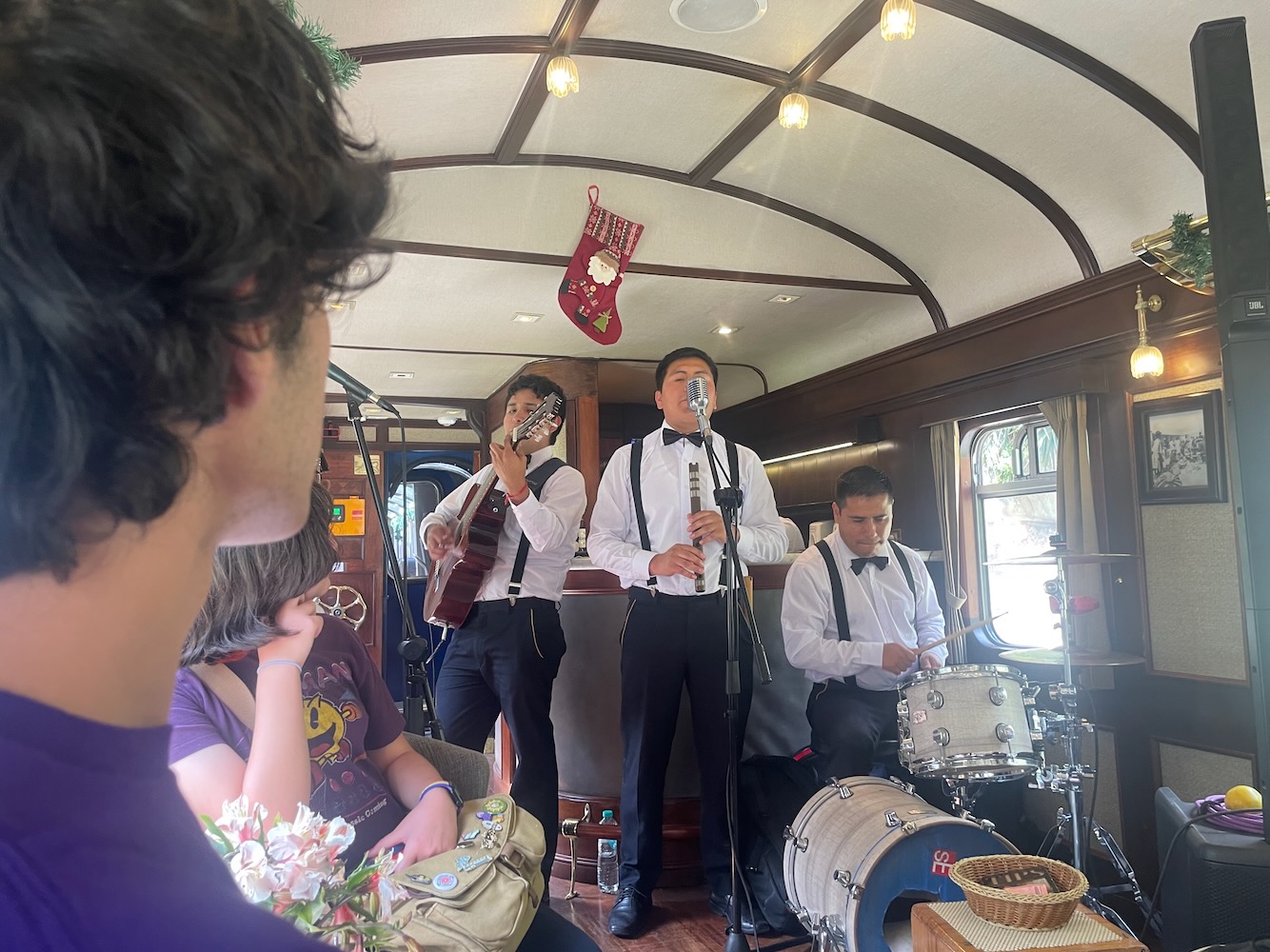
Finding our train was a little confusing, as the “station” was really just a spread-out series of alternately sunny and shaded pavement areas on the side of the platform, and it was unclear when our train would arrive or where exactly we should board. We finally made it onto the 1:27 Perurail Vistadome Observatory, where we had spacious seats at a table and enough empty space in our car that we could use the opposite table too. They served snack boxes of quinoa chips, quinoa bars (the same ones offered on the flight to Cusco), Peruvian chocolate, and hard candies, plus bottled water (we determined we didn’t like their brand and would stick, for the foreseeable future, to “our” brand, San Luis, which also happens to be a Coke brand—perhaps a holier Dasani). After about 30 minutes, they announced that entertainment would start in the observation car, so we all trooped over and found a seat.
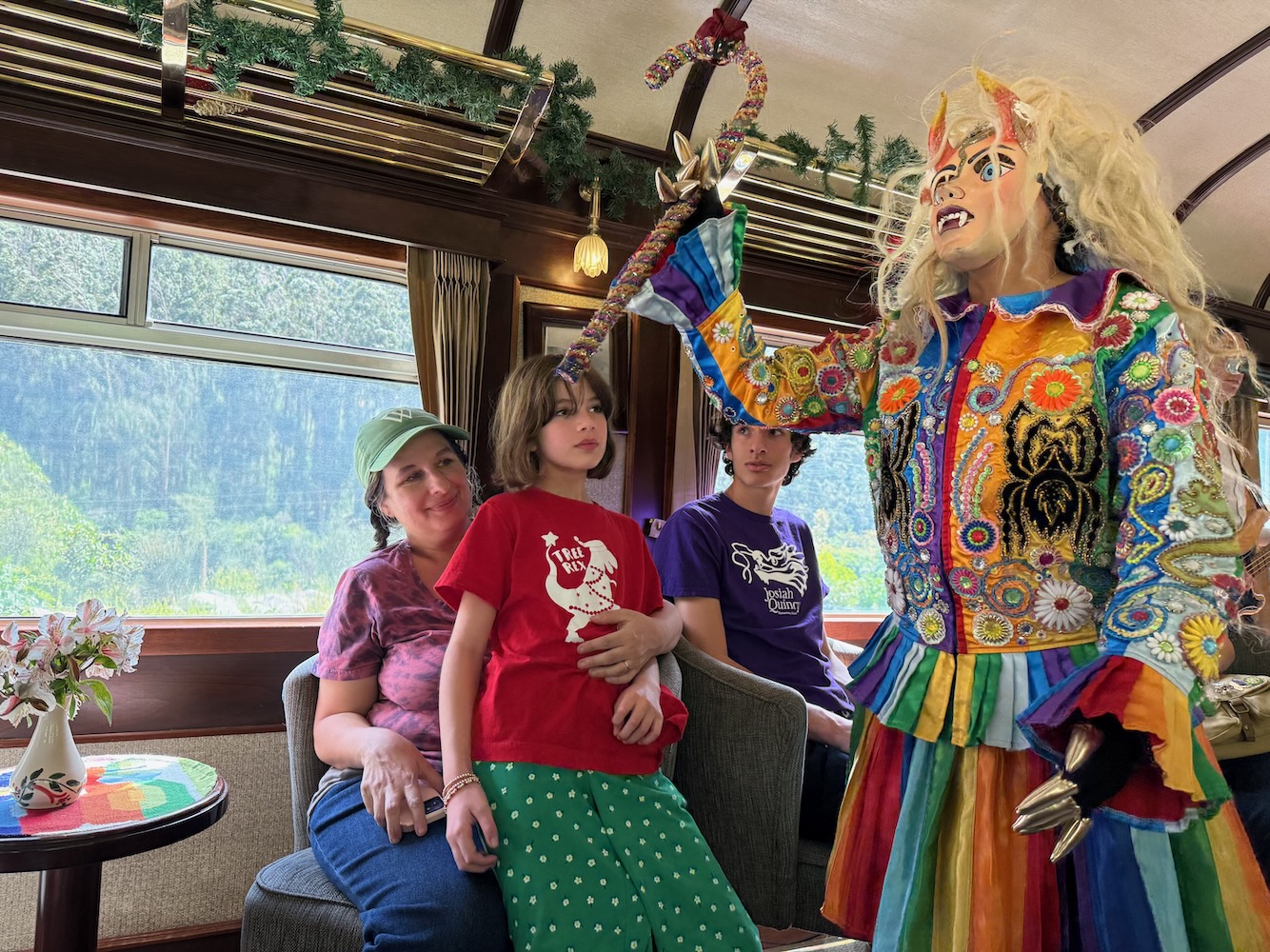
There was a band, who played various traditional instruments with an amplifier at top volume, and two traditional dancers in colorful dress and masks. Helen, and a number of other folks in the car, got up to dance with them, including Marcus and me briefly. Helen was entranced by the performance, and we stayed until the very end. Several times after that, Helen remarked on what a highlight it was for her.
The entire train ride was less than two hours, and when we reached Aguas Calientes (Machu Picchu Village) someone from our hotel, Hotel Sumaq, met us and walked down the hill with us. They had welcome drinks in the lobby, including hibiscus iced teas in champagne flutes for us and a pineapple, strawberry, and mango juice mixture in a smaller glass for Helen. Our room was lovely, with the same 3 kid beds (full this time) and 1 queen sized bed, but this time a tad cushier and fancier. There were nice fluffy bathrobes and slippers, including some in kids’ sizes for Helen, and the hotel provided unlimited glass jugs of delicious filtered water.
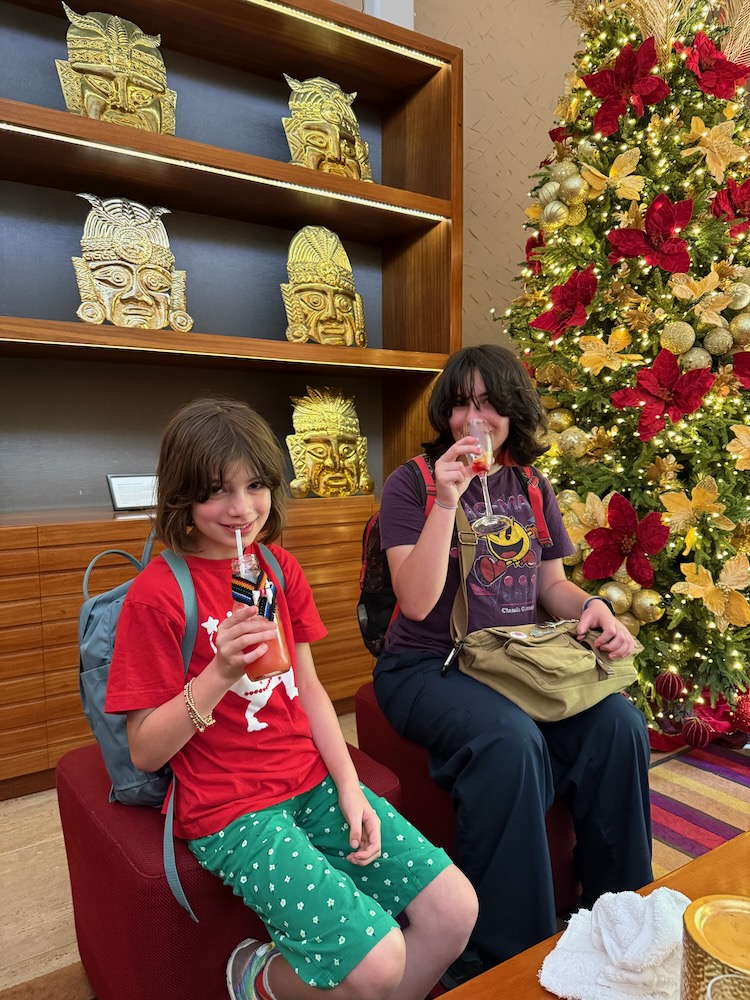
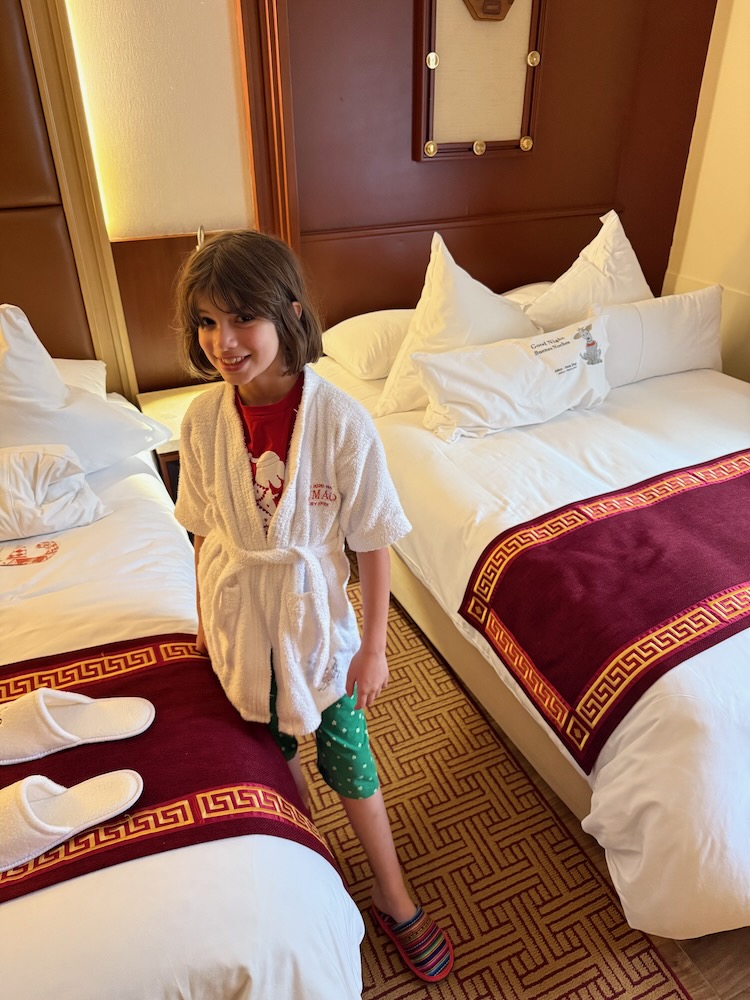
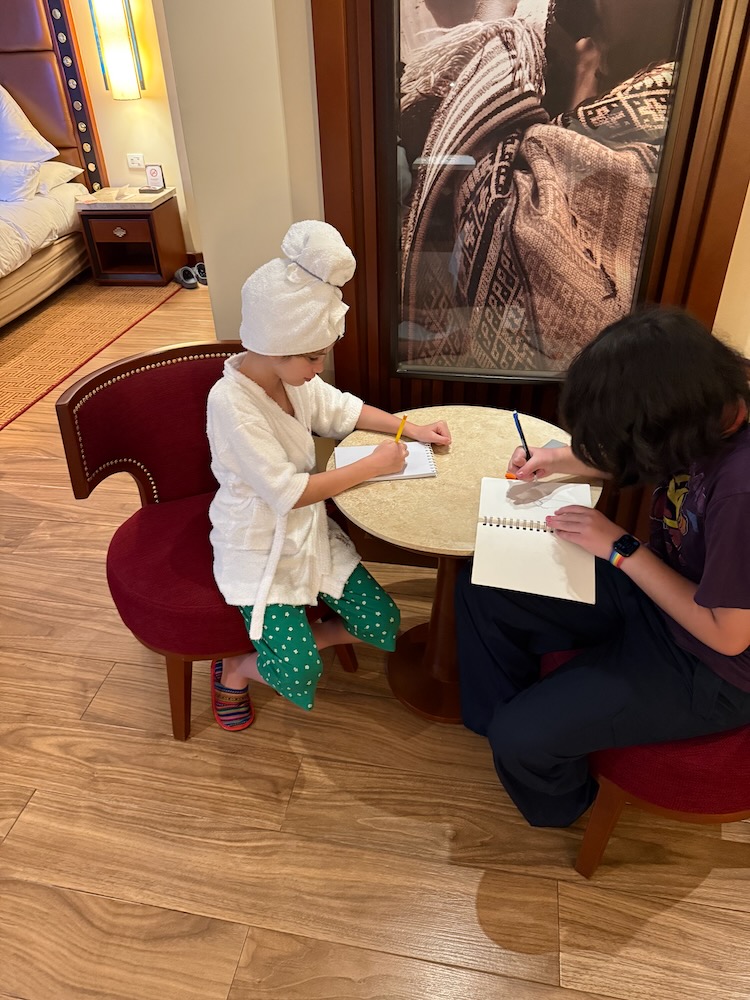
Helen took a nice bath in the tub, and all the kids lay down with their books for awhile. Robert and I meanwhile walked up into town and bought bus tickets for Machu Picchu for the morning, and also poked around and explored the market stalls and different shops.
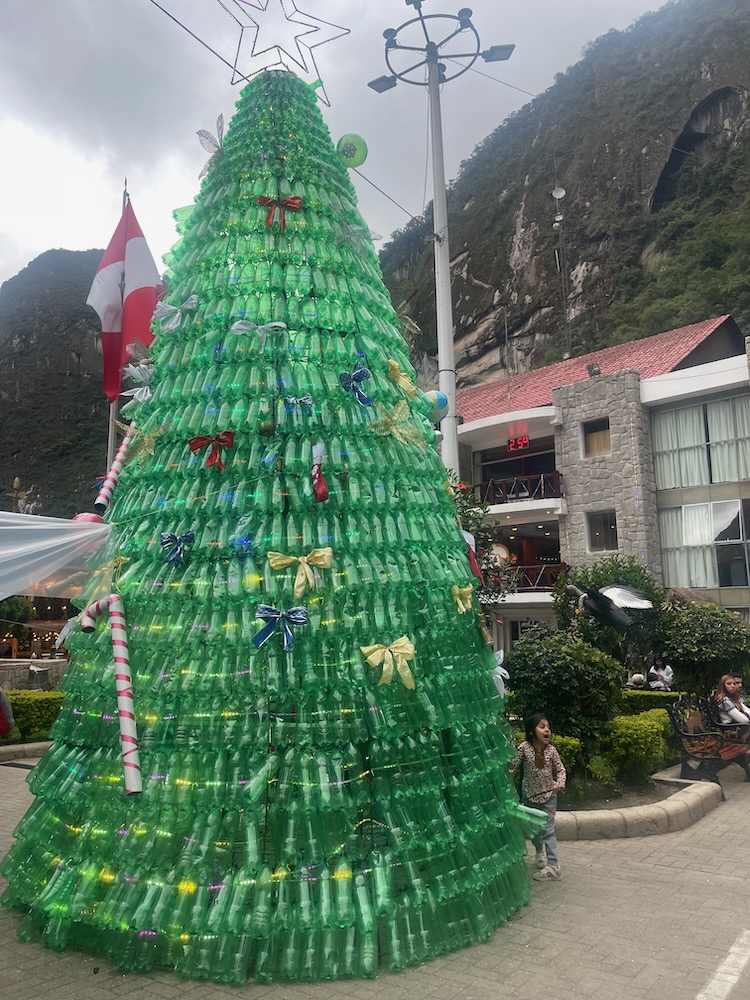
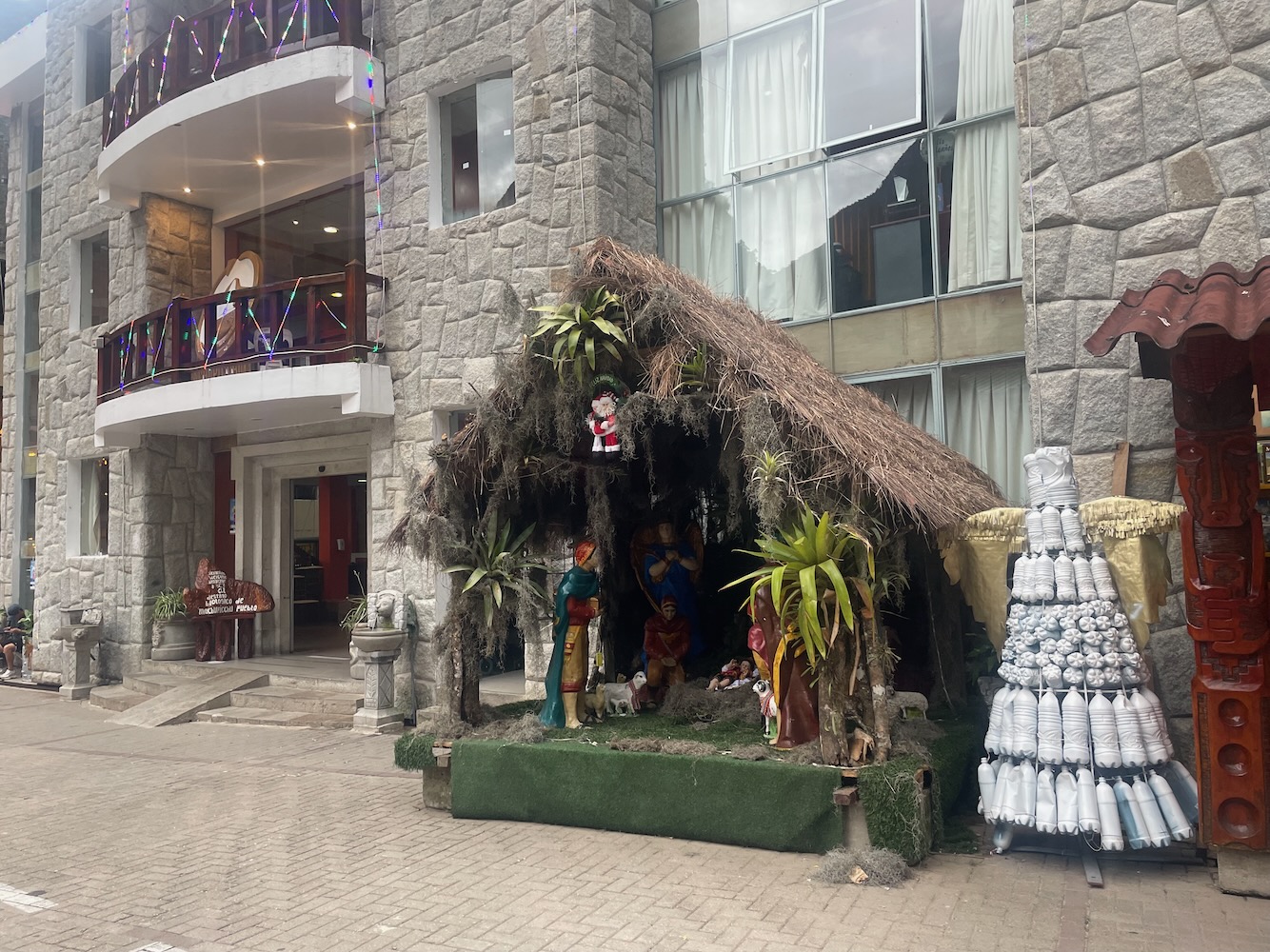
Back in the hotel, we collected our children and went to dinner (included, each night, with the room). Alpaca steaks, trout ceviche, ravioli of beef in a chimichurri sauce, and appetizers (including two versions of the Peruvian potato causa) and desserts all around! Two of the desserts had lucuma in them, an orange fruit new to us but which was described as having butterscotchy overtones to its flavor.
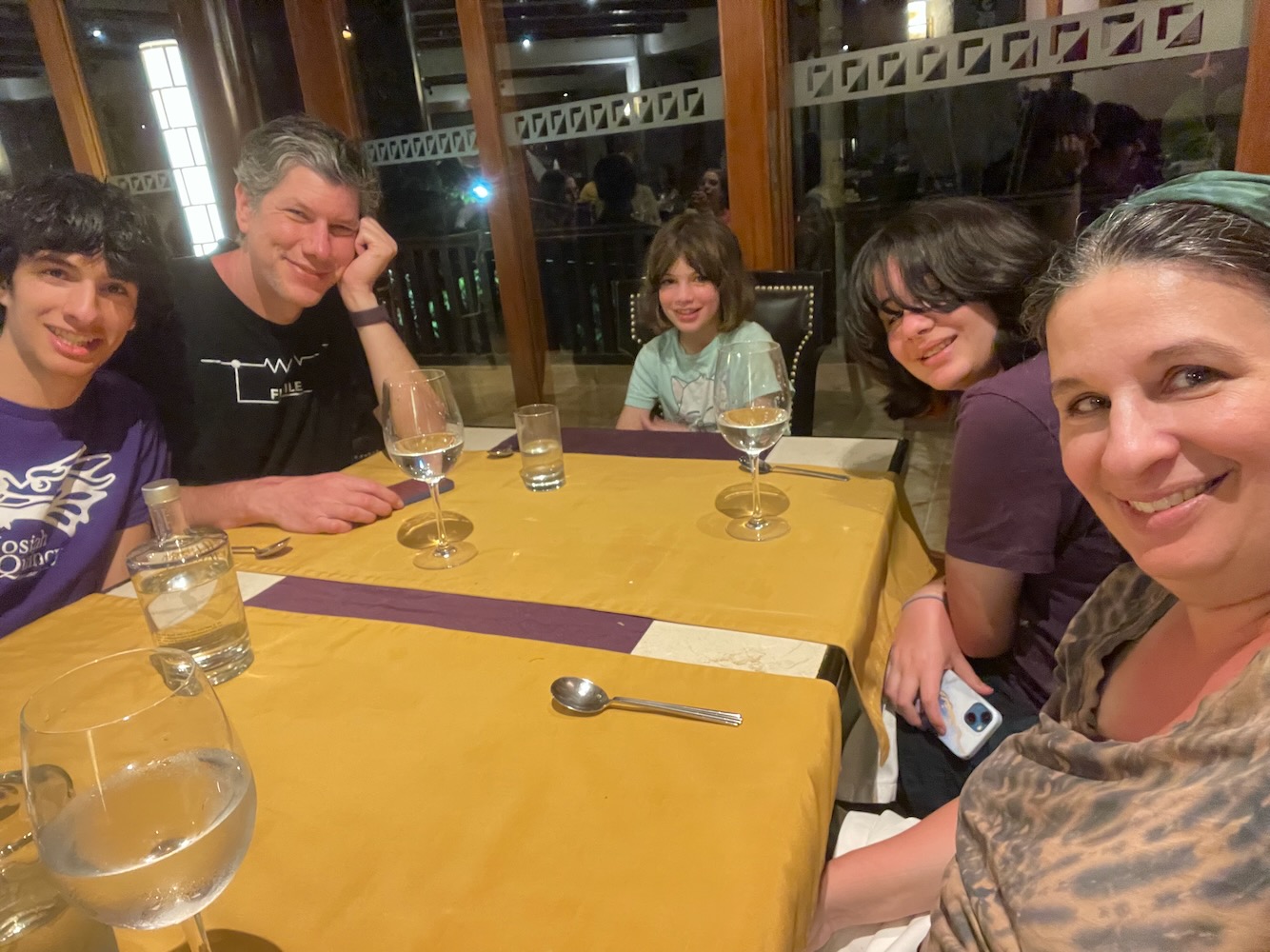
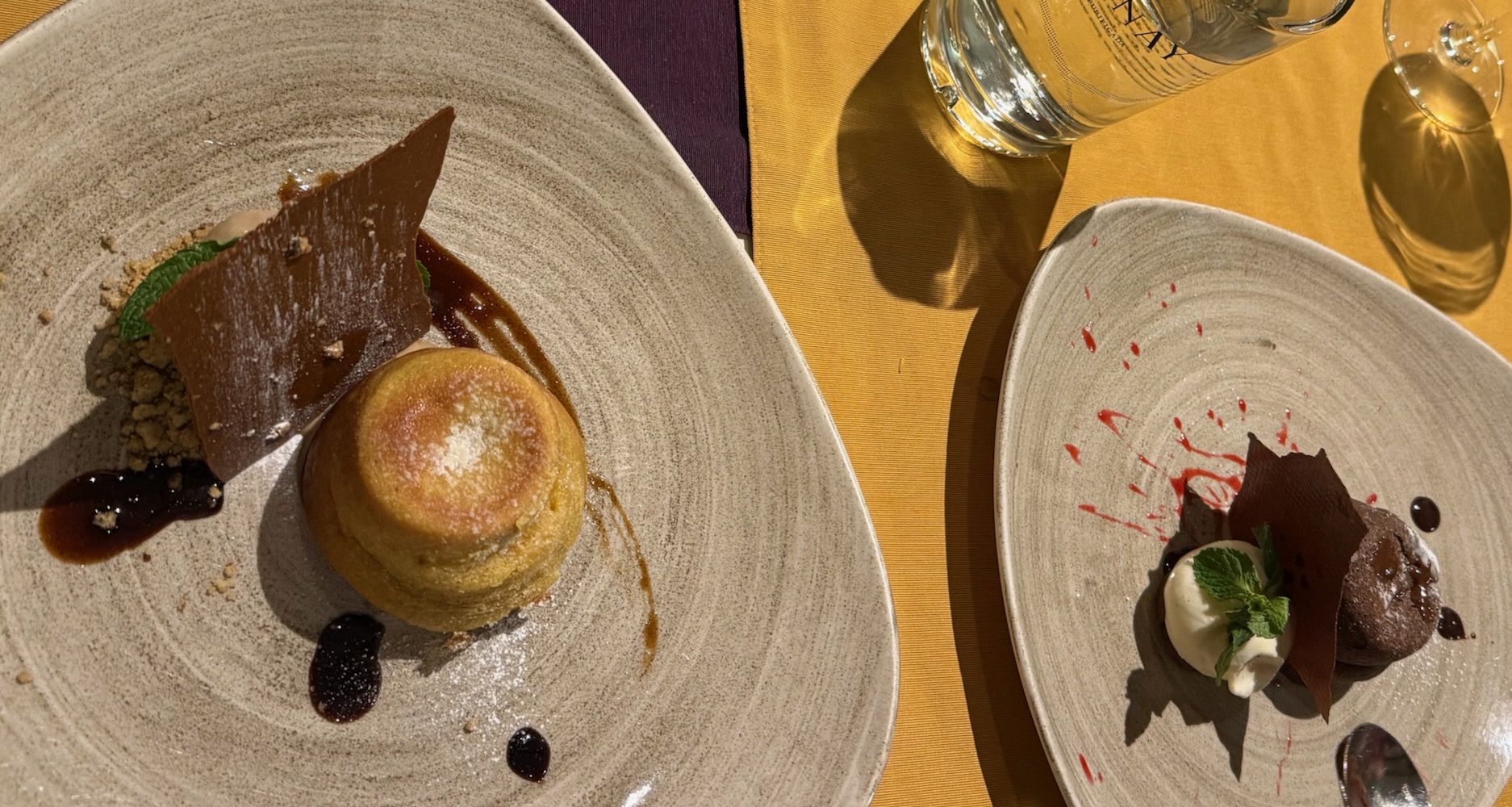
Everyone enjoyed dinner, and we headed back to the room for an early evening, and the lovely treats the hotel brought to our room.
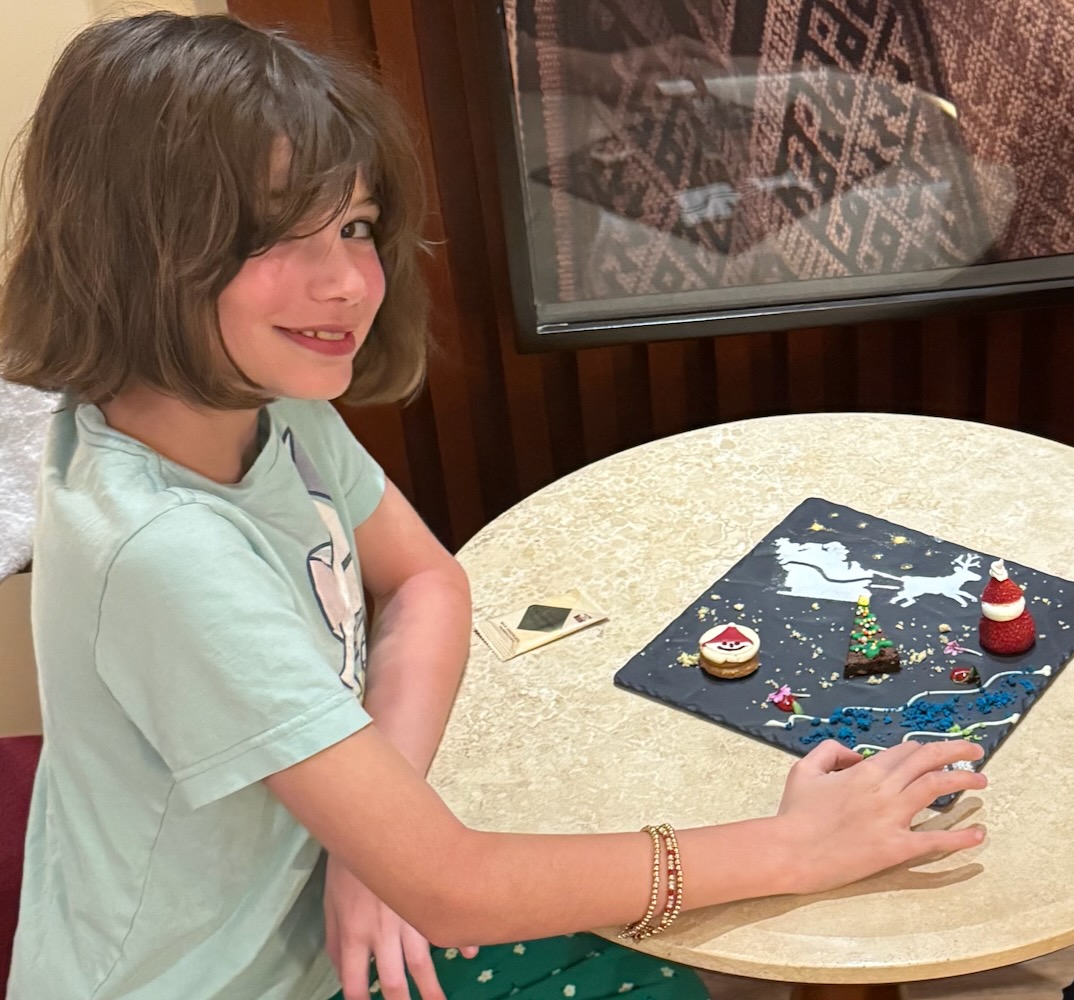
The plan was to be at breakfast at 5 AM the next day and on a bus to the mountain at 6 AM, but then Samantha said she didn’t feel well. I put it down to dehydration and altitude, but whatever it was, she was indeed sick from 8:00 until midnight, at which point she was finally able to sleep a little. In the morning, her stomach and head still hurt, so I left her sleeping and joined Robert, Marcus, and Helen at breakfast. Breakfast was a beautiful buffet, and it’s nice that it’s open from 5-10 AM to accommodate both early and late folks going up to the mountain. Soon I waved goodbye to Robert, Marcus, and Helen, and went back to the room to stay with Samantha.
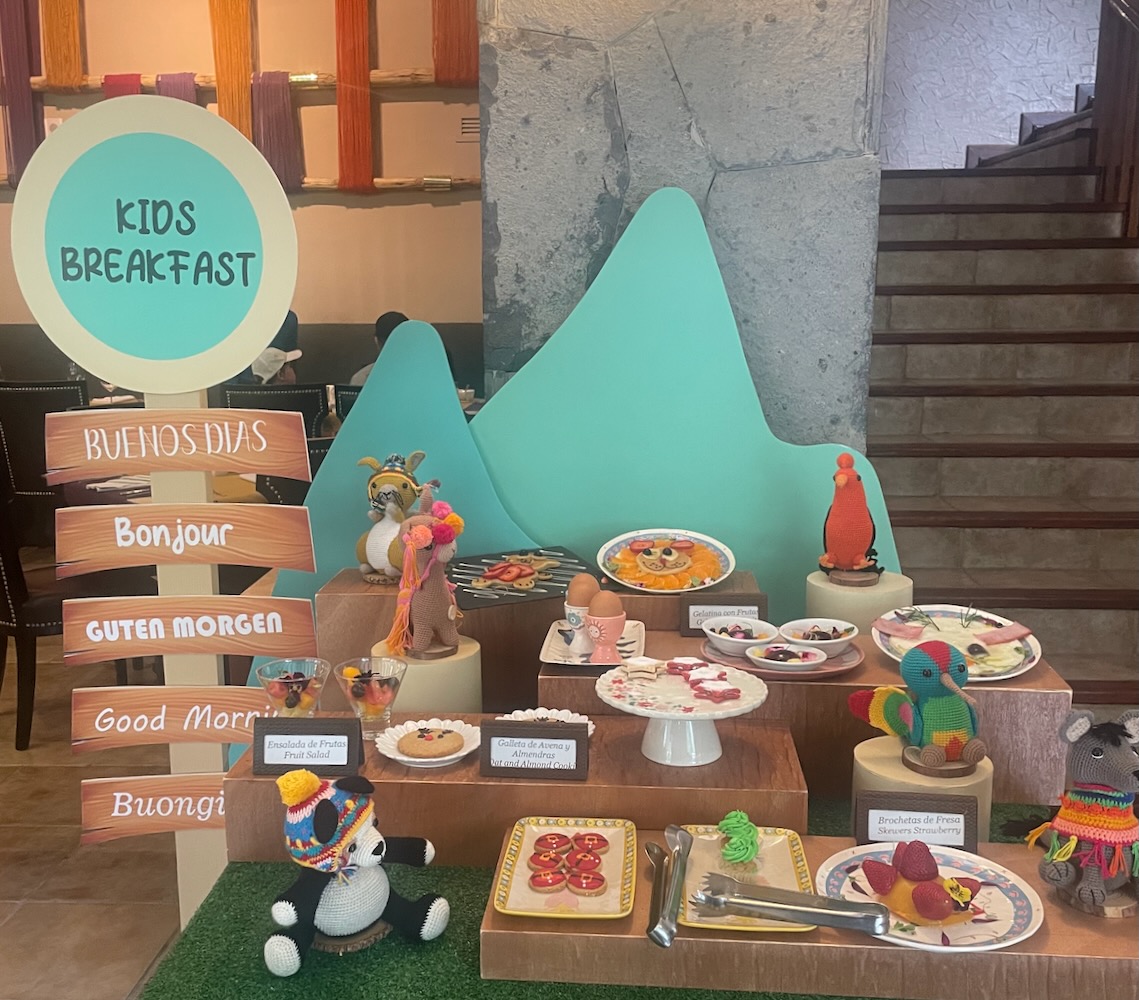
By 9:00 she was awake and feeling well enough to come to breakfast with me, sip a little orange juice, and eat a little bit of toast with butter. We spent some time in the lobby watching an hour of a show on the iPad while they cleaned our room (the season finale of Battlestar Galactica, season 3–Starbucks returns! Samantha had been in suspense since we left Boston, and we hadn’t had the chance to catch up on things), and then we went back to the room and Samantha rested a little more.
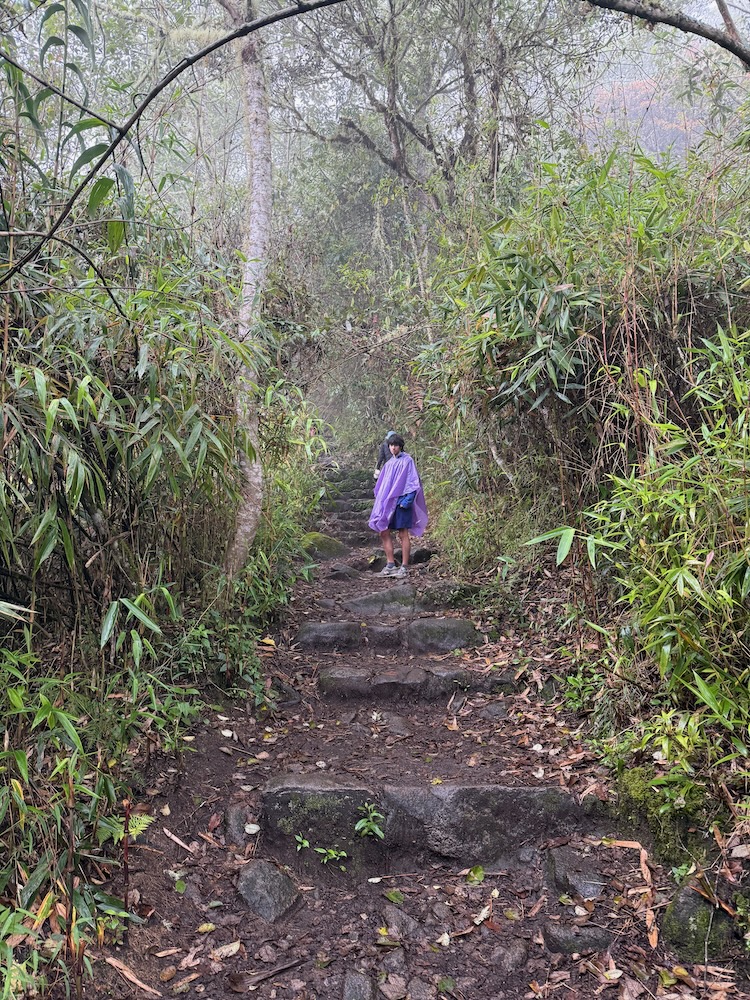
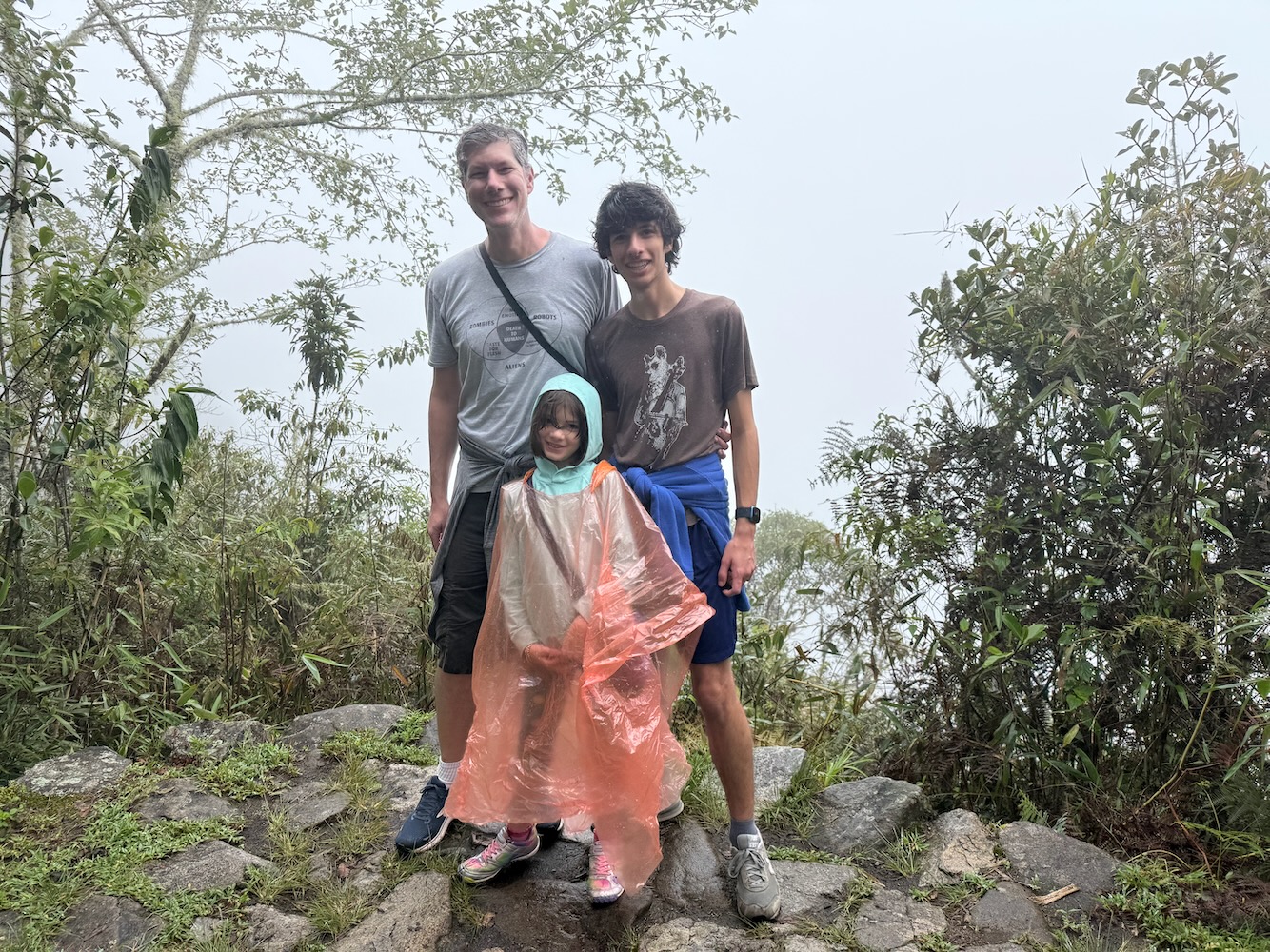
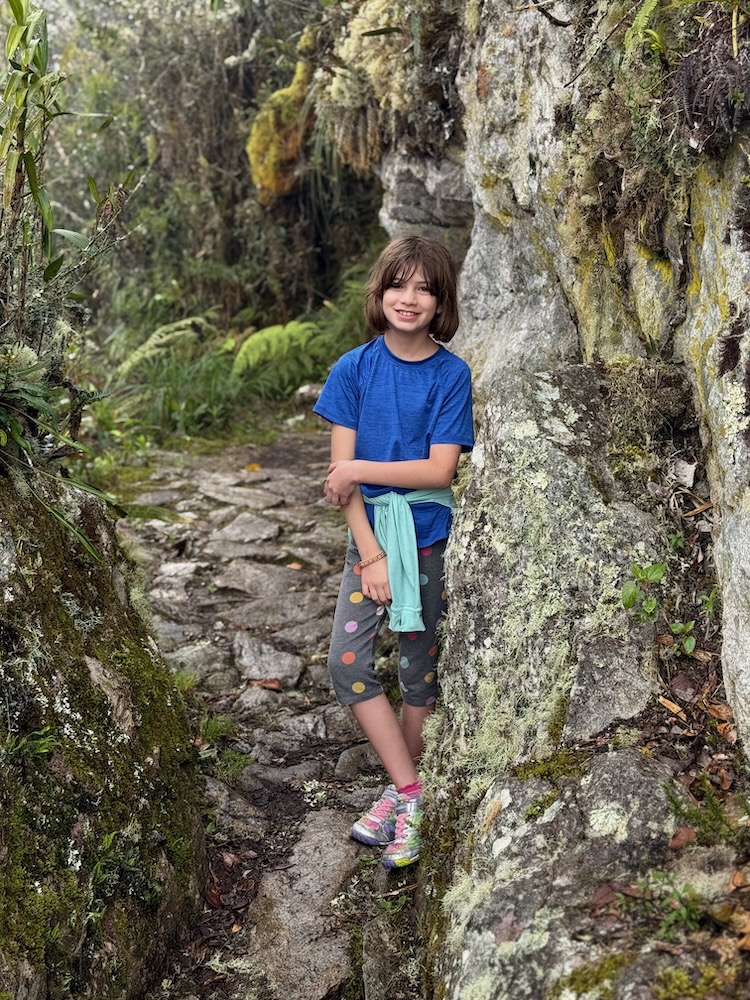
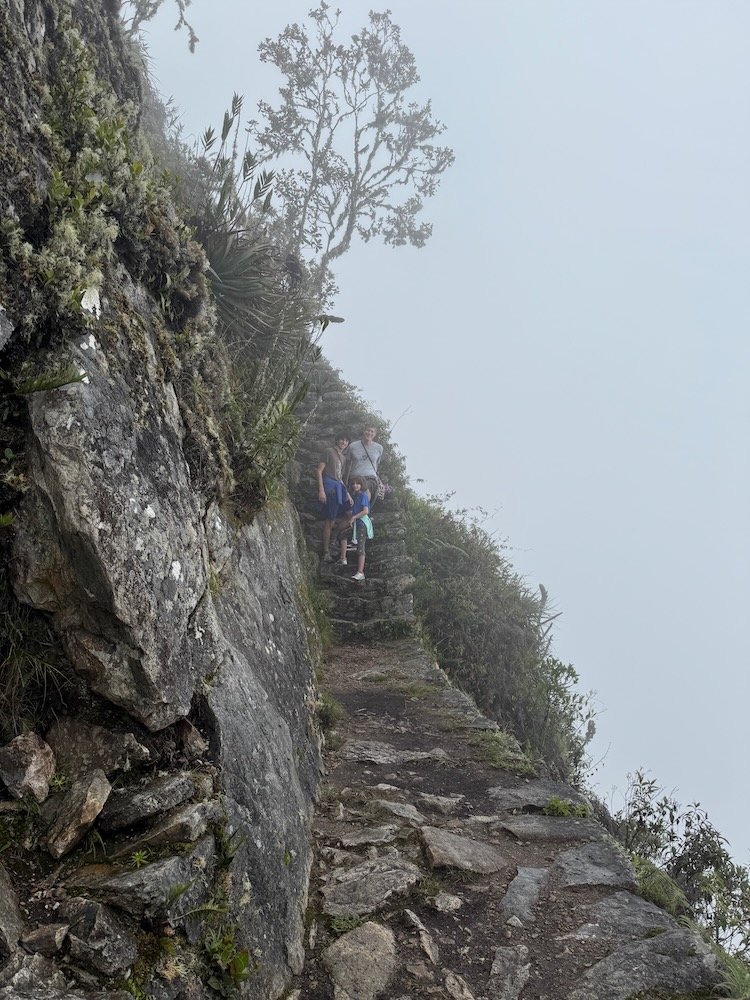
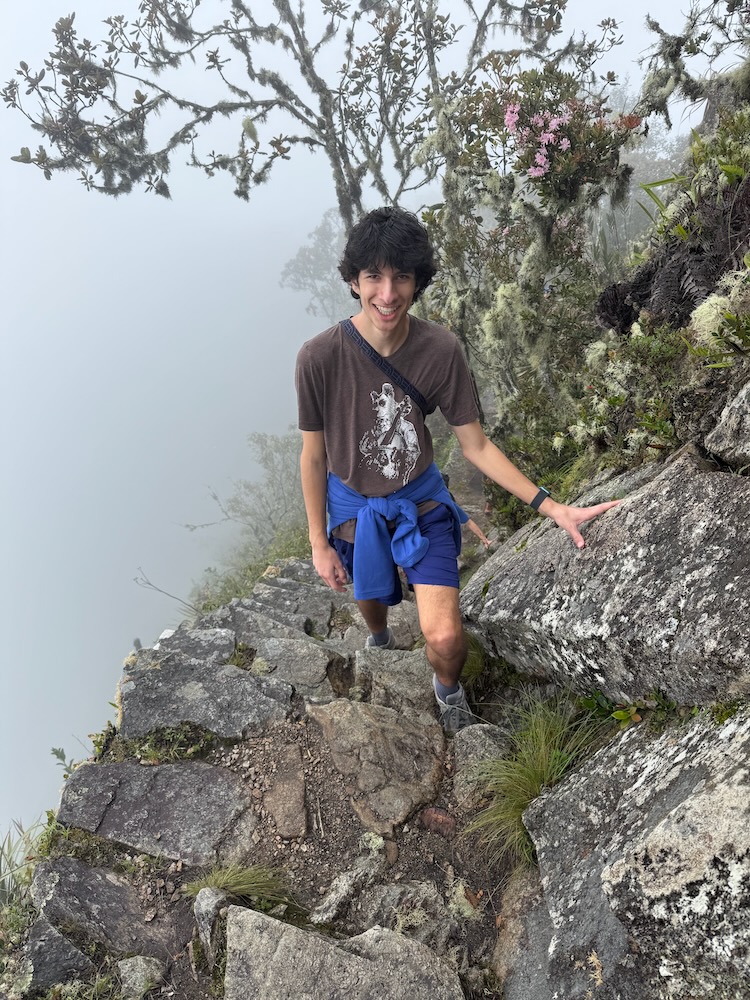
Meanwhile, Robert and Marcus and Helen took the bus to the base of Machu Picchu, paid their 2 soles per person to use the bathroom, and then paid a whopping 6 soles each (price-gouging!!) for rain ponchos, because for the first time since we’d gotten to Peru it was raining. They did half of Circuit 1 (views, mostly flat) in the mist and then checked in for the climb to Machu Picchu mountain (Circuit 1A).
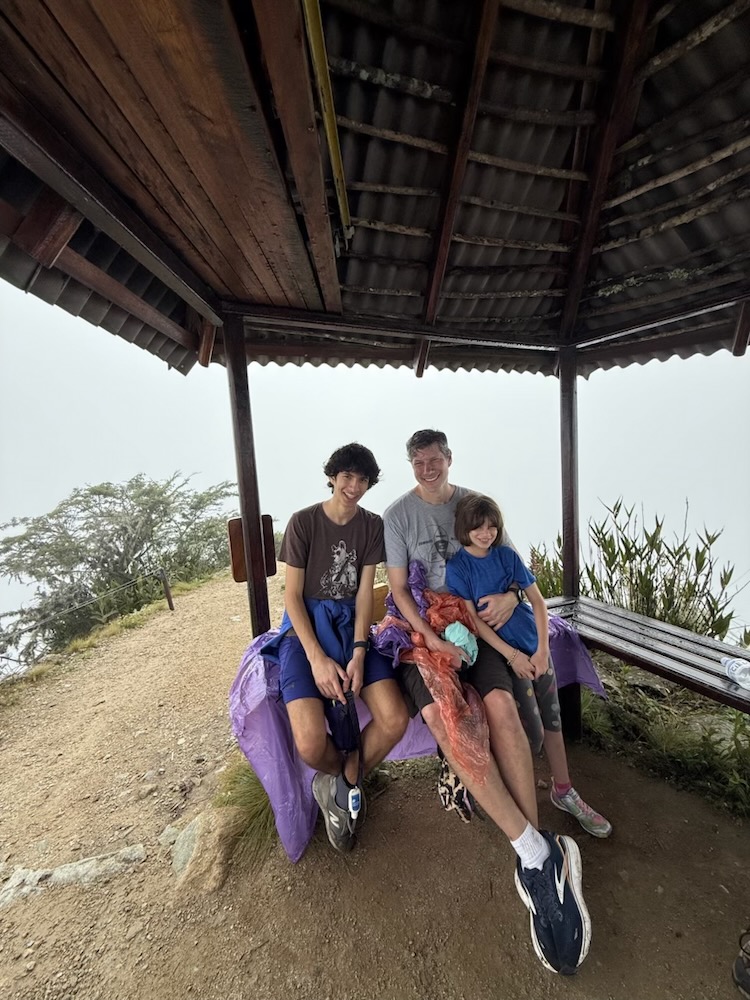
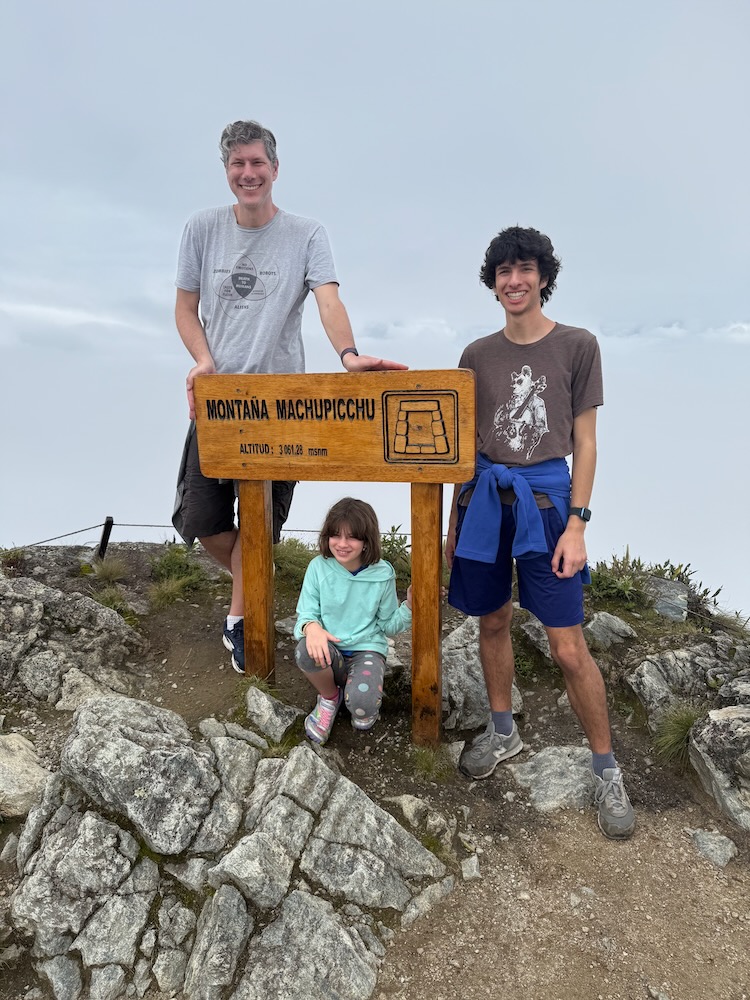
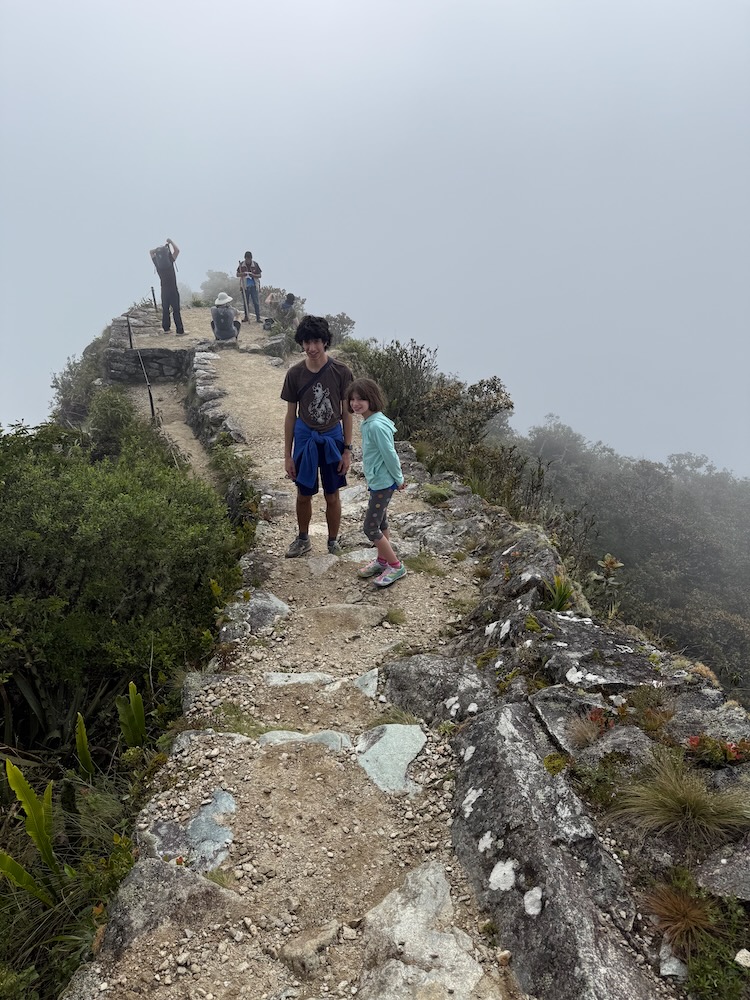
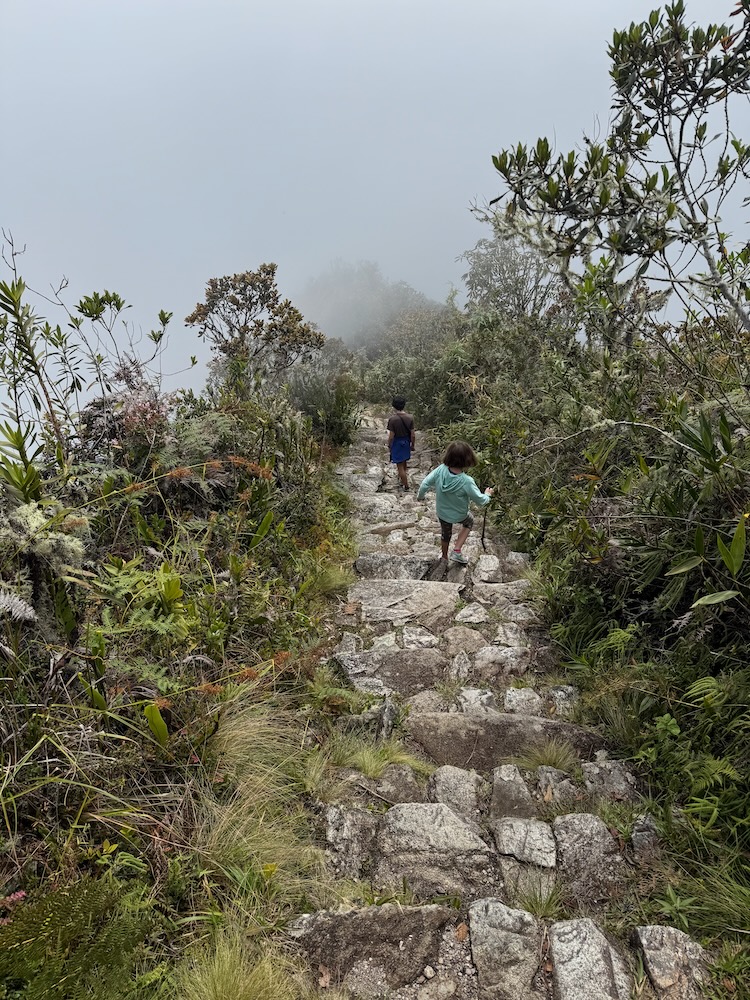
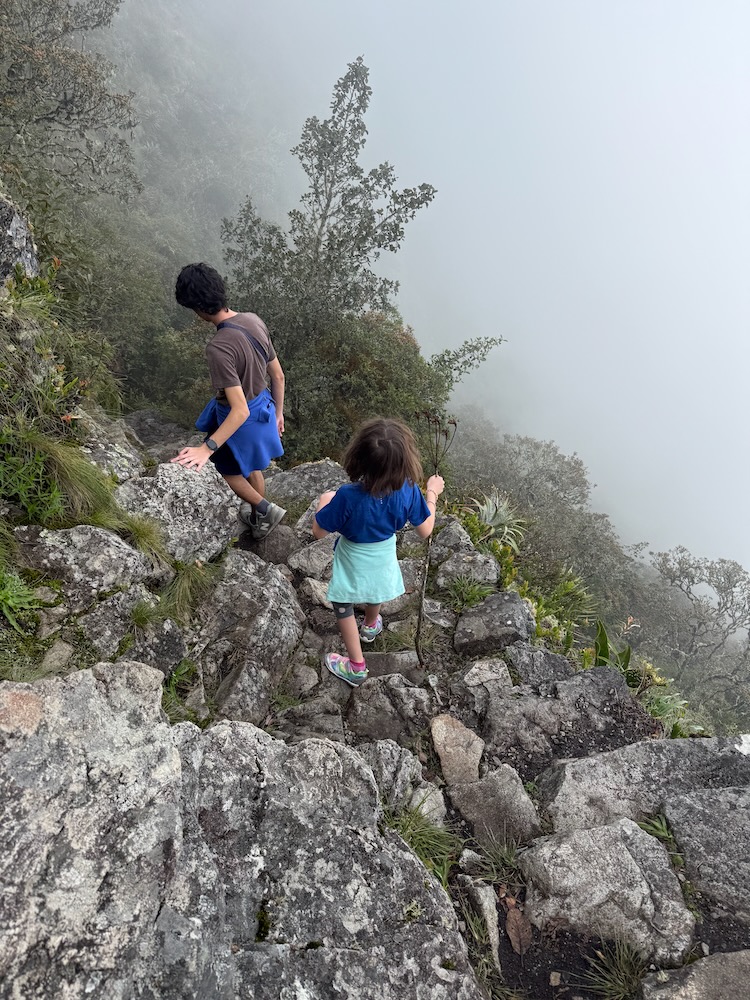
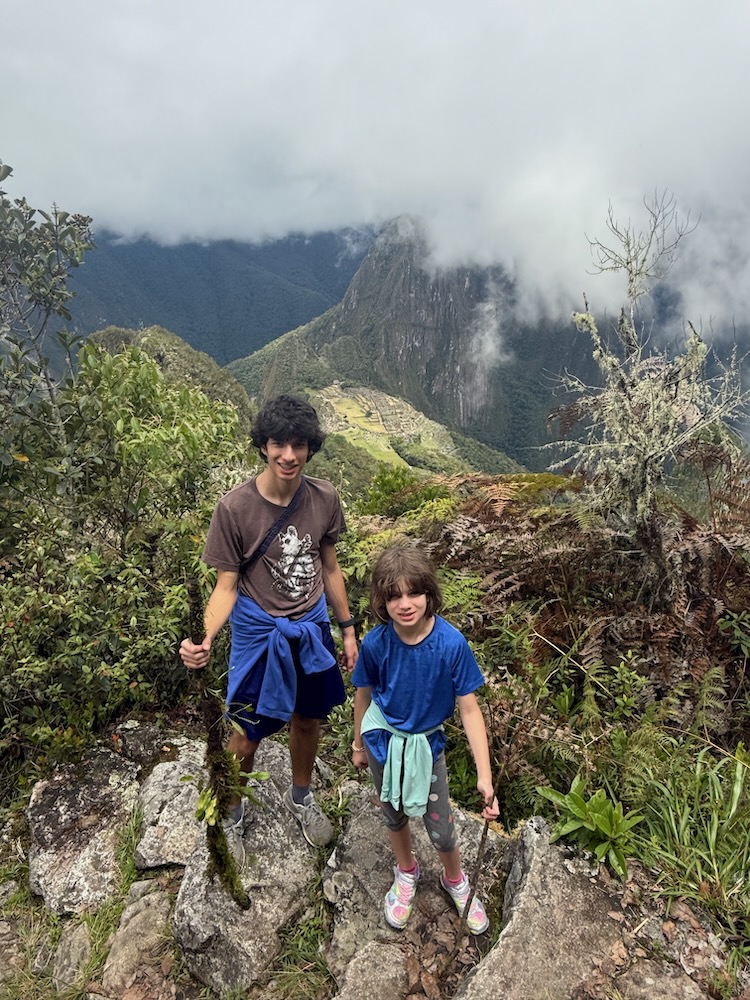
It was a challenging climb, and took them about an hour and a half up and about the same going back down. At the top, the mist and clouds were so thick they couldn’t see anything, but at some point on their descent the clouds cleared. Helen was amazing—her legs are small, and some of those steps and rock scrambles were VERY big. Marcus really enjoyed it, Robert thought it was one of the highlights of the trip, and Helen was extremely proud of having accomplished it—at 8000 feet above sea level, no less!
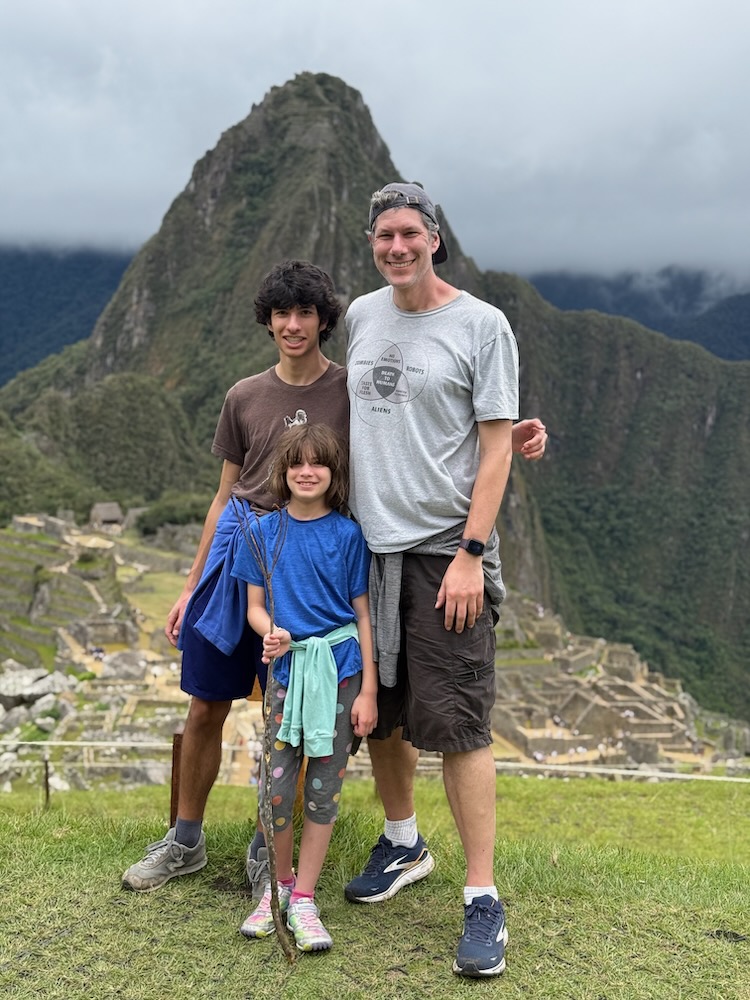
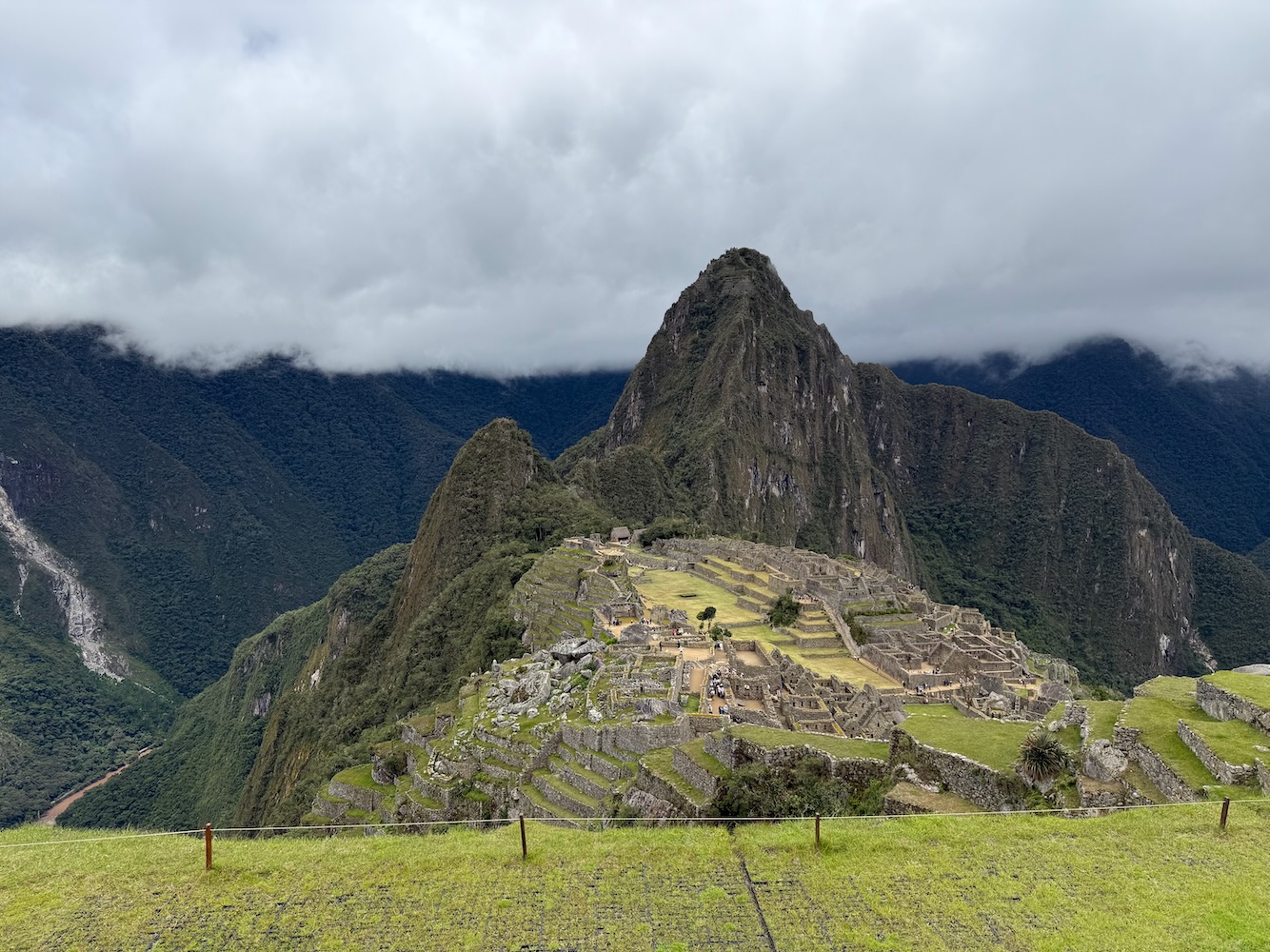
Samantha and I met their bus when it came back into town, around 12:30, and we went for lunch at a place on one of the upper terraces overlooking the train tracks. We had strawberry lemonade, camu camu (sour cherry-like) lemonade, an alpaca blue cheese burger, an alpaca steak, and some octopus. The steak and octopus each came with noodles on the side in a slightly creamy sauce, and Samantha felt well enough to eat some noodles and drink some fruit lemonade.
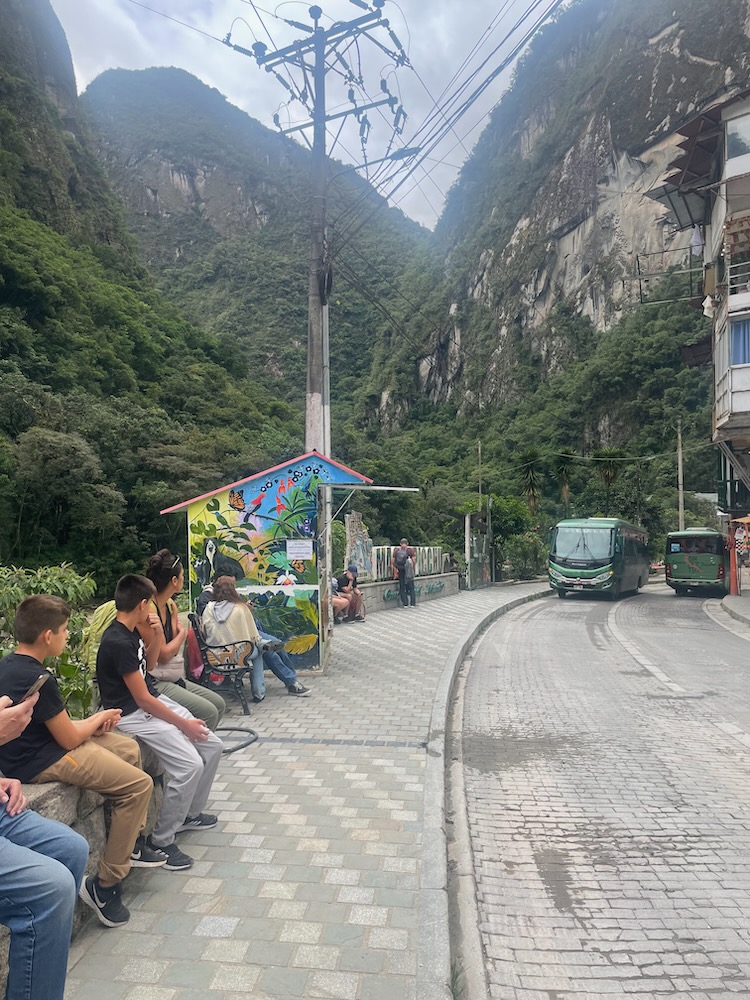
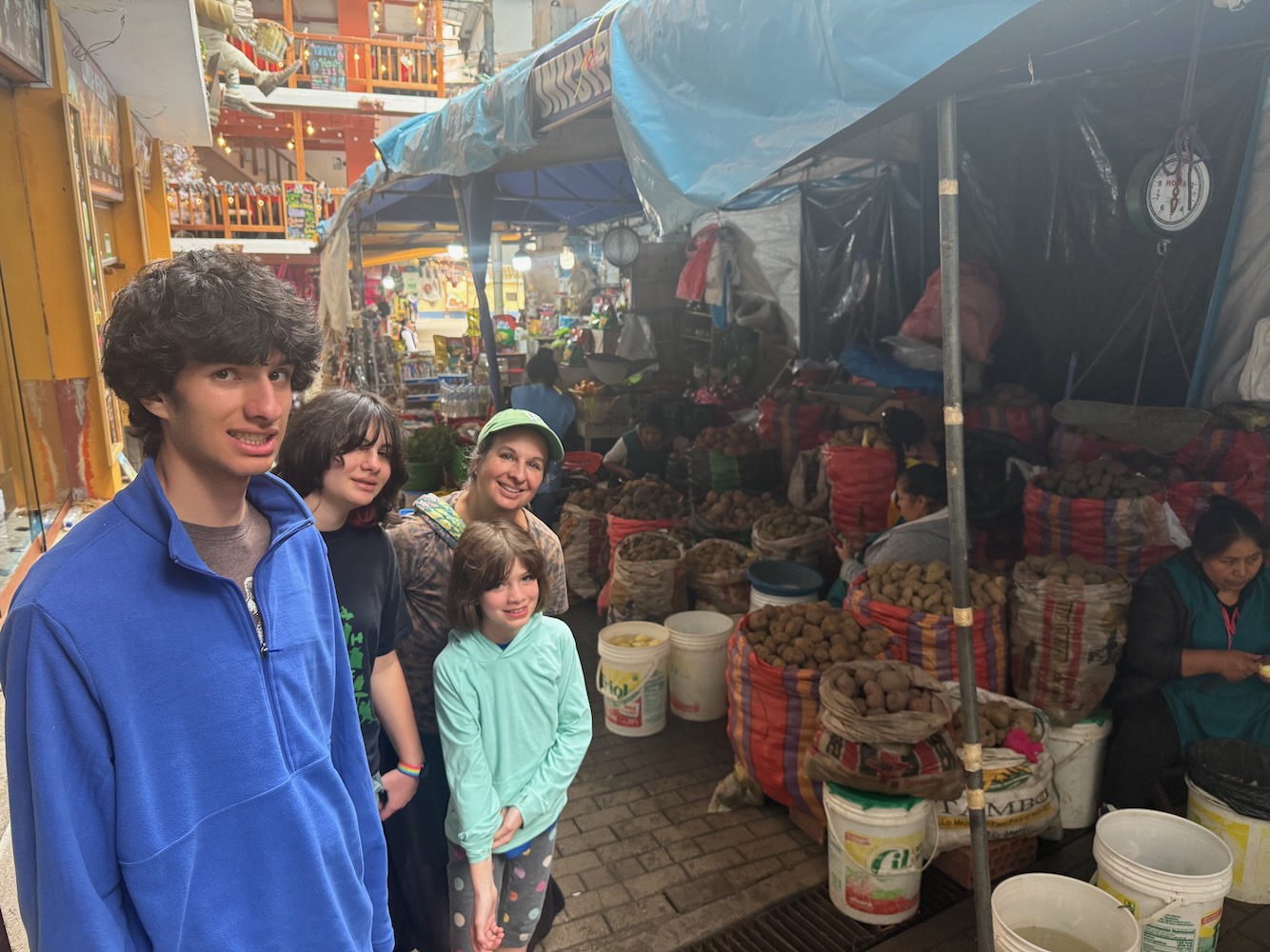
After lunch we walked around the town, crossing bridges back and forth over the river, admiring the expert way the bus drivers accomplished K-turns on a very narrow street (i.e., by hanging the back 1/3 of their bus over the side basically into the river), and walking through various market areas until we came to a particular ice cream place Robert thought was best. I had to pause us at a big potato stand in the market area, since "how many varieties of potatoes does Peru have?" had become such a hilarious ongoing joke. One book Helen read said more than 350, another more than 400, another more than 4000, and a guide back in lima had said around 3000. So who knows? At any rate, multiple kinds of potatoes were represented right here in this market. We declined to stay and count them all.
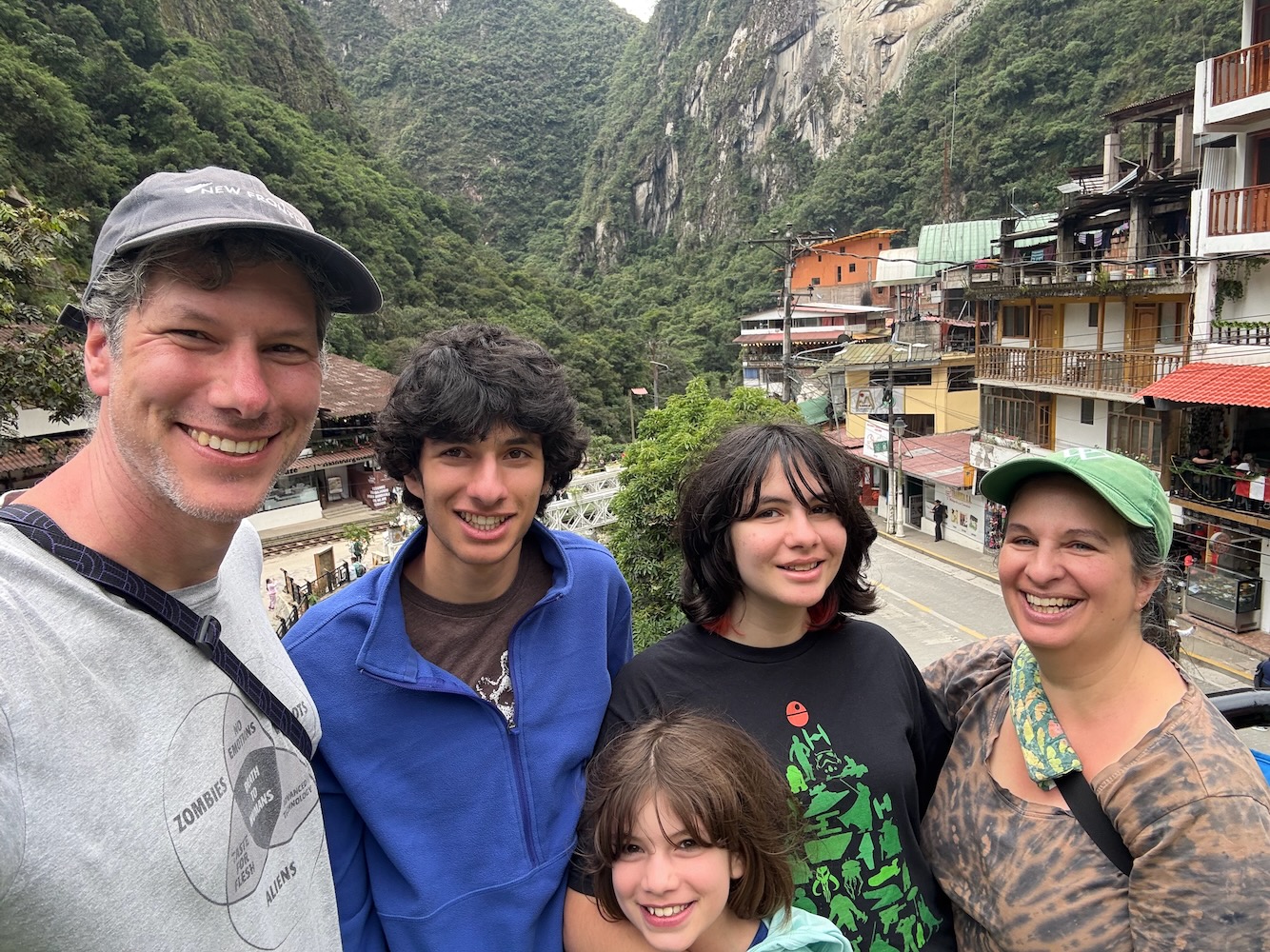
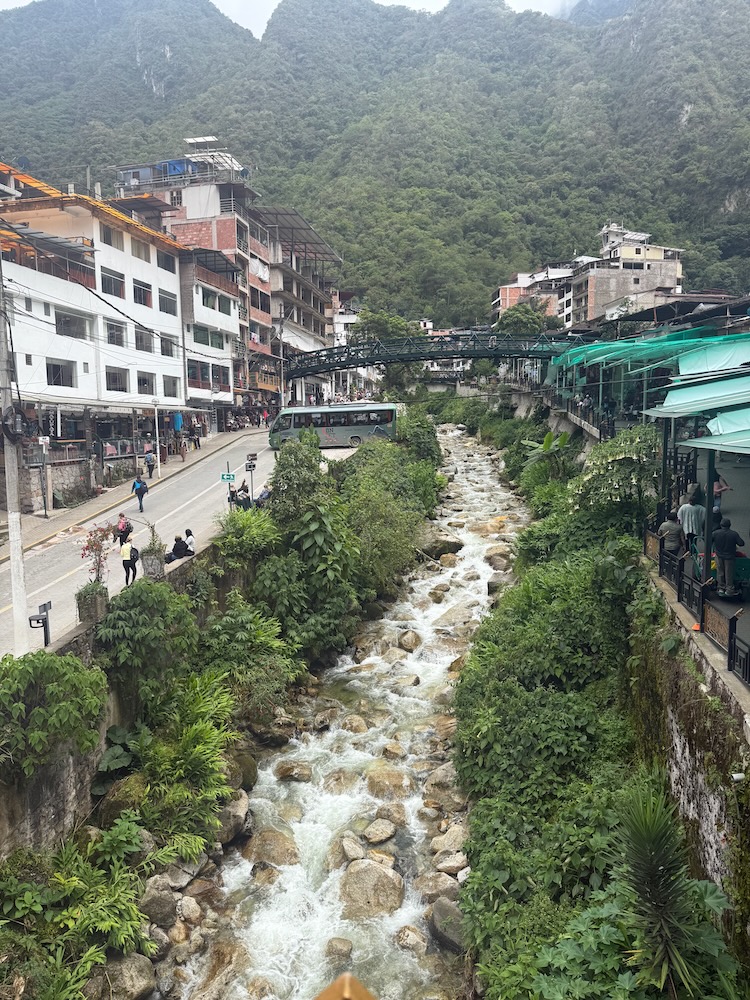
All around the town, we admired the dogs just sleeping on the road, the sidewalk, everywhere—they are well-kept strays, or outdoor pets, and extremely mellow. Some people posing for a picture in front of the town crèche didn’t want a dog in their picture, but Robert observed that that would only make for a better picture.
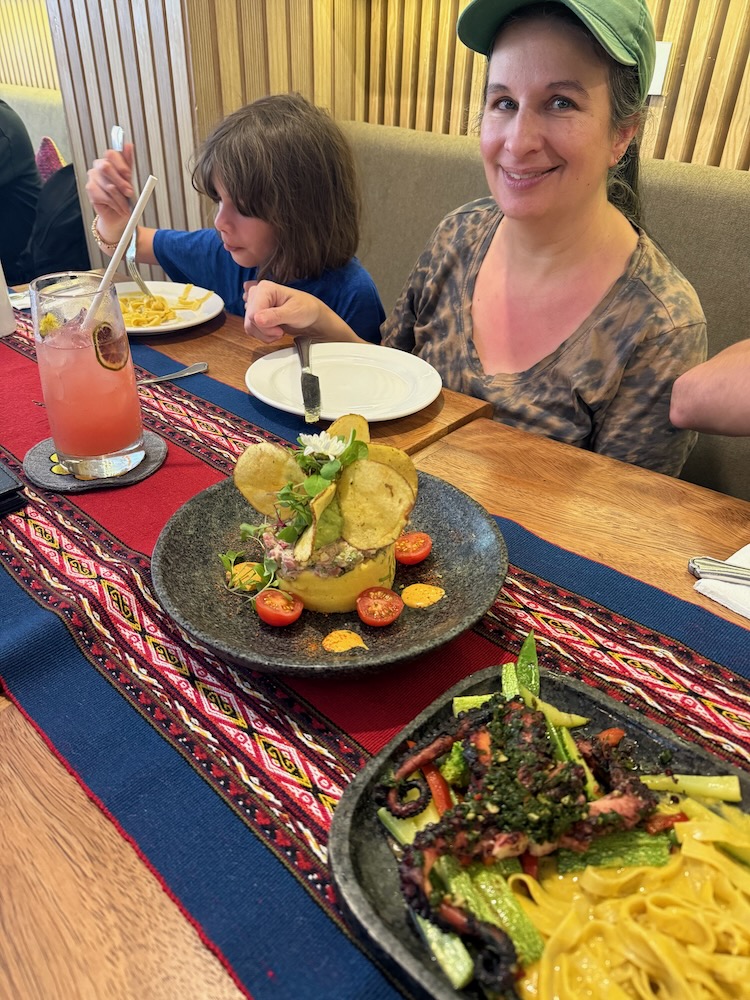
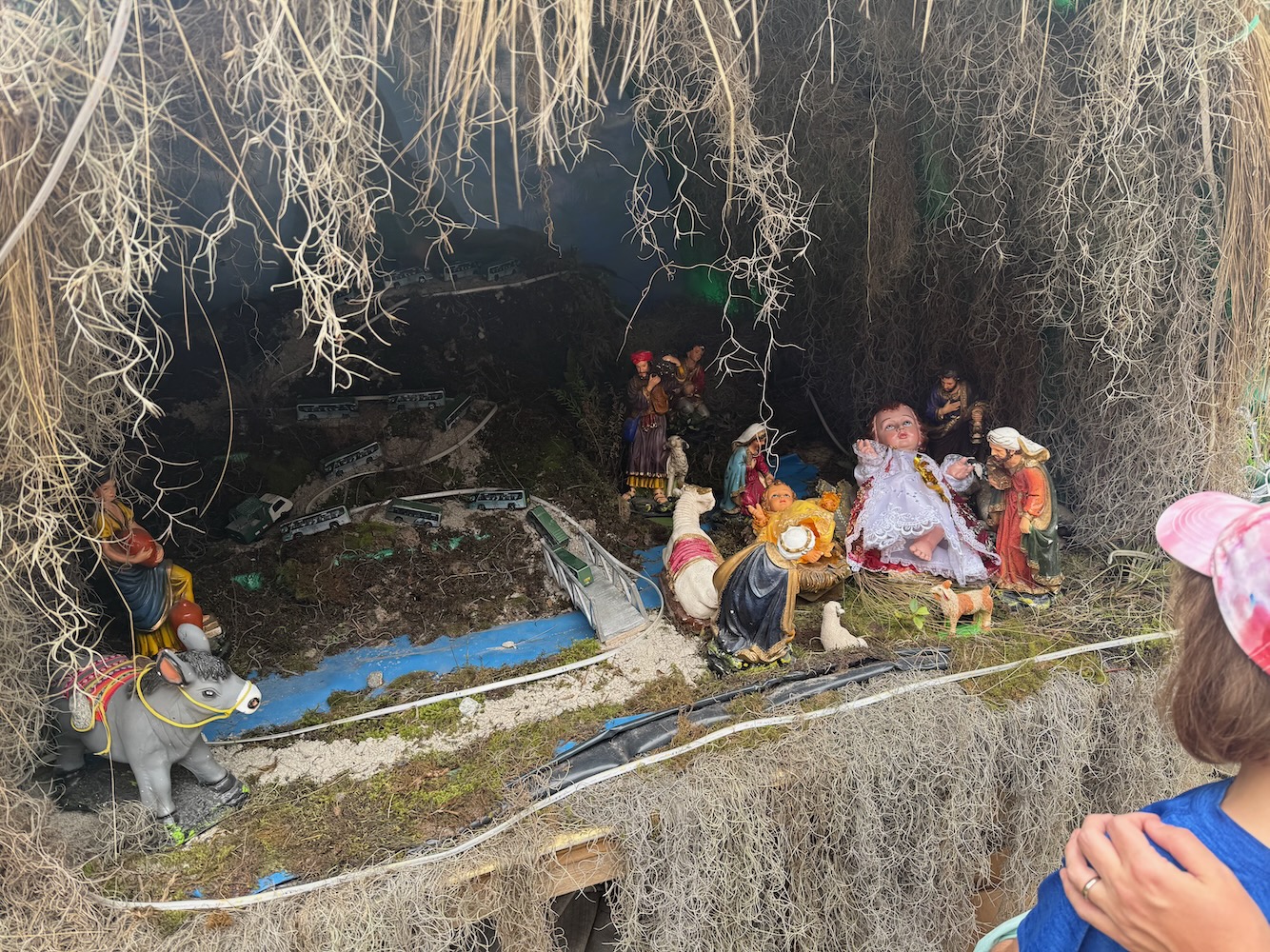
We eventually walked back to the hotel and both Marcus (up early, lots of physical activity) and Samantha (up late at night, still not feeling perfect) lay down and took naps. Meanwhile, Robert and I took Helen back out to the mariposa sanctuary just down the road.
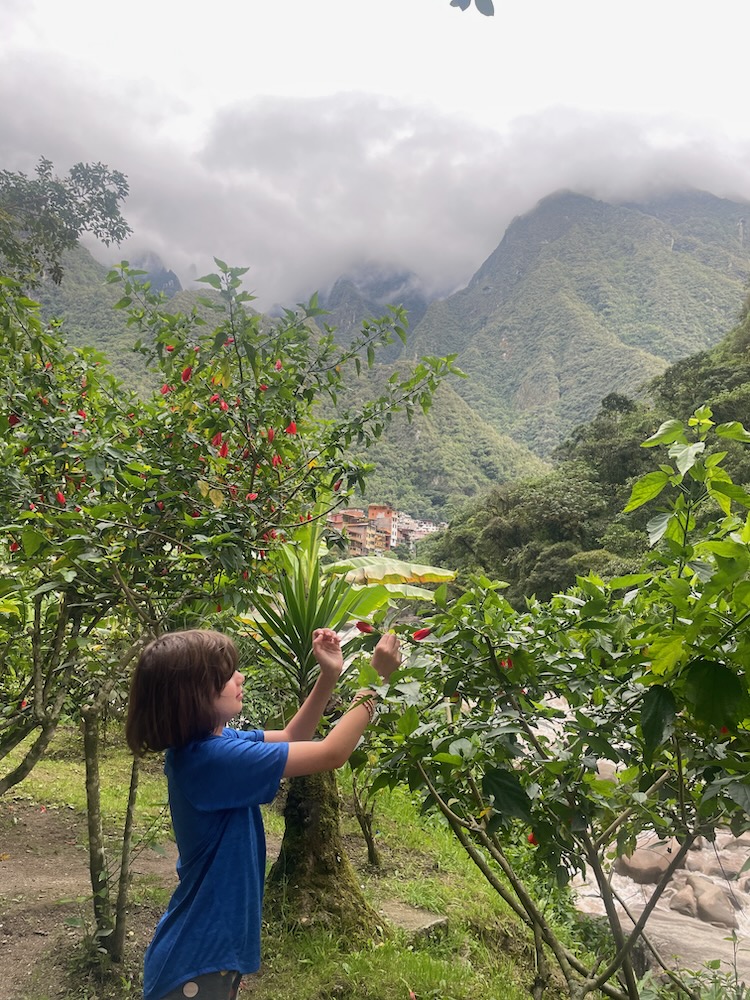
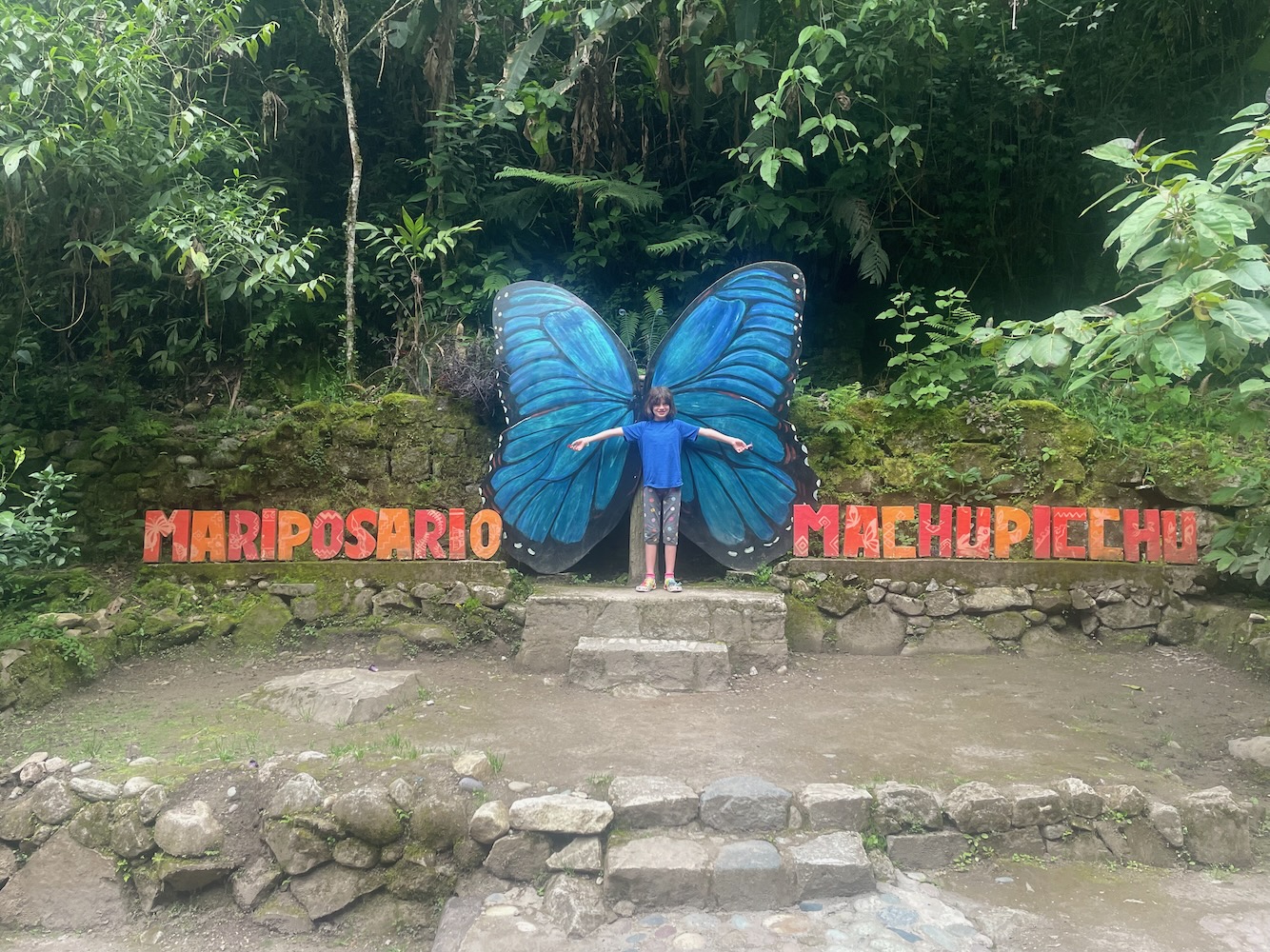
We walked down the dusty road alongside the river, in the direction of Machu Picchu, away from town, and after about 5 minutes of Machu Picchu buses speeding past us along the narrow road, one empty one heading toward the mountain pulled over and asked (in Spanish) where we were going. When (also in Spanish) I mentioned butterflies, he said to get in, he’d take us there. We hopped on, grateful, and he drove us a kilometer or two down the road and stopped in front of the butterfly place. We thanked him (in Spanish) and he prompted us for a tip (again, in Spanish), but I knew Robert and Helen hadn’t understood him, and I was nervous that we didn’t have any small change or bills, so I just thanked him a LOT (once again, in Spanish) and hustled us off the bus while he (in Spanish….) repeated that he really would appreciate a tip. Oops….
The butterfly sanctuary was tiny, and not fancy, but very cute. Admission was not expensive, and they suggested we go in the back to a bird-watching area overlooking the river for 10 minutes until their final tour of the day started. The tour was all in Spanish, but between the colorful infographics on the walls with a bit of English on them; my running translation (“interesting, this has turned into a capitalist critique…uh, the problem is the corporations don’t appreciate the workers and always try to destroy the environment, and only volunteers care about the butterflies, and laborers are the most important part of the world…”); the lyrics of “Dos Oruguitas” from “Encanto”; and Helen’s knowledge of the lifecycle of a butterfly, she and Robert managed just fine. There was a room of caterpillars, just like when that traveling caterpillar exhibit visits the arboretum back home, and a series of jars of about-to-hatch or just-hatched butterflies, and then an enclosure where they let the butterflies fly around and feed them for a few weeks before releasing them into the jungle to help restore their species.
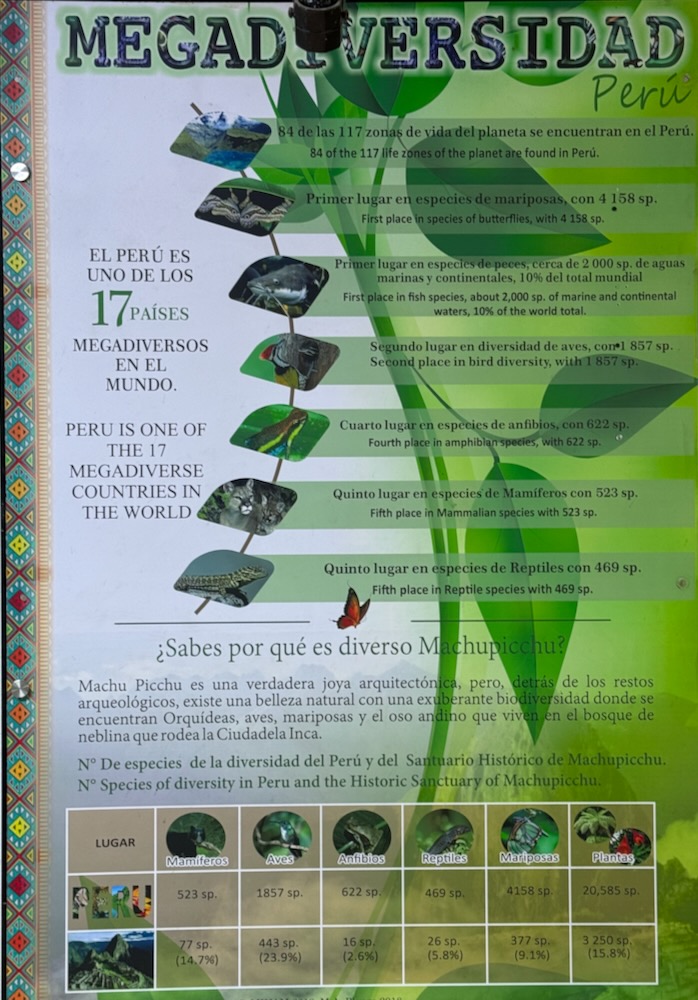
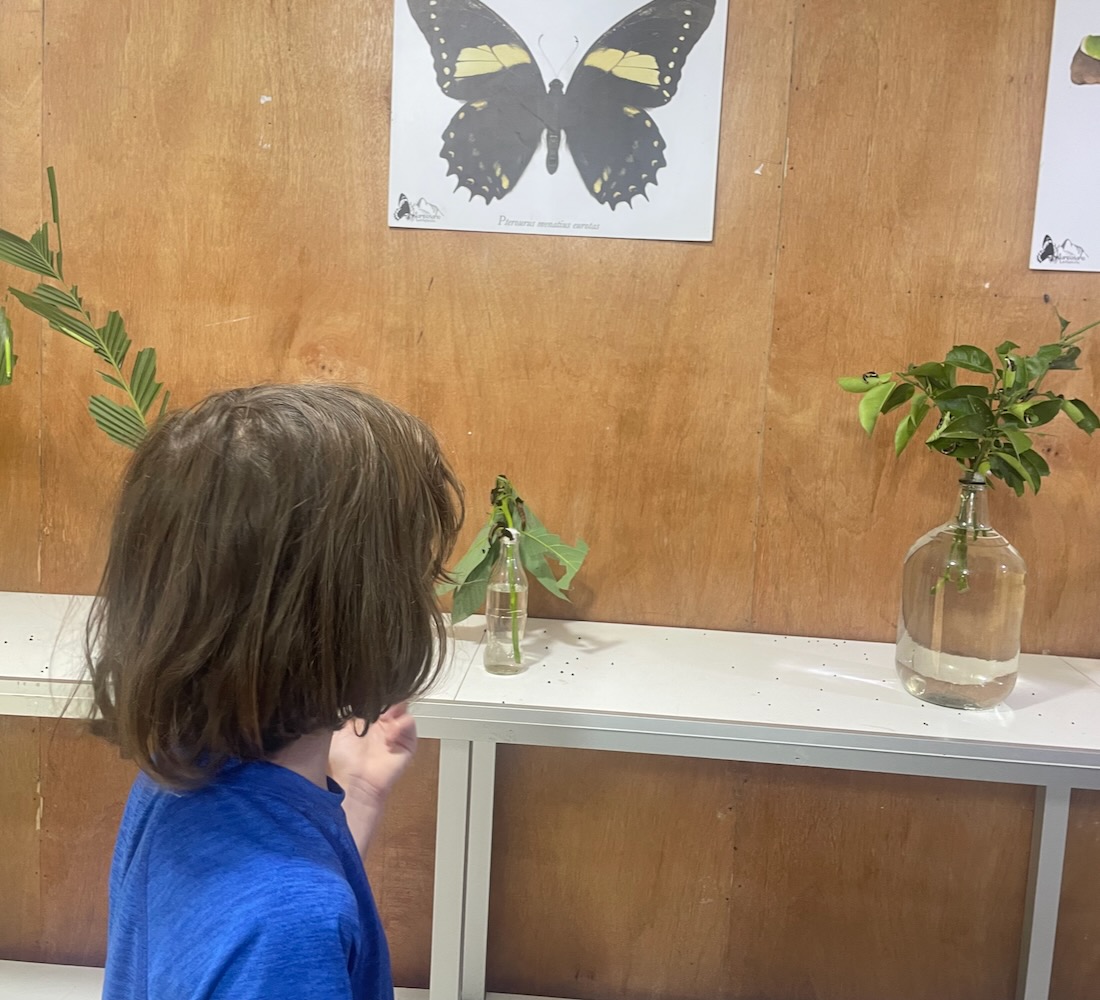
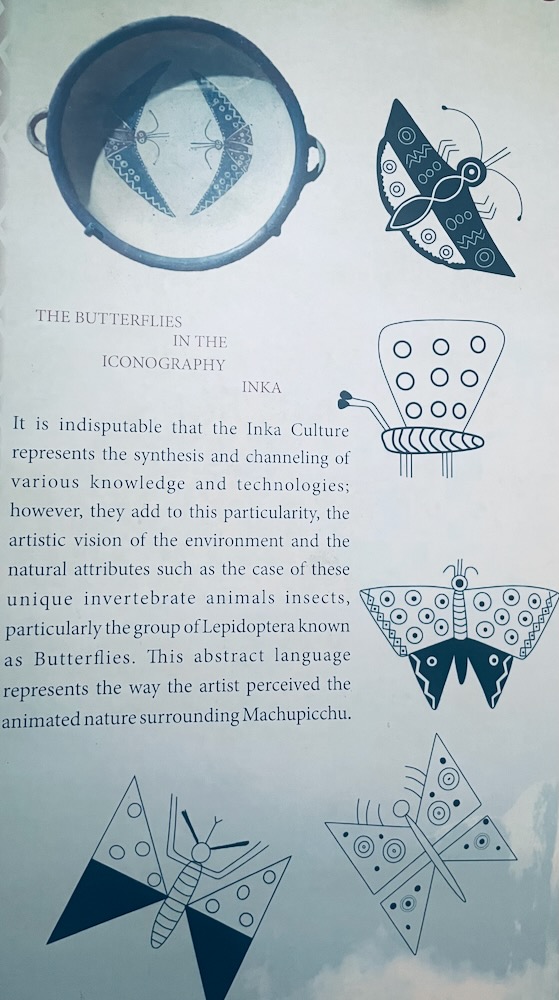
When we were finished, and we started walking back down the road (wary, now, both of buses that sped by not stopping or slowing down, and also of buses that might have stopped for us and again asked for a propina), the dog from the butterfly place came with us. He played with Helen, fetch and chase and tug of war, and frolicked along, until we were 3/4 of the way back to our hotel, when he decided he’d gone far enough, and he turned back to his owners.
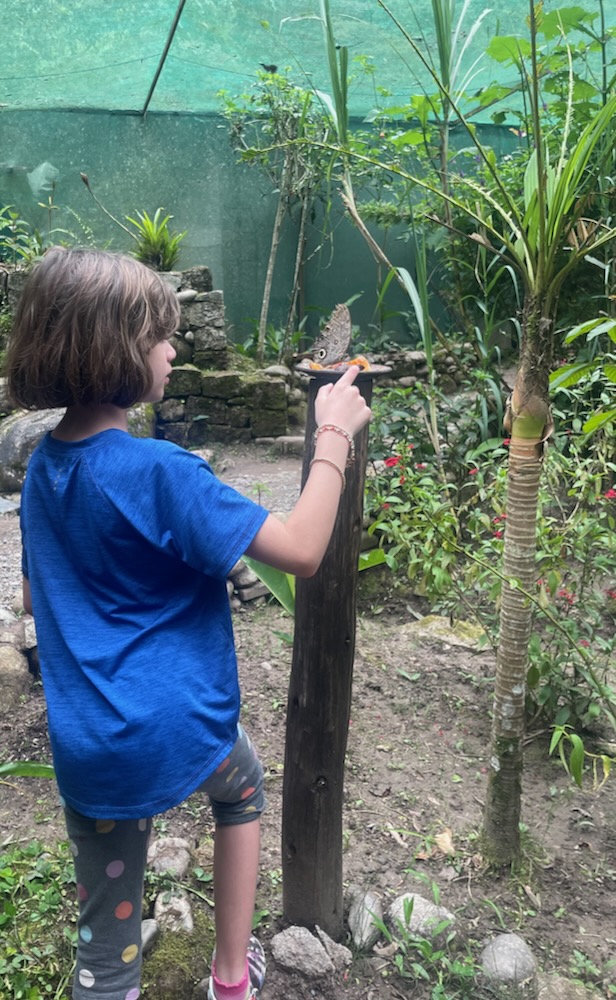
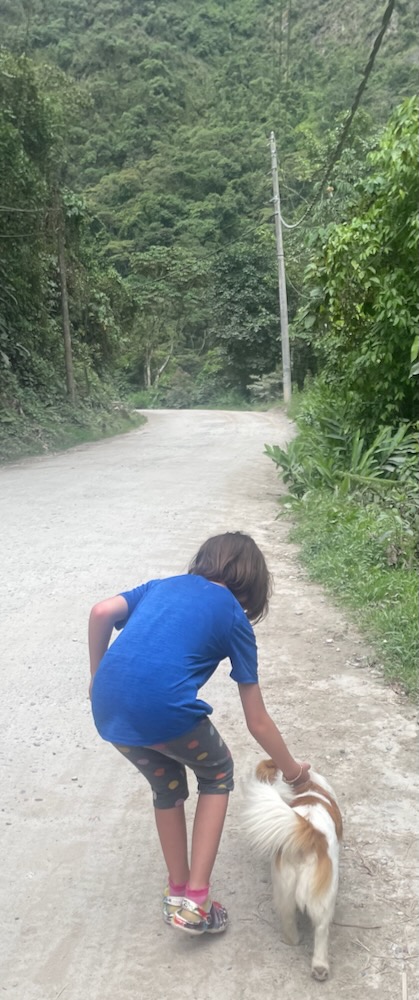
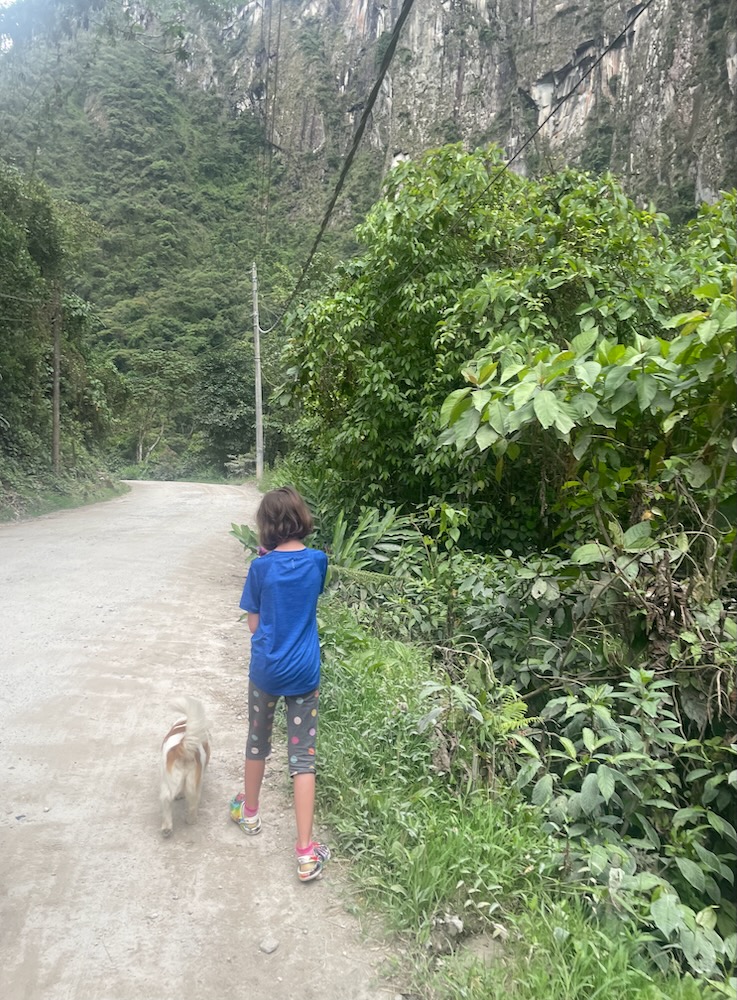
With a great deal of effort, then, we managed to wake up the sleeping dragons—er, big kids—and go down to dinner. Samantha ate a bowl of pasta, Helen some popcorn chicken, and the rest of us ate more ceviche and trucha and alpaca, again very nicely seasoned, and even an alpaca tartare. Helen was incredibly droopy, though, as one might expect after she was up at 4:30, hiked up and down a mountain, and also walked around town and over to butterflies and back, pretty non-stop. She looked like she was going to fall asleep with her head on her plate! Once I’d ordered a dessert for other people to enjoy, I took her back to the room and she was almost instantly asleep.
The next morning we woke the kids up early but not quite as early and walked up into town and then further, past the bus depot and the market area, to the thermal baths fed by the hot springs that gave the town its name. We were there by 7:00 and after we paid 20 soles each for admission, figured out where to put our bag and shoes (in the free lockers—no shoes allowed on the side of the pools except sandals, which only I had, and nothing allowed on the shelves near the pools except towels, which none of us had), and took pre-bath showers under the outside taps (freezing, freezing, tepid, and tolerably warm, from right to left), we bypassed the cold pool and got into the coolest of the warm pools, at 34 degrees C.
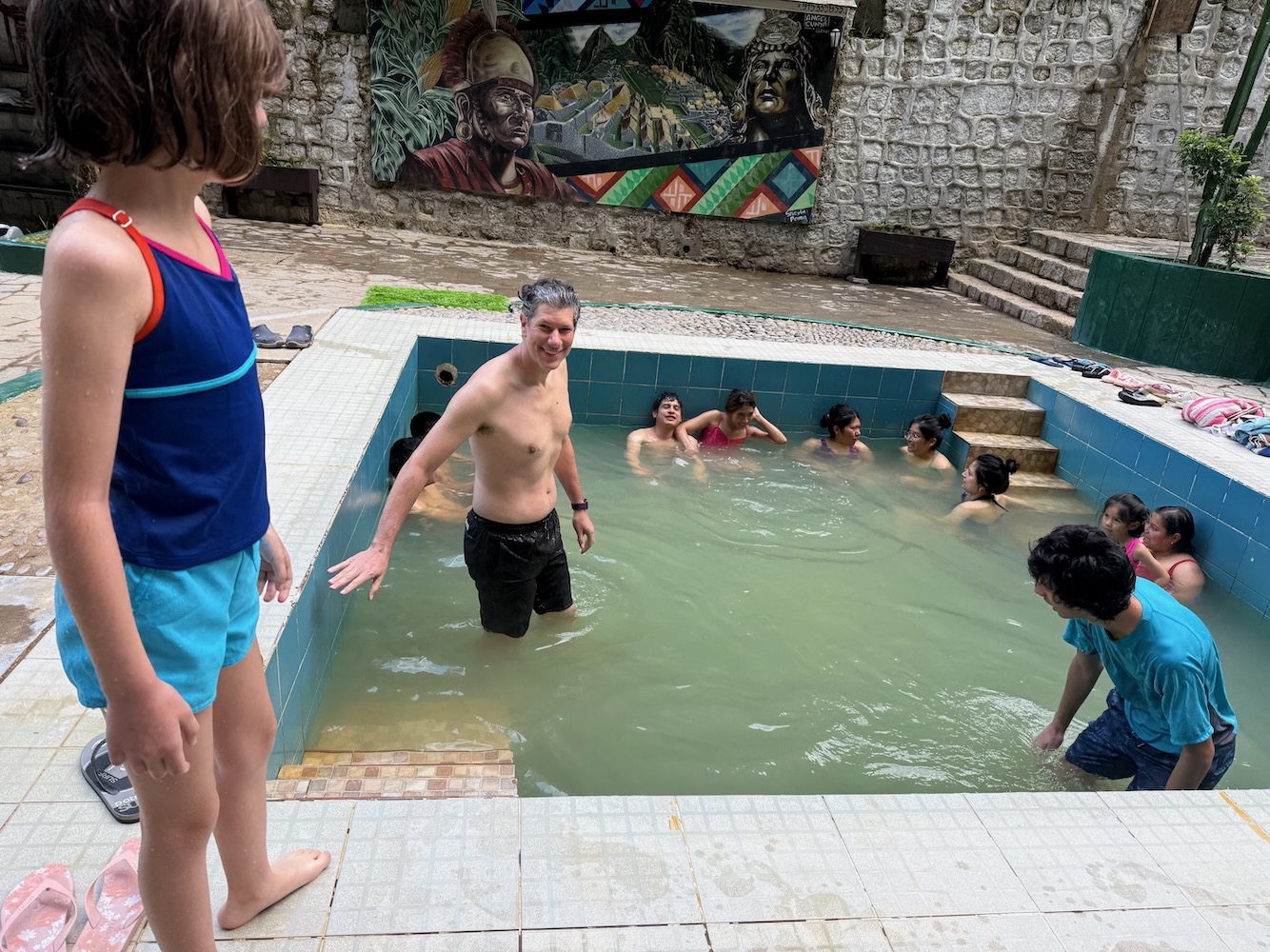
It was lovely! I had read that the pools only get cleaned once a day, at the end of the day, and that the time to go was the morning. I can’t speak to their appearance later on, but they were quite clean and comfortable when we were there. The place wasn’t fancy, and we were the only non-Peruvians there, but I loved relaxing in the pool for half an hour and chatting in Spanish with a friendly extended family from Cusco (their admission was only 5 soles each, as locals) who had a five year old girl named Valentina who was very friendly but shy and kept trying to talk to Helen, and then getting nervous and backing away. Helen got good at shyly answering “ocho” to “cuantos anos” questions, and I had a happy time remembering all the times we’d been in Japanese baths in Hawaii, and thermal pools in Iceland, and other thermal pools in New Zealand.
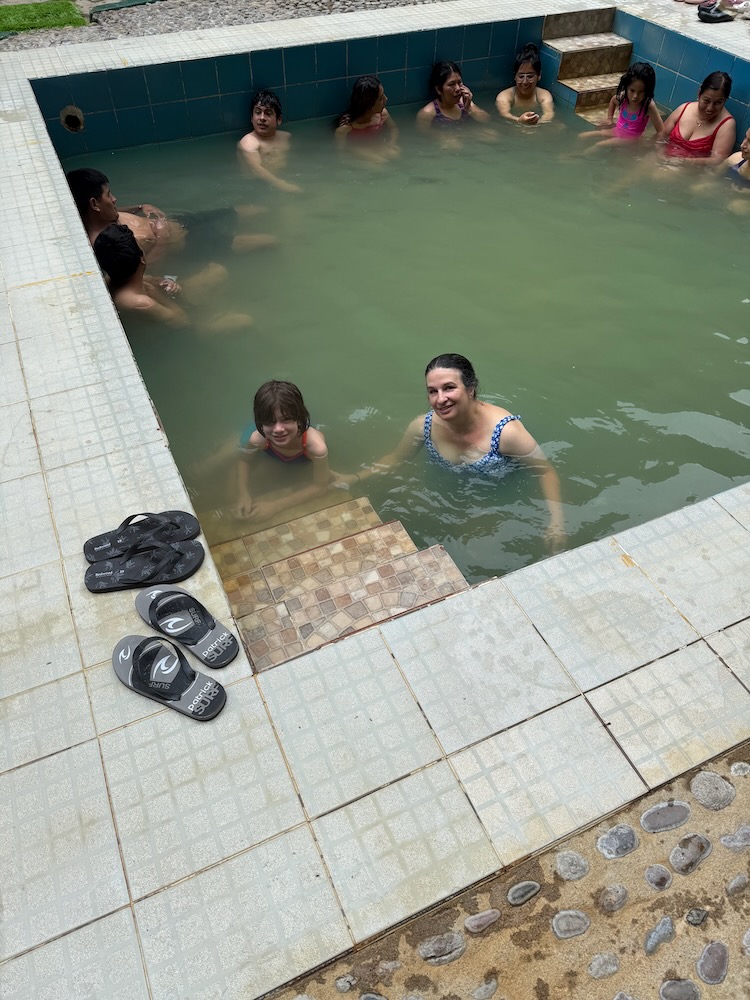
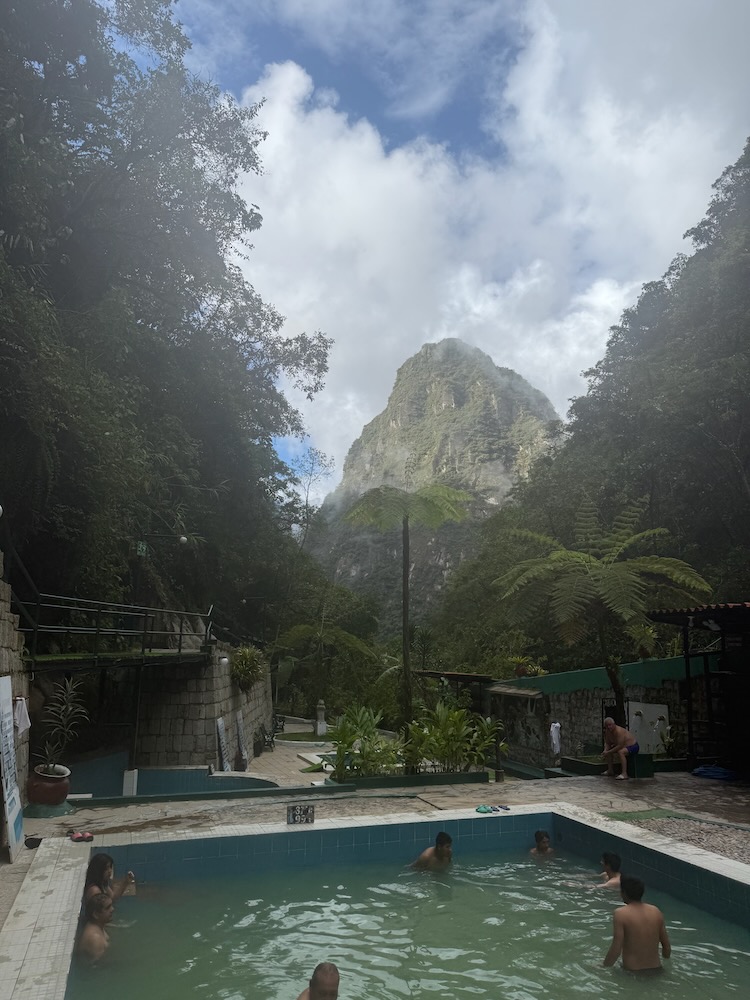
The air temperature was not cold, and Helen and I changed but Marcus and Robert just walked back to the hotel in their bathing suits, partially drying off as we went. As we walked, I pointed out the many people offering towels for rent for the baths, and Marcus noted the trash cans. Here the familiar three trashcans in a row (colored ones from Lima) were replicated in frog shapes, and they could tilt on their hinges for easy emptying.
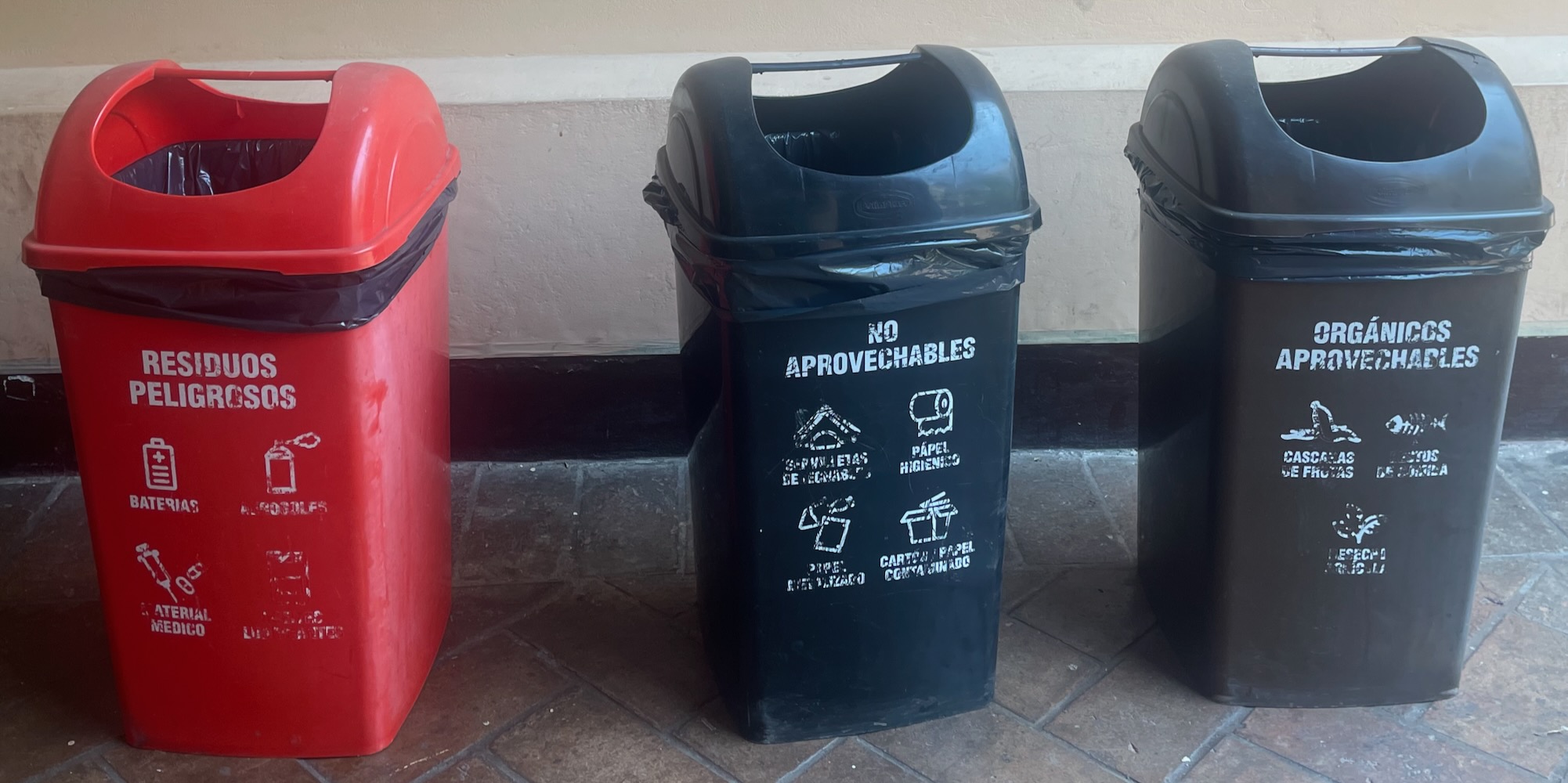
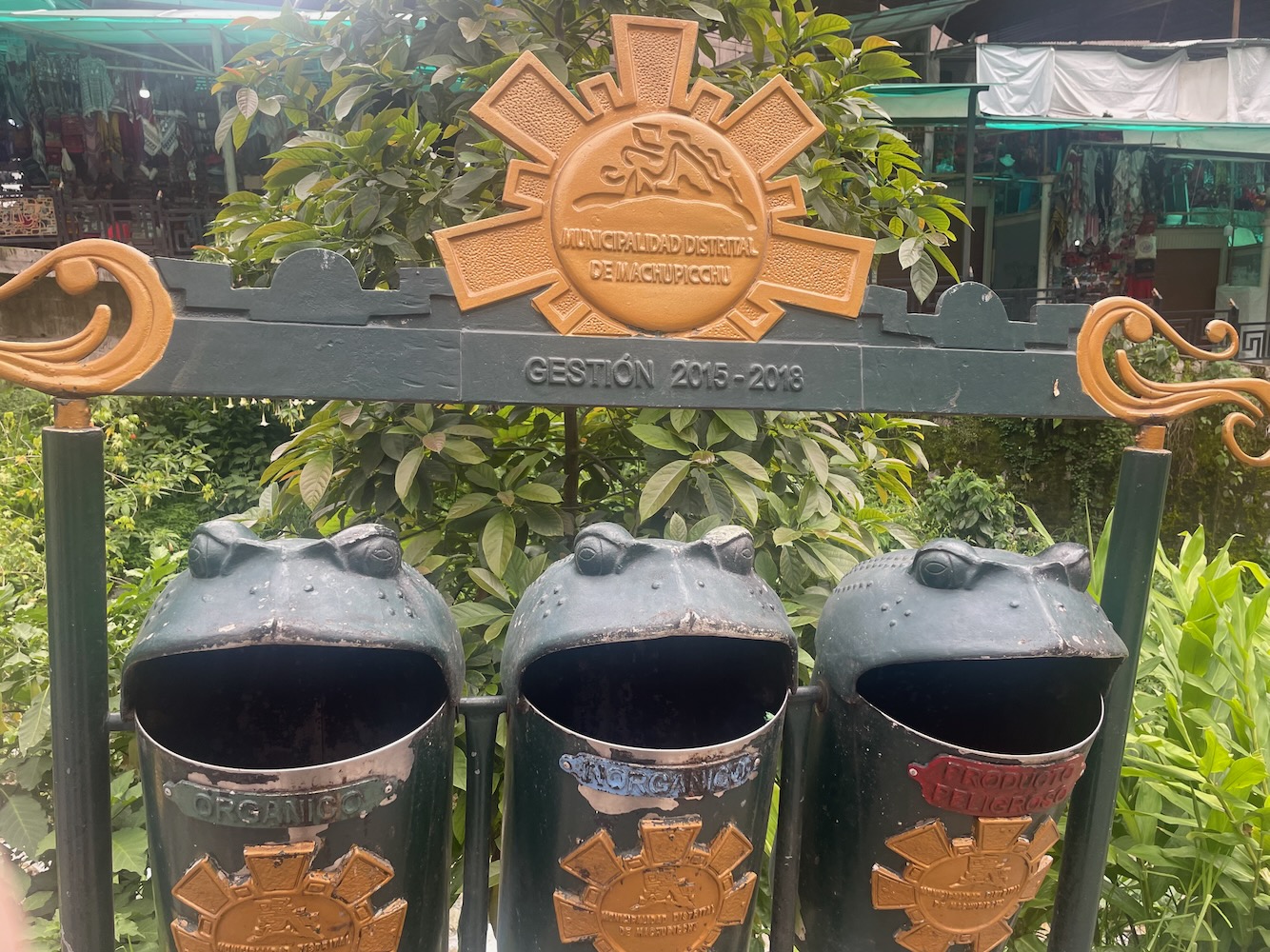
We gathered up Samantha, who had slept a little later to catch up after her day of being sick, and now seemed totally normal. Everyone cleaned up, changed, and packed our bags, depositing them in the lobby at 9:15 and going to breakfast. The hotel people had said they’d bring the bags to the train station for us, in time for our 10:32 train, so we had a leisurely meal, chatting with a family from Miami whose teenage daughter had been wearing the same tee shirt last night as Marcus was today (sharp-eyed Samantha had spotted her—the girl said she gleefully took the shirt from her older brother, and Samantha nodded in agreement at how good a situation that was, and then the girl complimented Samantha’s haircut and color, and everyone discussed the confusing Machu Picchu circuits and the weather, and how wonderful Helen was for making the big hike the day before).
Breakfast included pancakes with large quantities of dulce de leche on the side, and I also sampled coca tea in tea bags (very blah, not worth it). From breakfast, we walked up to the town, unfortunately getting confused about where the train boarded, and just barely finding the hotel guy with our bags, and the train boarding platform, 7 minutes before the train was to depart. Phew!
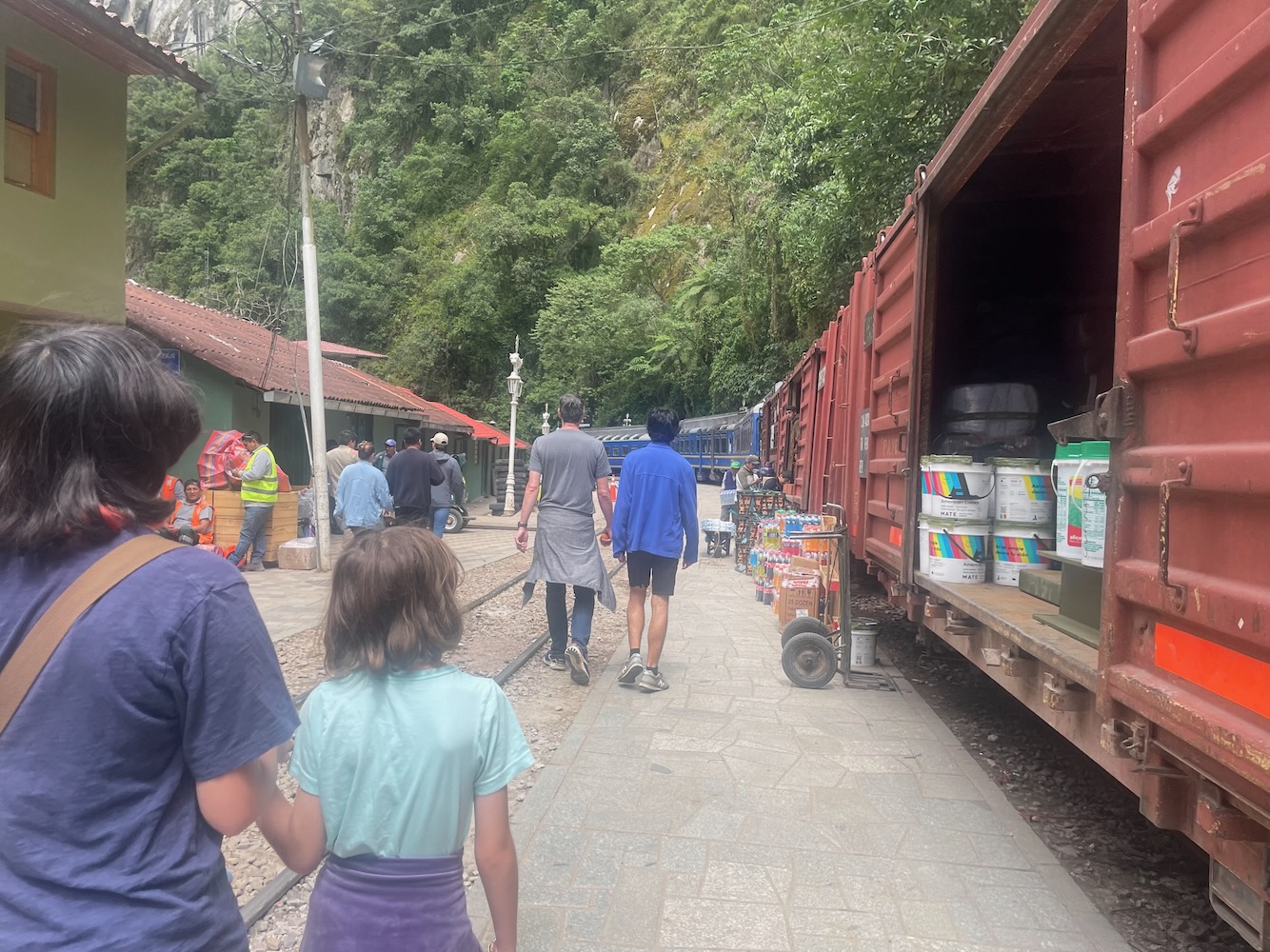
With a train employee (Incarail this time) greeting us by name and implying we were the last five people who needed to board the train, we made our way to our seats. Across the aisle from us was an Austin family of four who had a third grade daughter named Sasha and a cute almost two-year-old boy. We chatted with them, and Helen and Sasha sat next to each other and collaborated on iPad games and exchanged email addresses, as one does, promising to write to each other later on.
There were no musicians and dancers on this train, sadly, but the 90 minutes passed quickly. In Ollantaytambo we changed for the “bimodal service”—that is, we walked a block from the train station to a small parking lot where we boarded a 16-passenger van for the next 90 minutes to Cusco. I had considered, when planning our trip, ending the Incarail tickets in Ollantaytambo and getting a private car to Cusco, but this was cheaper—just about 20 soles per person, above the train fare—and I thought it would be fine. In hindsight, our family consensus is that the splurge of an extra 80 soles ($20) for the private car definitely would have been worth it. Marcus and Robert were sitting crunched up in the back, with Robert on the back wheel, and the girls and I had slightly more physical space but were all fighting carsickness for the entire trip. When we got out on the street in Cusco, my head was throbbing and it felt like a miracle that no one had thrown up.We took an Uber to our hotel, which was a $50/night (including taxes and the splurge of 3 soles per person for a towel) guesthouse, the Eco Aventura Hostel. The woman who ran it was incredibly nice, spoke wonderful English, and took a big bag of our laundry to send out and deliver the next day for 6 soles per kilo. Our room had one queen and three twin beds again, and though not fancy, was huge and very nice.
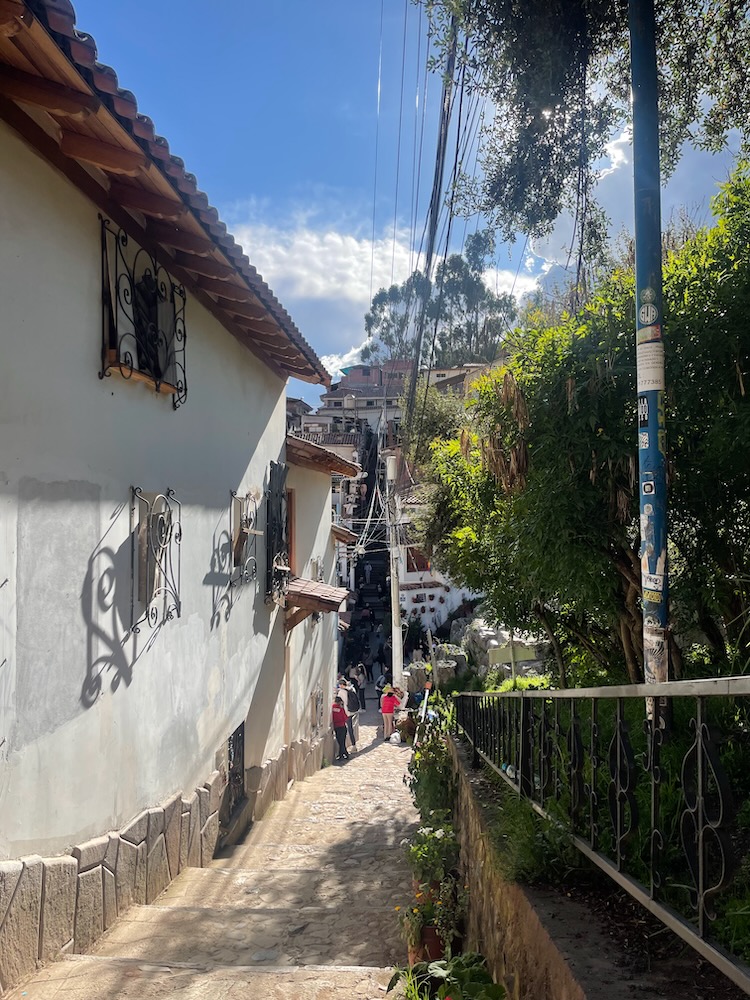
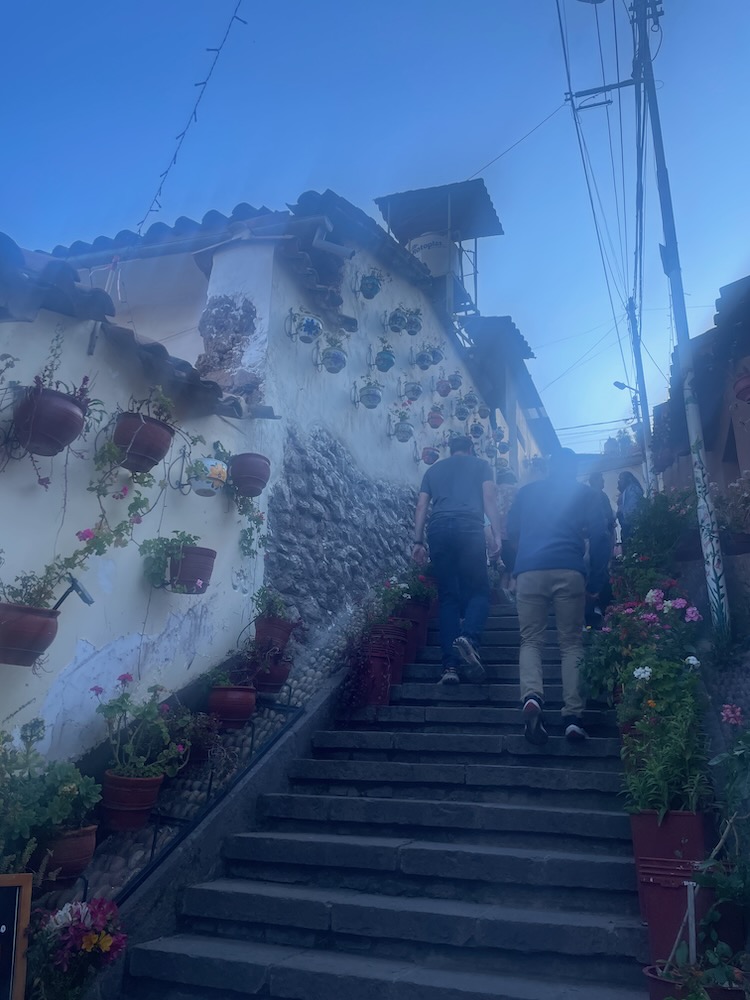
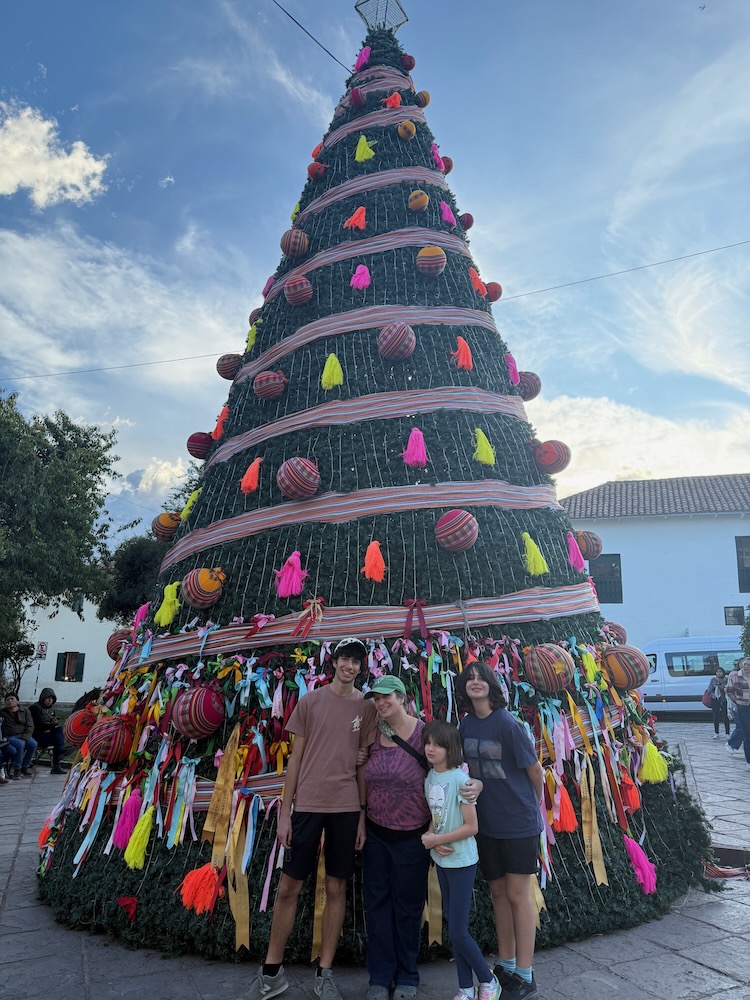
We went out walking to explore Cusco, with our destination of Saqsaywaman, massive Incan ruins above the town. But Cusco is not flat, and now we were at 11,000 feet vs. the slightly lower Machu Picchu, hiking up hills and climbing up narrow stepped sidewalks, and we stopped for paletas for the big kids. Helen was looking really worn out, though, and didn’t even want a popsicle, which wasn’t a good sign. When we got to the lower entrance of the ruins, Samantha and I had been feeling really out of breath and decided we were done. The views of the city were amazing, the dogs walking around were fun, and the air was definitely hard to fill up our lungs with, so we sat on some steps and waited.
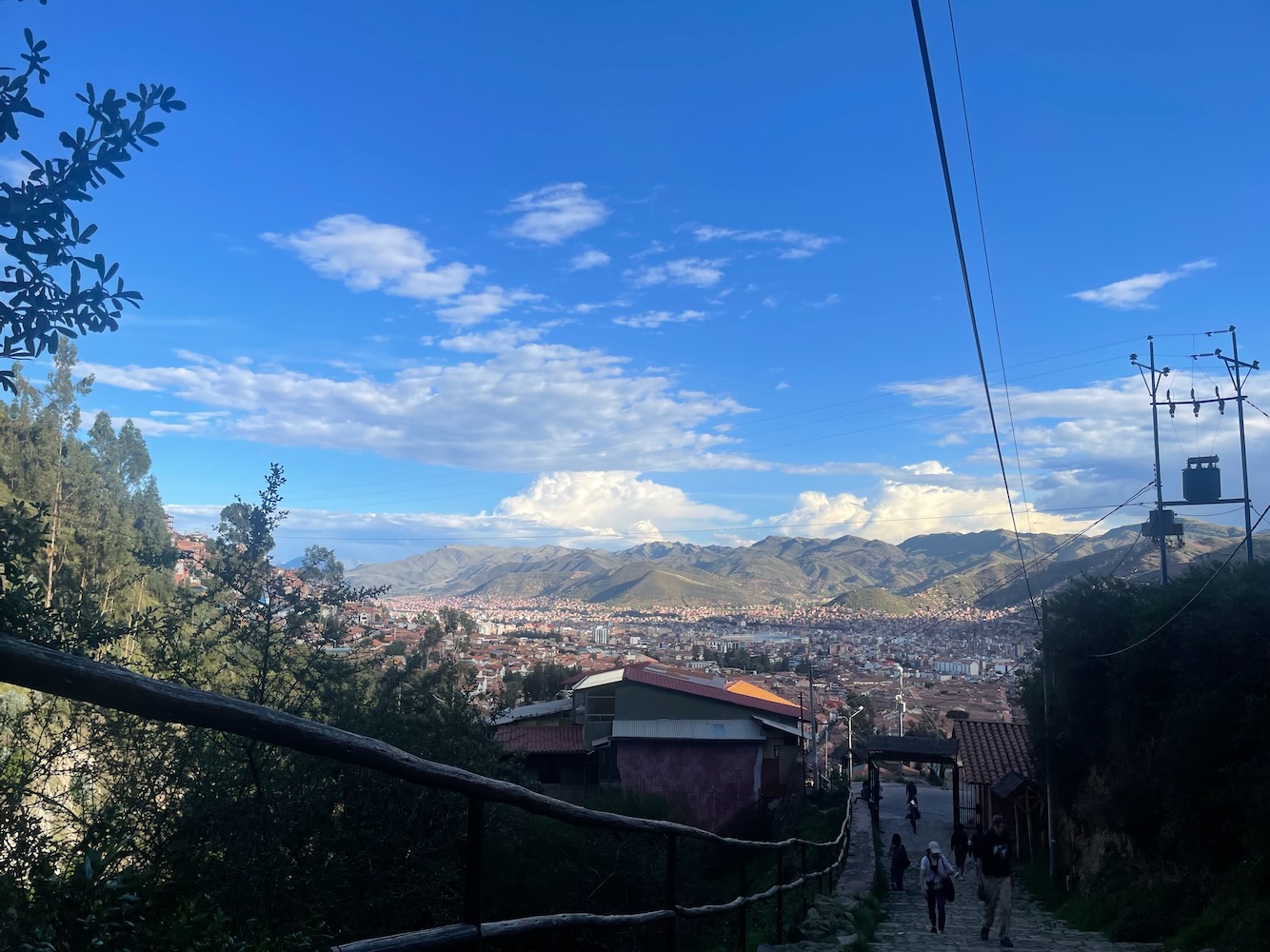
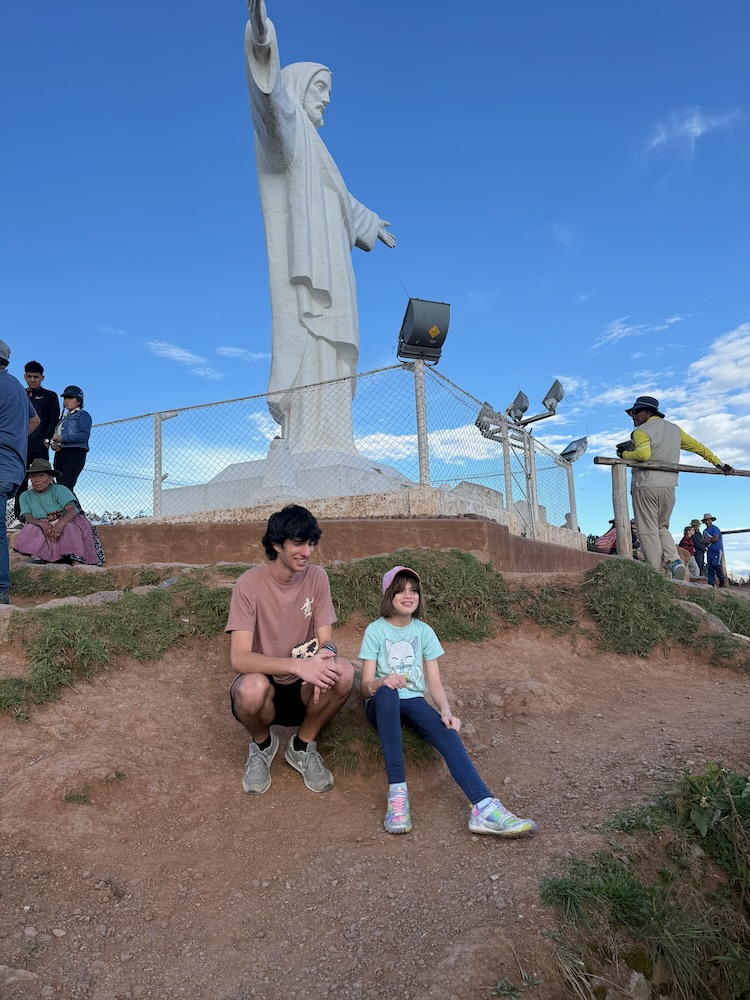
“Just about 10 minutes up past you is a statue, at the top now!” Robert texted back.
Then: “Uh, just kidding. There’s yet another grueling climb.”
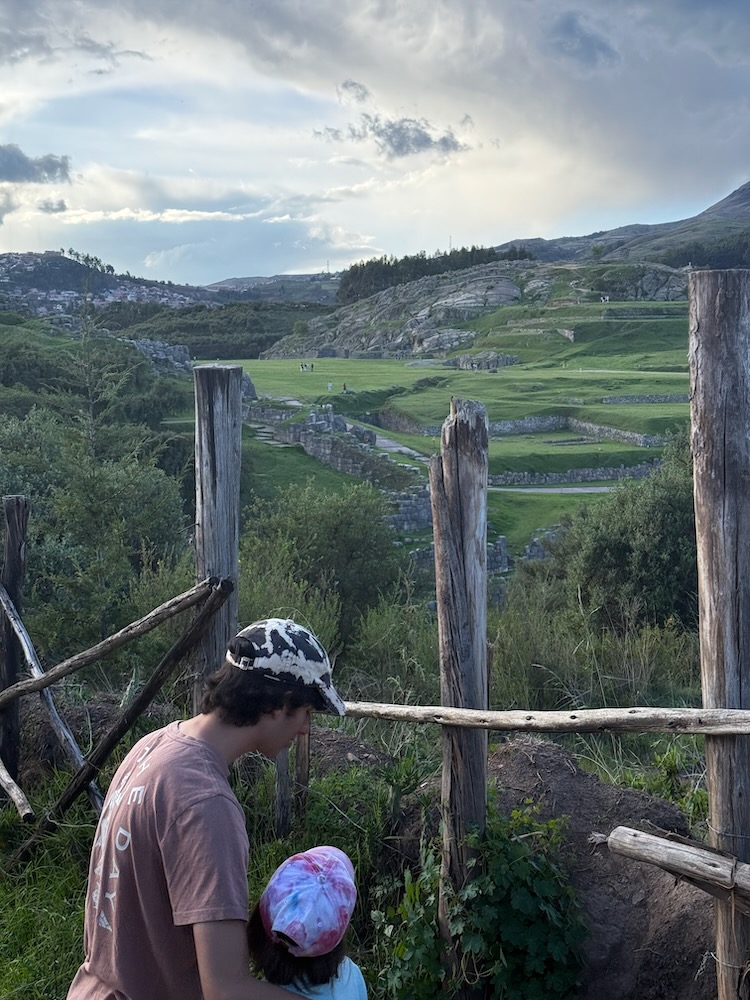
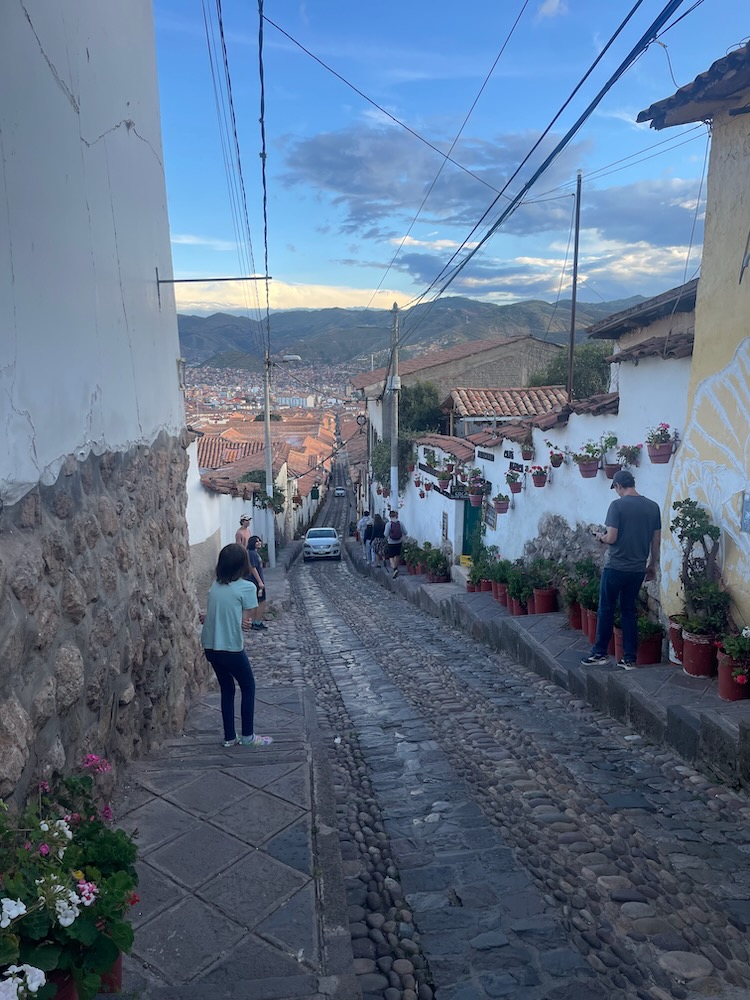
Samantha and I were fine, though—we sat and read a book on the Incas, and very soon after, the rest of our family reappeared again. Apparently Helen had given up before the end of the “grueling climb,” as Robert put it, and wanted to turn around. She was now looking VERY peaked, and we walked downhill through the length of the town to the Plaza Mayor, heading to Mr Cuy, our dinner destination, with Marcus sometimes carrying Helen and her sometimes dragging along at my side.
The restaurant specialized, as you might imagine from the name, in cuy, and we sat down at a table upstairs and ordered cuy al horno con quinoa risotto, plus a lemon trout dish, and another alpaca dish, and Helen was sitting there silently looking pale and managing a sip or two of water. Just after we ordered, Helen excused herself to the bathroom and was sick. When she came back, she looked slightly better and had a sip of passion fruit juice and a bite of trout, and then went back to the bathroom and threw up again. Poor kid—I’m pretty sure the altitude had gotten to her, too. Our cuy had arrived, though—a whole one this time, not just a bit of meat on the side of a plate as in Ollantaytambo—and the restaurant had dressed it—excuse me, her (they told us her name was Juanita)—up very cutely in a poncho and hat, and then took her back into the kitchen to slice her up. Juanita was perfectly juicy and tender, a little like roasted pork in flavor, and was absolutely one of Marcus’s, and all of our, favorites.
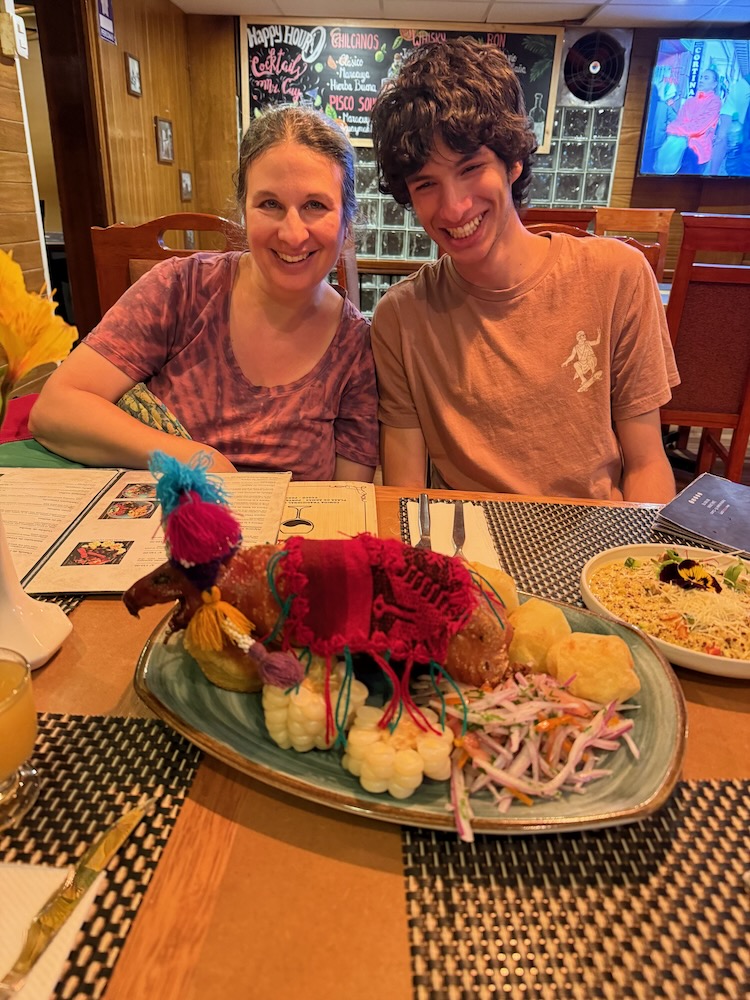
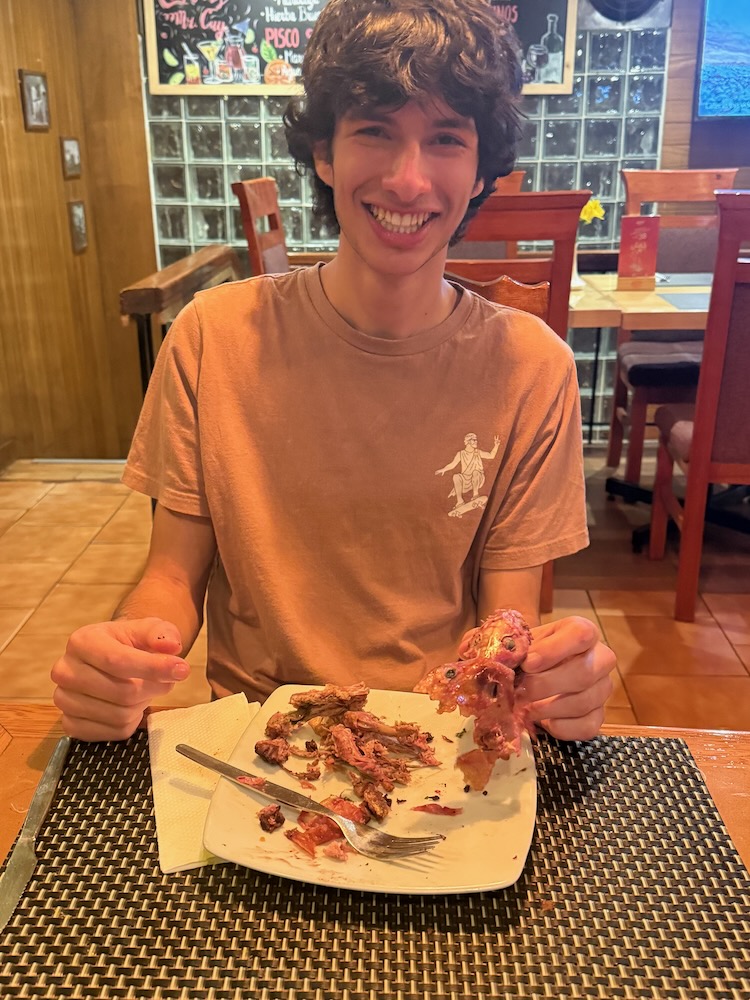
I took Helen back to the hotel in an Uber with a driver who chatted to me about how hot water is the best thing for her with soroche, altitude sickness, and Robert, Marcus, and Samantha ate more chaufa and then poked into an alpaca store, window shopped, and went to a McDonalds for a tres leches McFlurry and also bought sunglasses for Marcus, and more bottled water, on the way home.
Helen slept soundly overnight and was a little woozy and pale, but mostly all right in the morning. Breakfast was scrambled eggs; that round flat bread (6 for 1 sol in the market, we later found out) with butter or jam; coffee, tea, or hot chocolate, and sliced banana and apple. Helen ate a bit of buttered bread and about half a banana, which felt like a good restorative breakfast for her, and Samantha made an egg sandwich for herself, which was also a good breakfast for her.
Helen, Samantha, and I were signed up to do dying and weaving that day. The textile folks (Andean Colors) sent a car and driver to pick us up, and that seemed a lot easier than trying to take a colectivo (bus) out 45 minutes into the countryside. (It’s true that the colectivos in Cusco seem fun, though—the different routes have memorable names, like Batman or Speedy, rather than numbers or letters, and the bus monitor stands by the door and shoves people in or out at their stop. Still, it felt a bit overwhelming for now.)
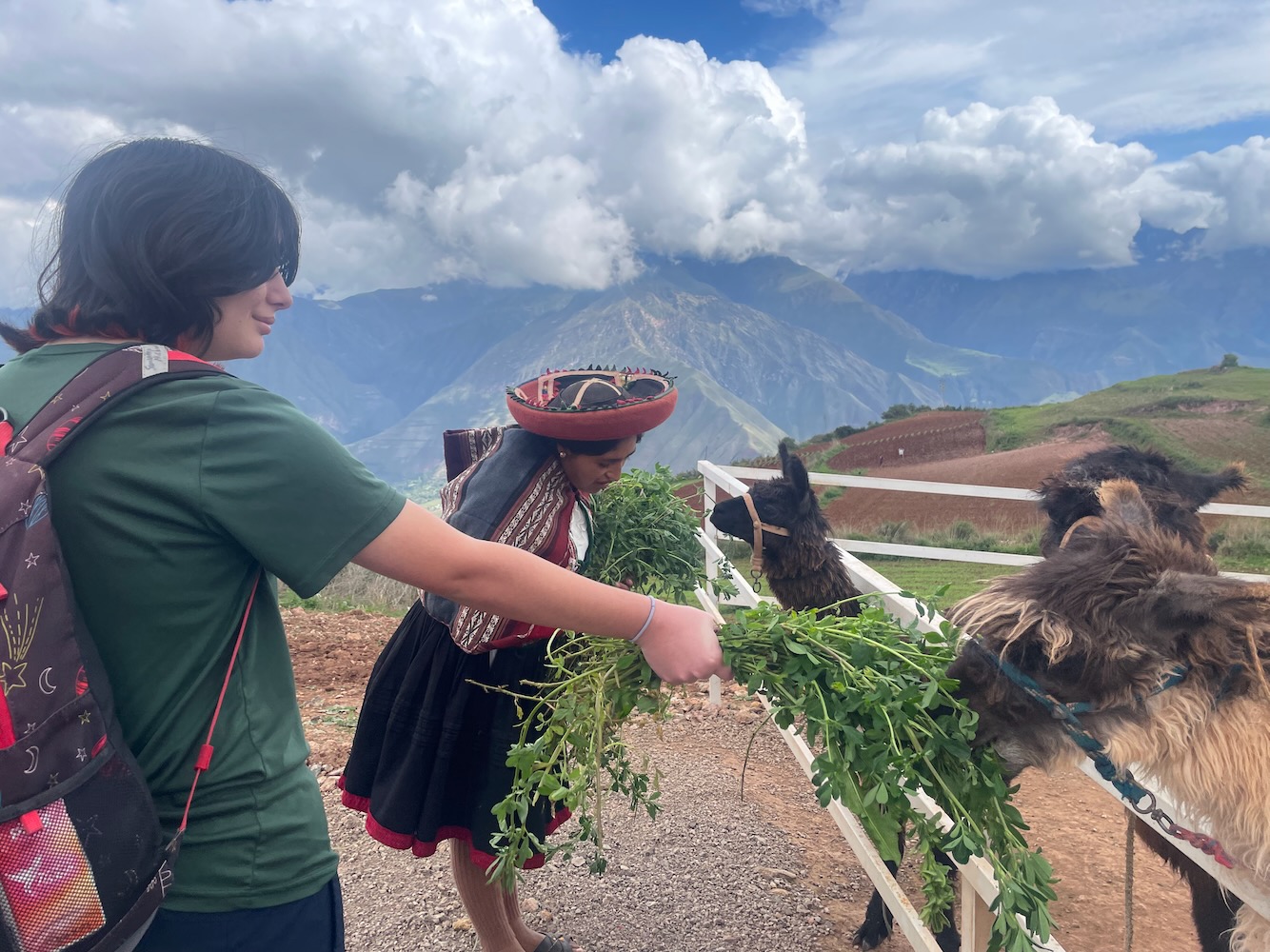
Once we were at their property, on a hill past Chinchero, overlooking Urubamba, the first part of the excursion was feeding alpacas alfalfa.
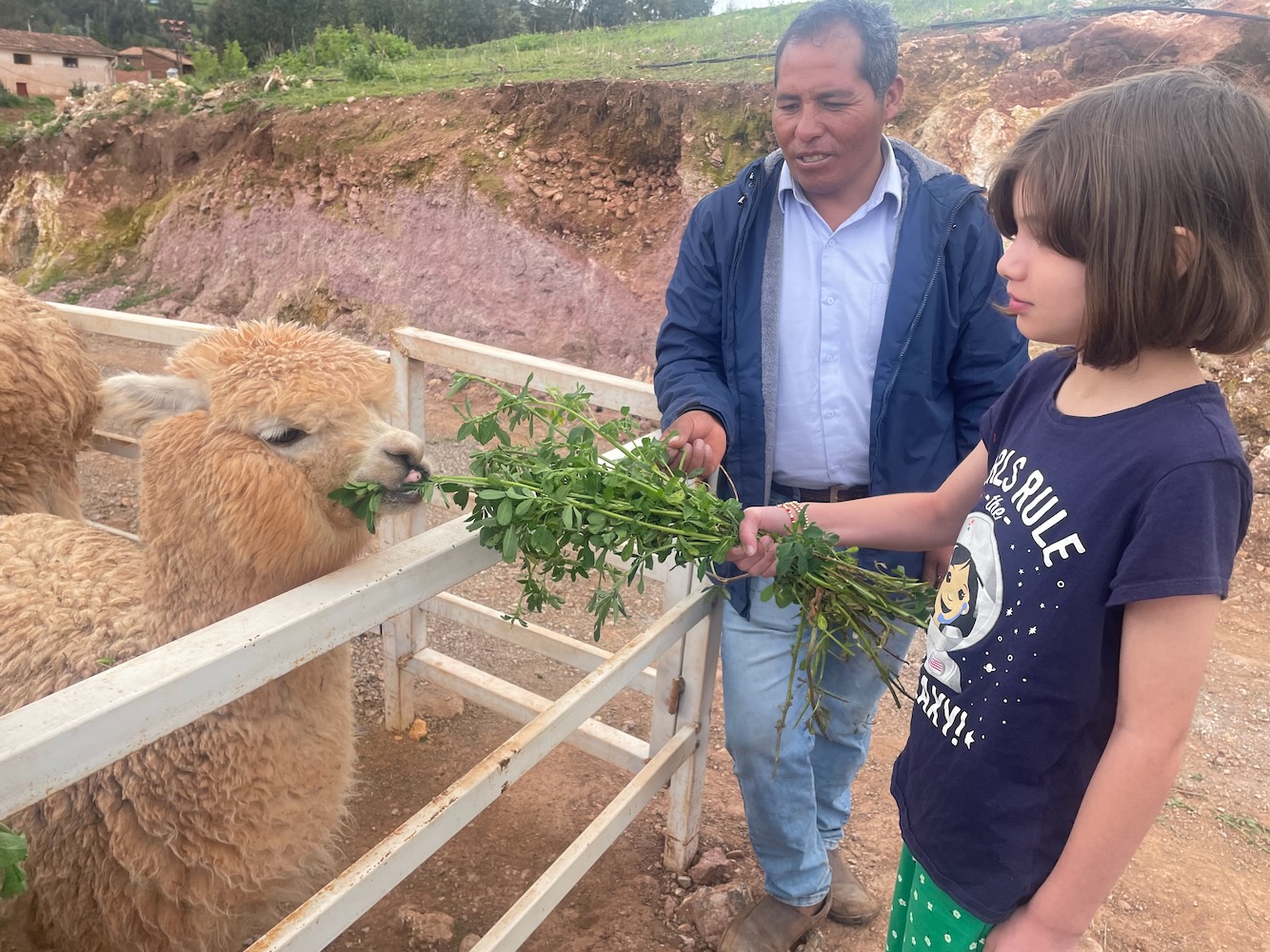
Then we learned about the different Quechua garments and how men vs women tie their carrying cloths, and trying them on, and then hiked down about 15 minutes of the Inca trail to a nice overlook, then back up and into the dye studio. Helen’s alpaca was named Bambi and was adorable.
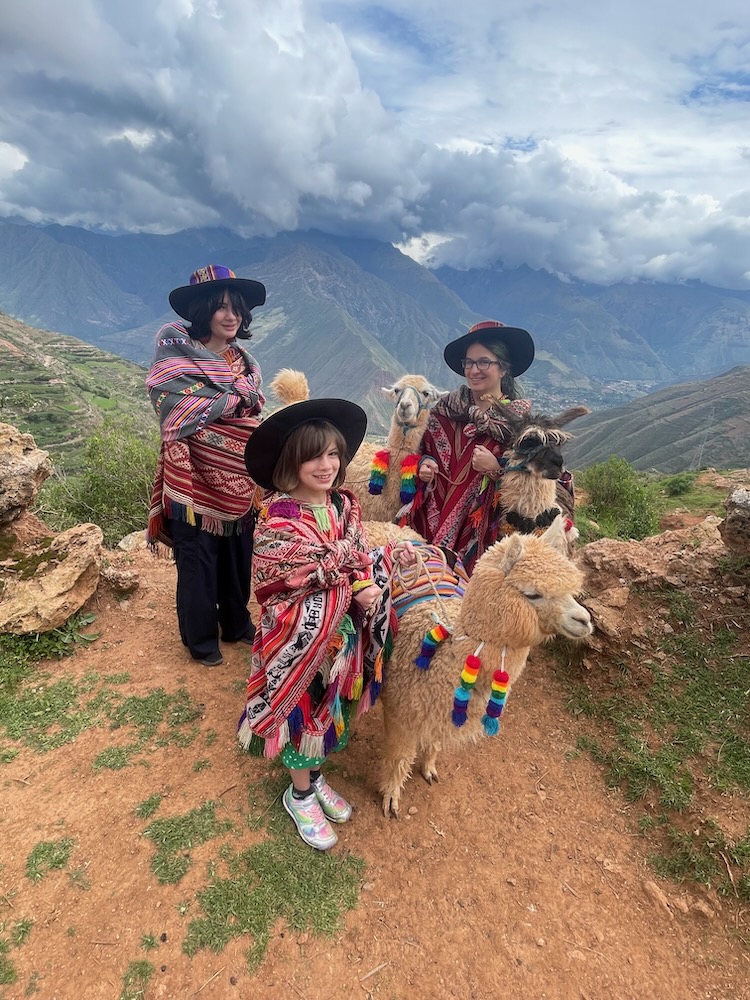
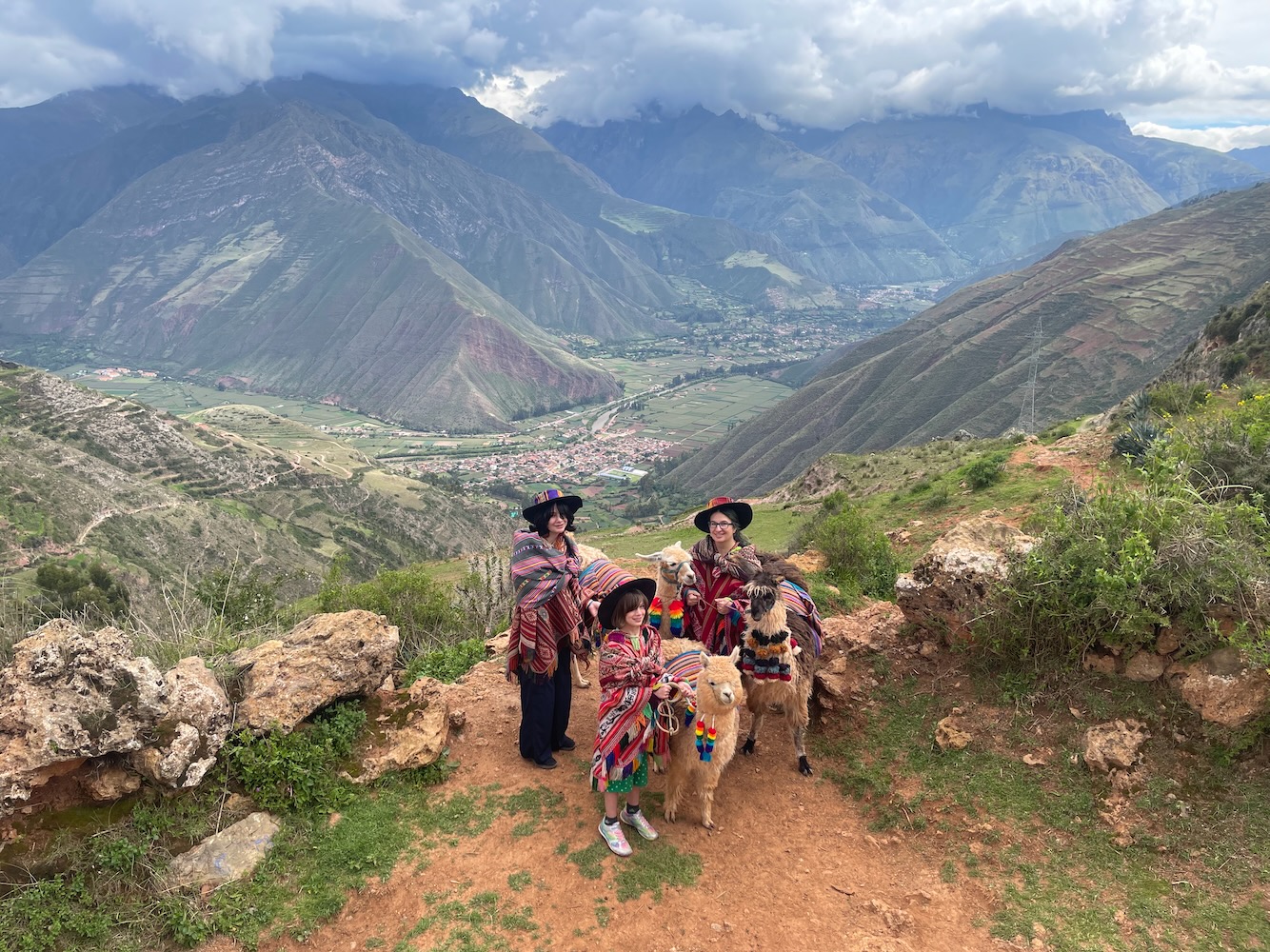
Mine was Tomas, and was a bit strong-minded. Samantha forgot the name of her (pregnant) alpaca, but also was pretty focused on not stepping in alpaca, sheep, pig, etc. poop while walking, so I’ll forgive her.
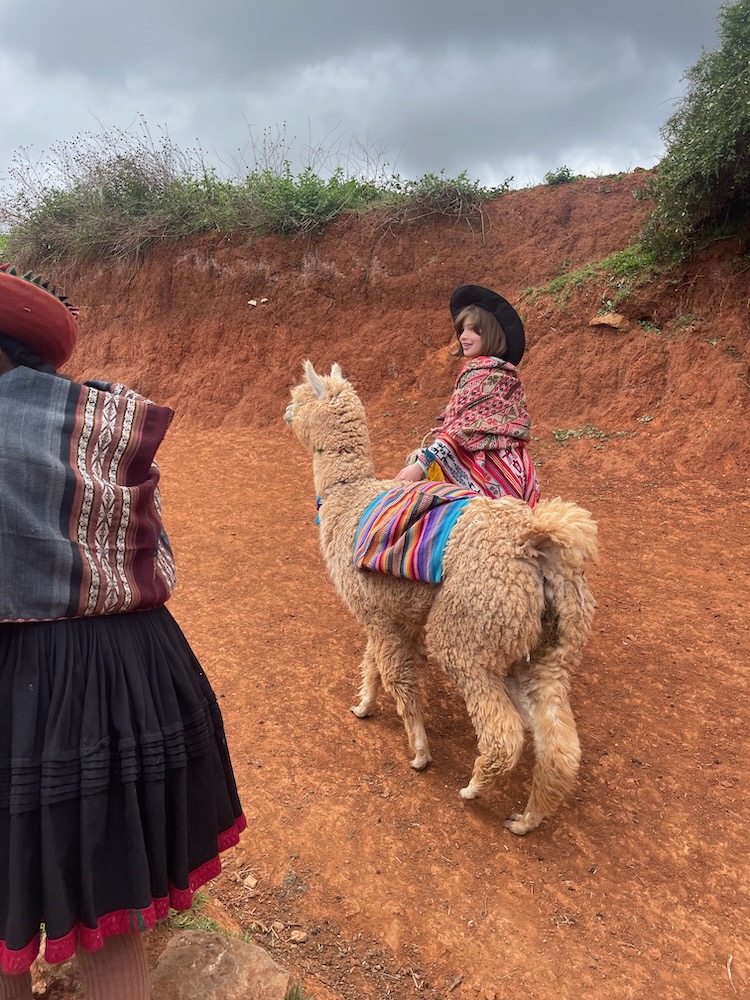
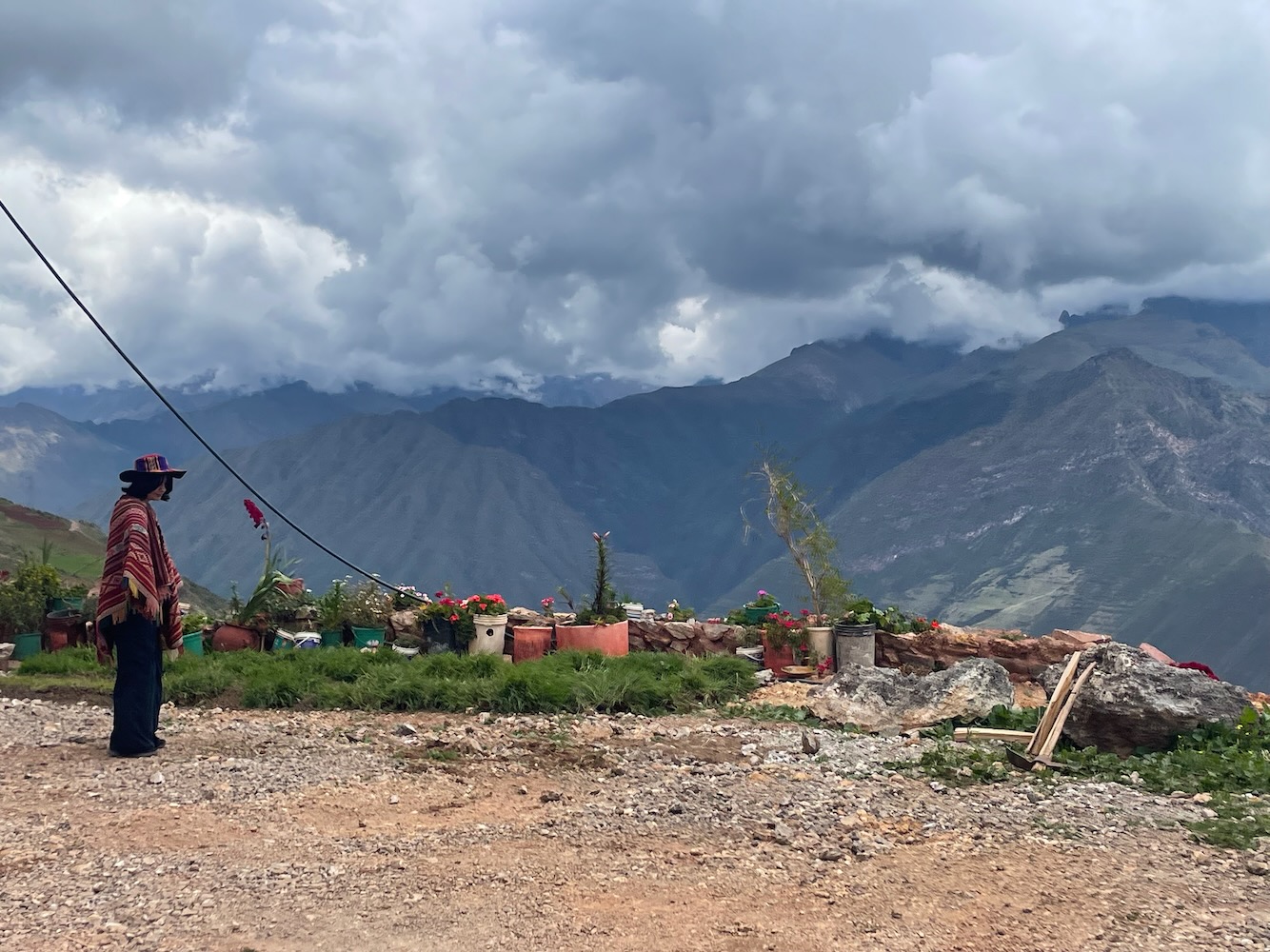
Andean Colors is a coop made up of single mothers, doing traditional crafts and using all traditional dyeing methods, and selling their stuff and also offering tours. We pounded moss into a paste to make yellow dye, and simmered leaves for green, and he picked beetles off a cactus leaf and put them in Samantha’s hand and crushed them and then added different mordants…lime, etc.—and showed how they made a total of 11 different colors on her hand, including the border colors.
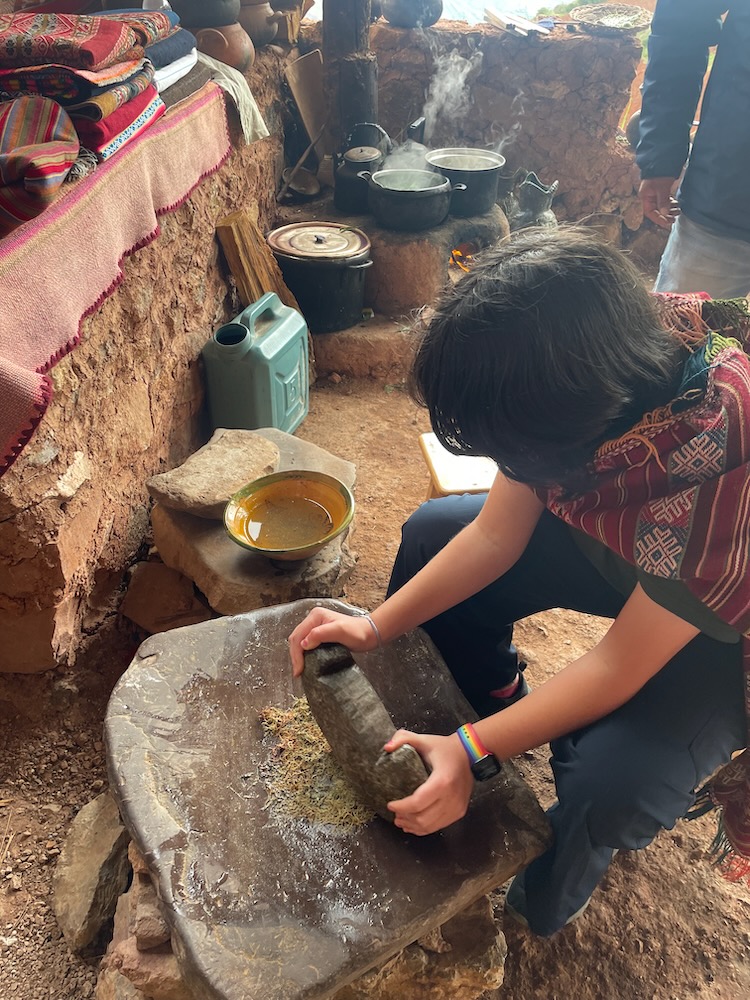

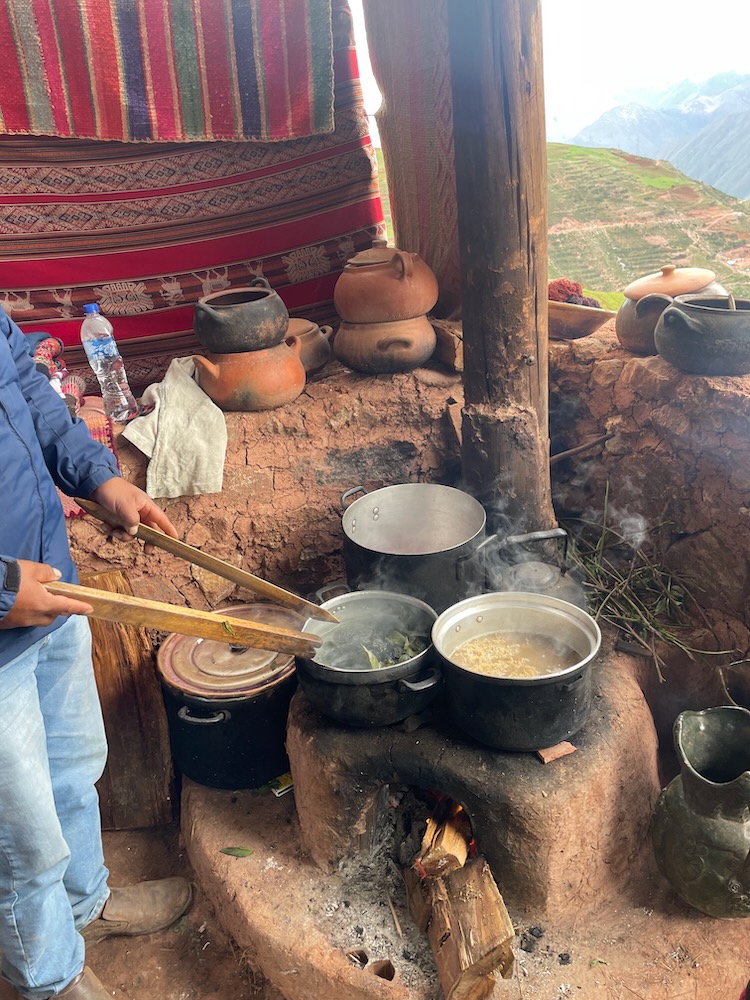
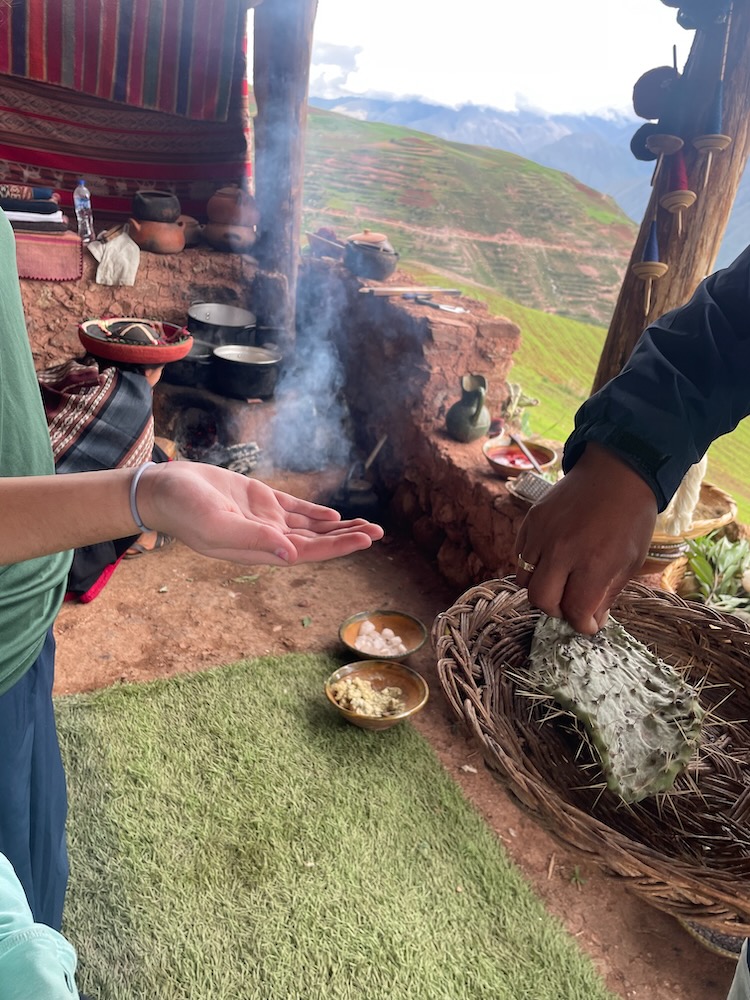
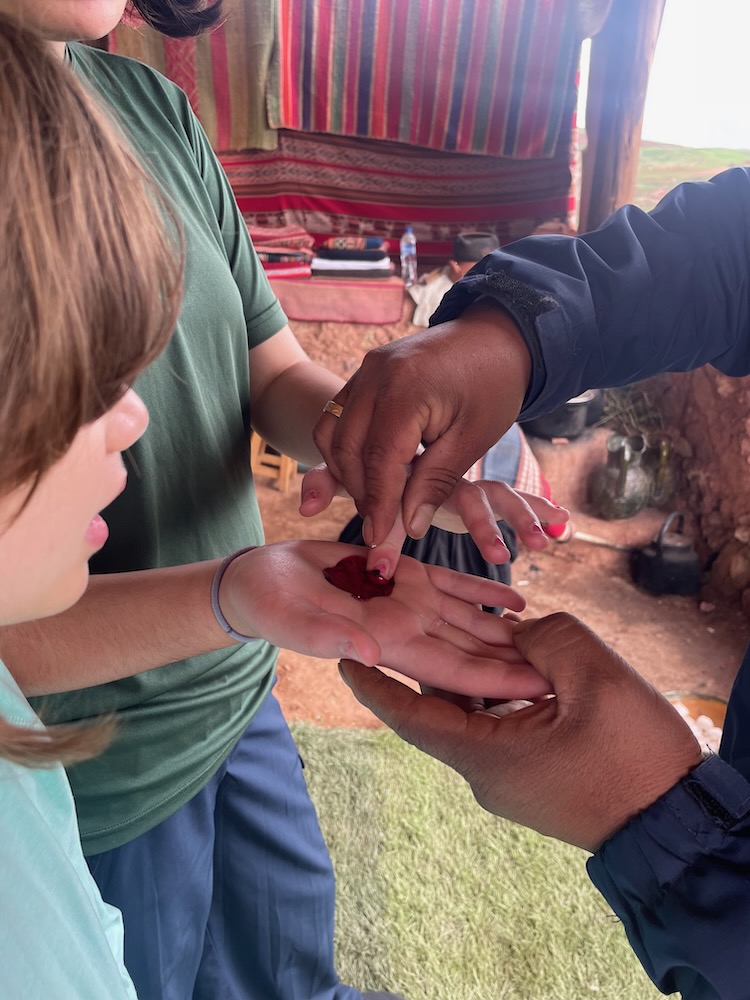
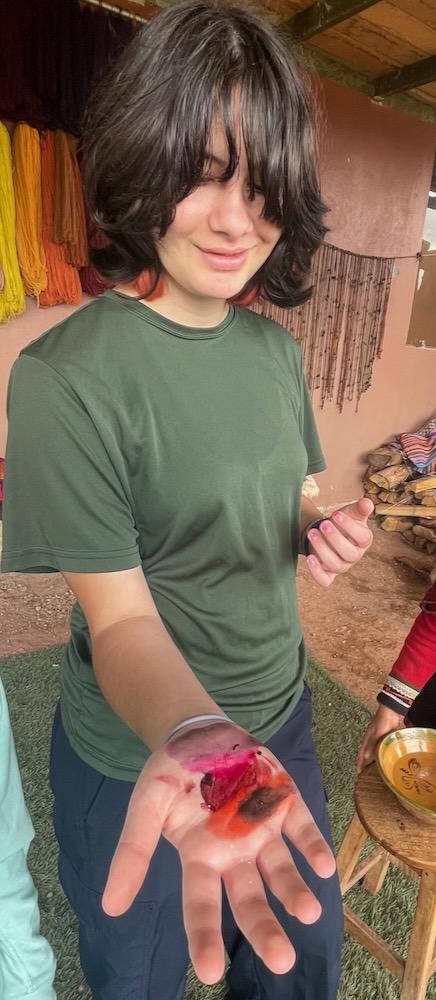
Then we washed wool using saqta, a natural “shampoo” made by grating a yucca-like root, and then used drop spindles to spin it. The yarn we were dyeing had been washed and spun previously, and we used beetles to make pink as well, and then we wove bracelets (using previously dyed yarn) in the same technique as is used on ponchos and blankets, and ultimately we got to take our dyed yarn home—I am sure each of us is thinking about the perfect plans for it!
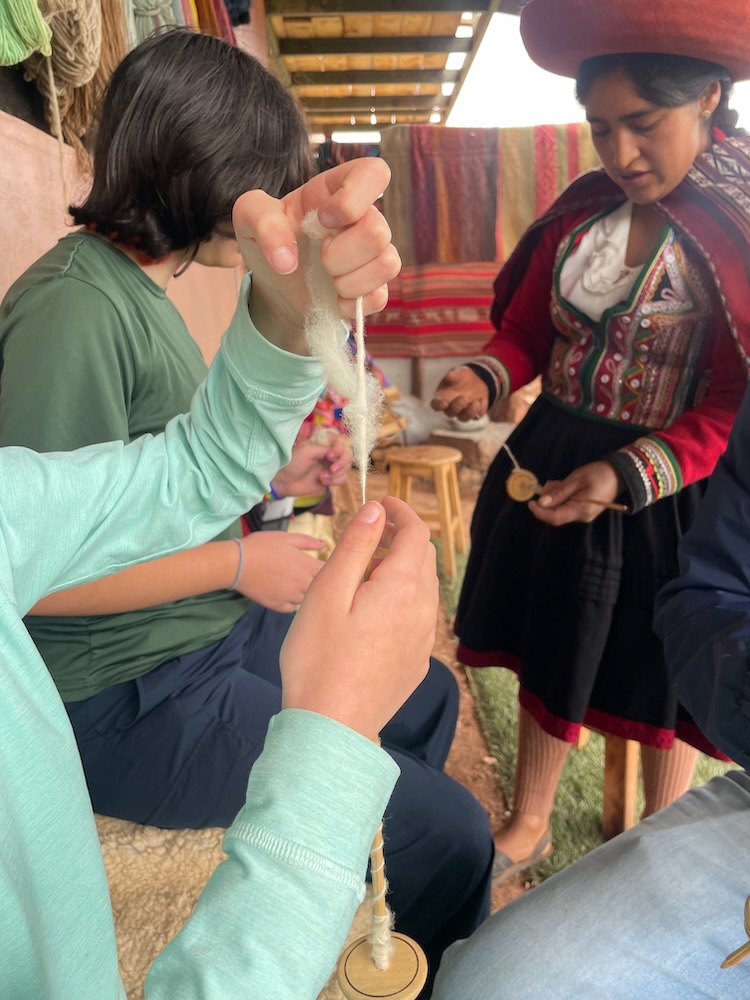
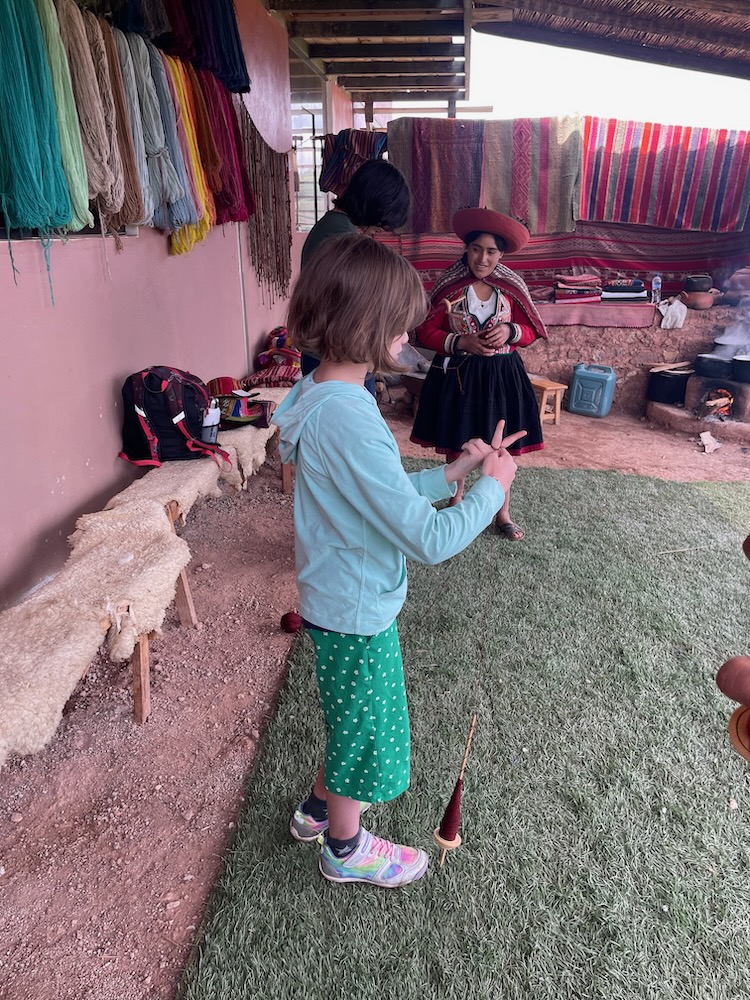
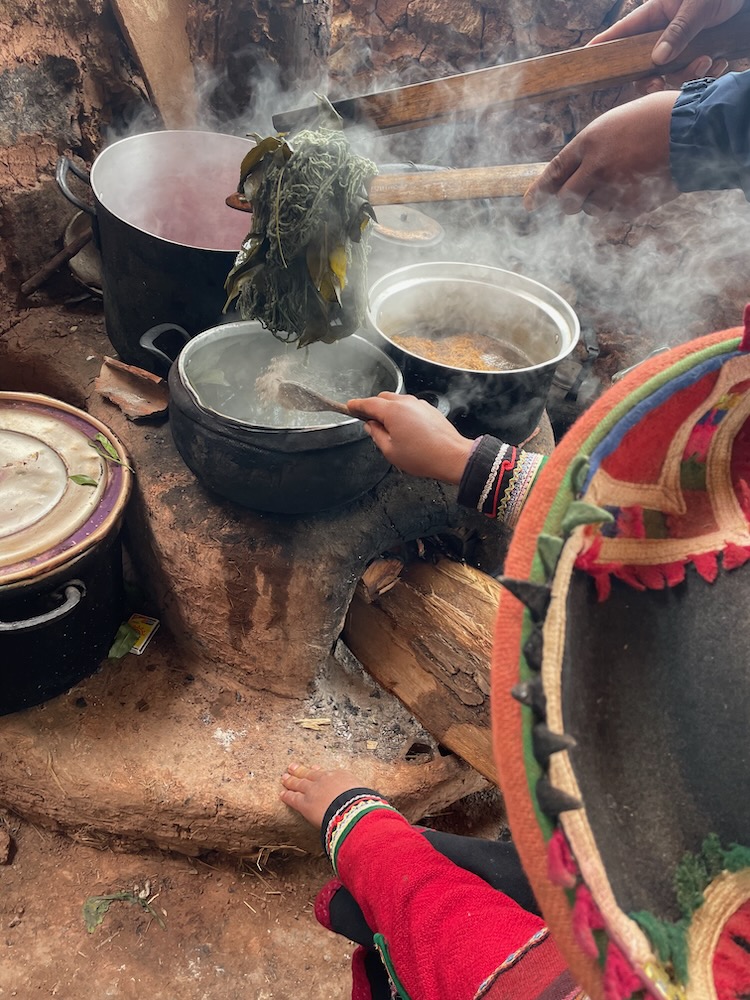
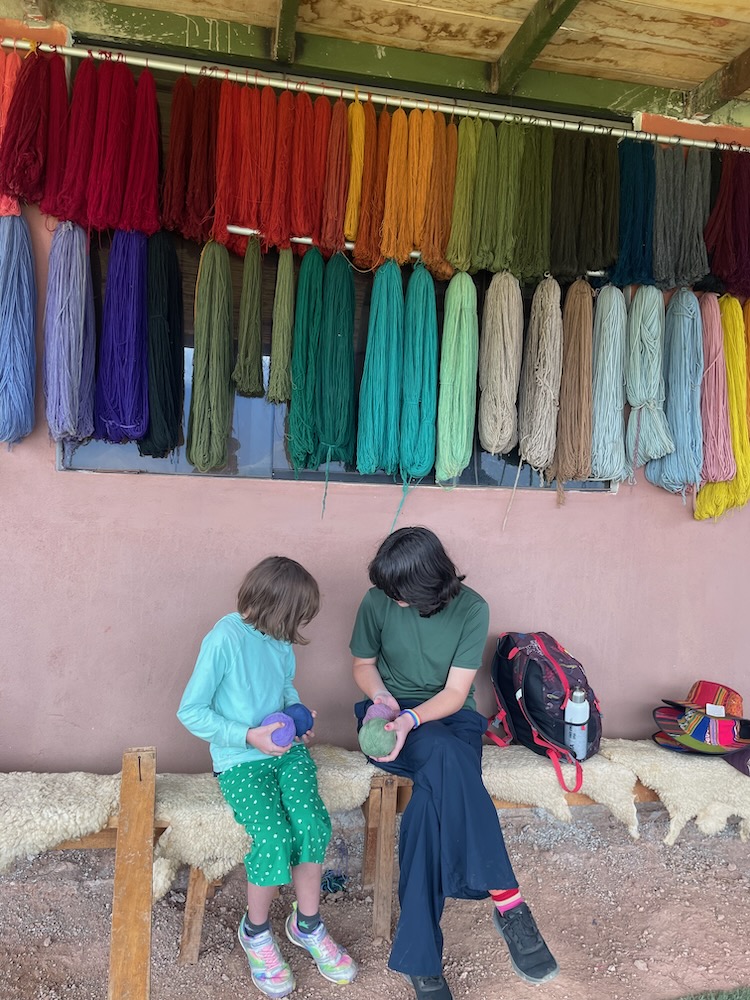
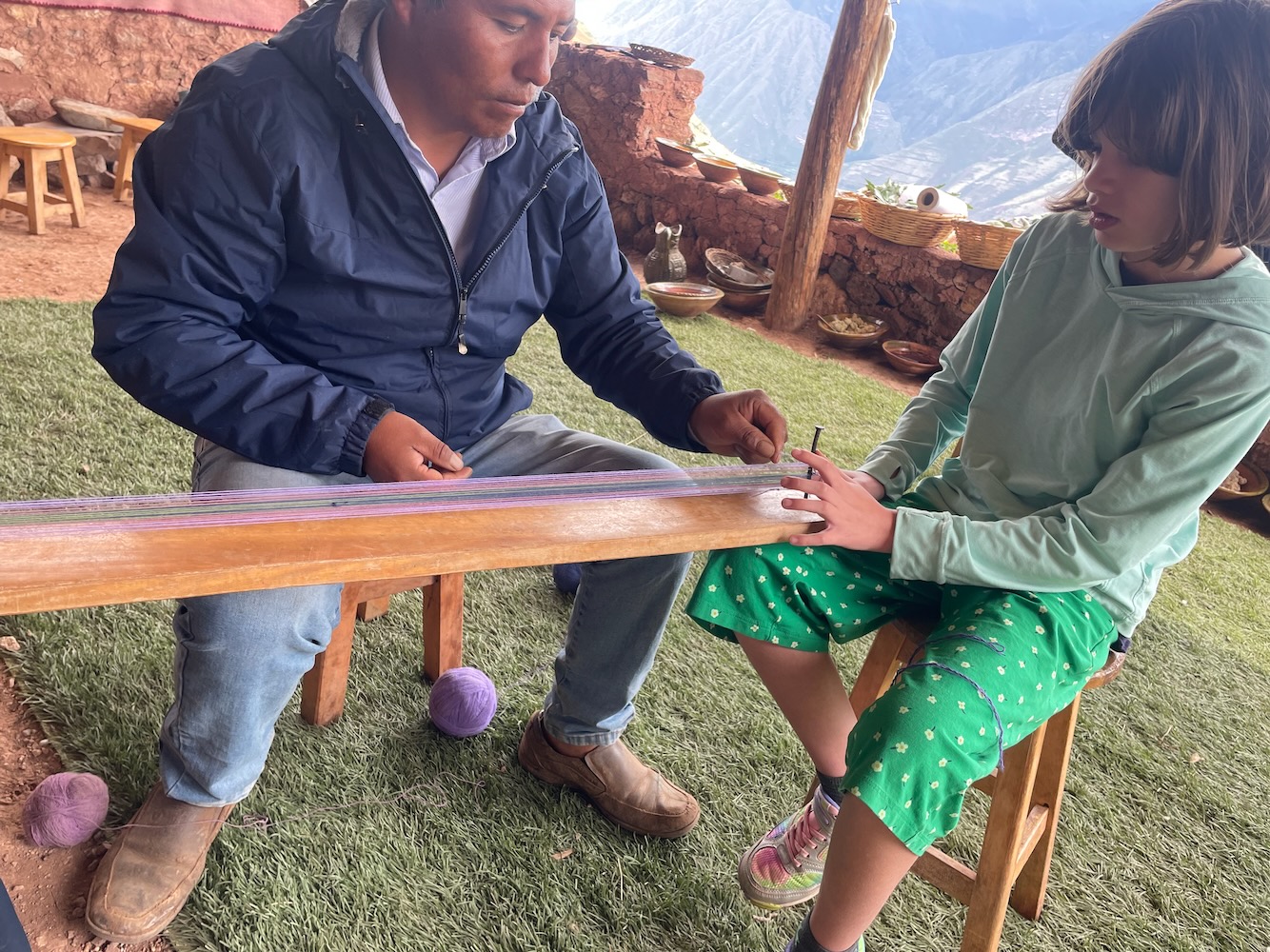
It was an excellent morning. They gave us lunch, too, a chicha morada (purple corn drink with pineapple) and a quinoa veggie soup and then pollo saltado con rice. Helen adored the soup and ate almost two whole bowls of it, and I liked it a lot too. The chicha morada here was warm, rather than room temp or chilled, and a little heavier on the cinnamon, and I liked that a lot too. Helen seemed totally recovered, which was nice, and both girls really enjoyed themselves.
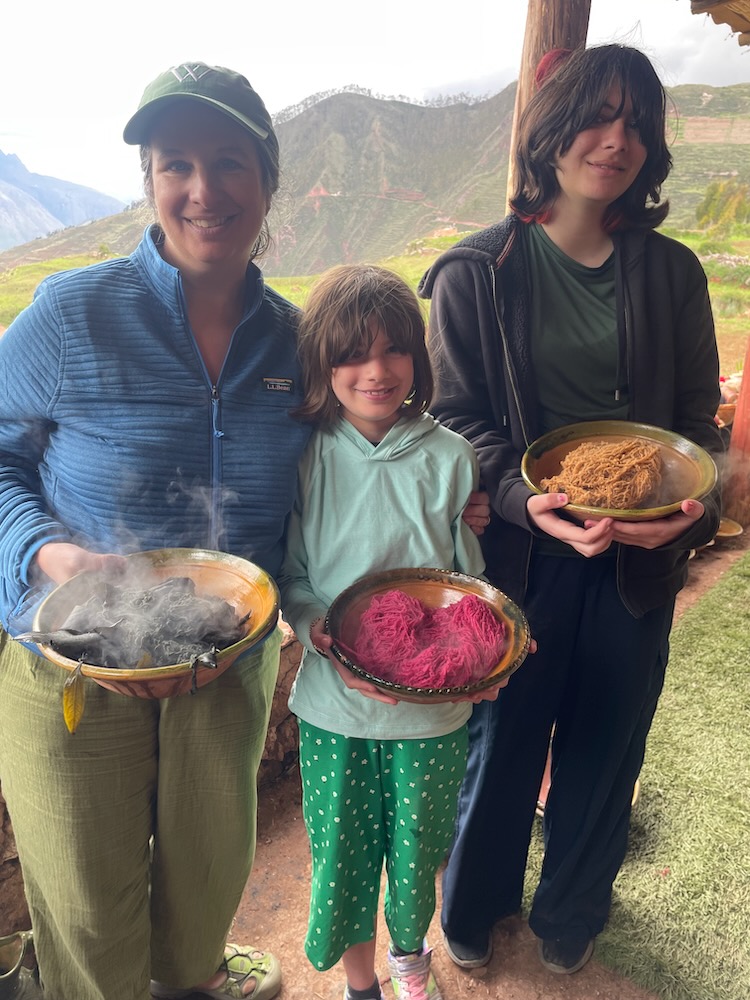
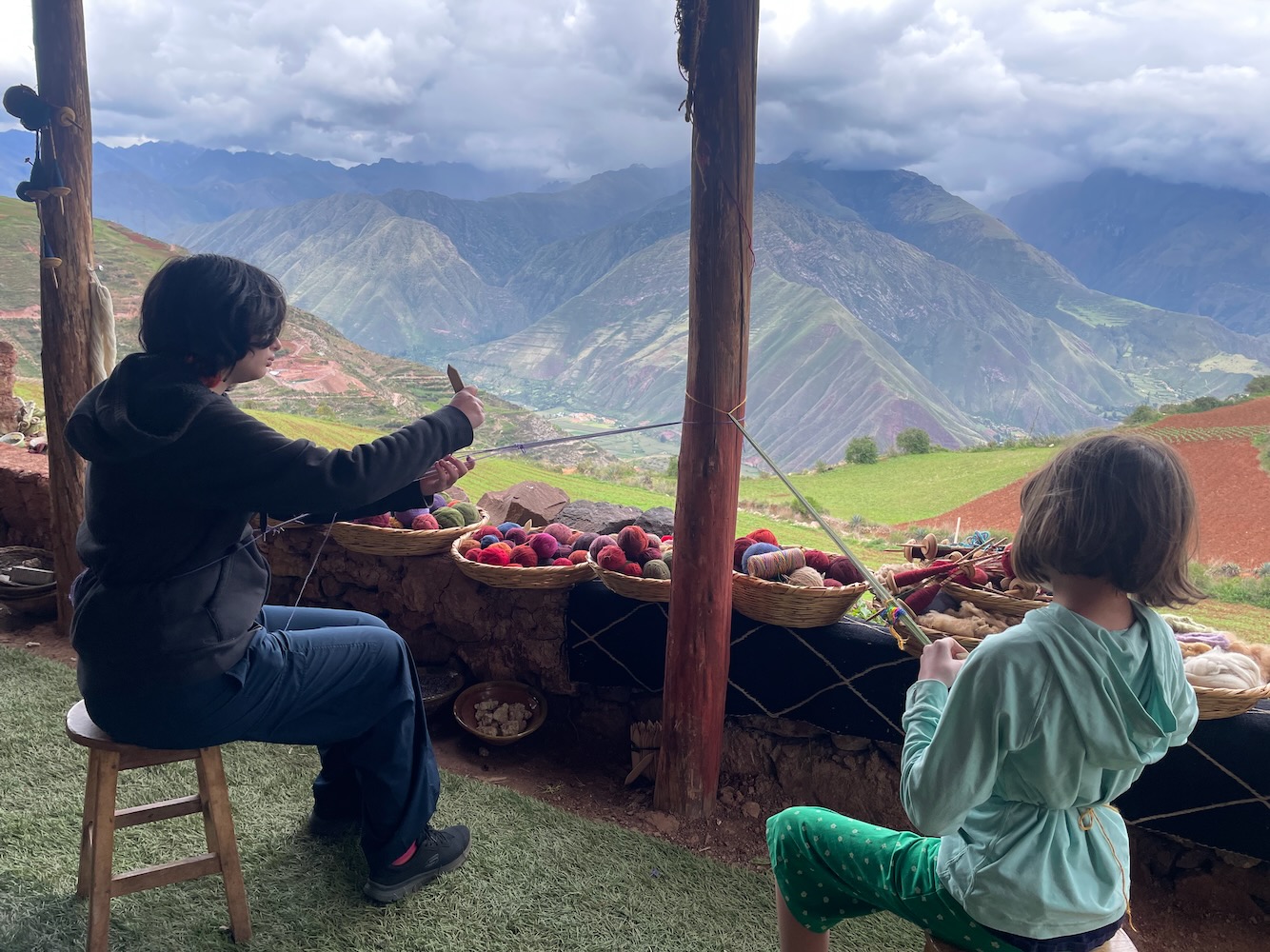
Throughout the day, we chatted with the two main people (Marco y Paola) a lot. Spanish is all of their second language, since their first is Quechua, so I was communicating great in Spanish but then when they spoke to each other I at first thought whoa, they must really have been slowing down and being extra easy on me…until I realized no, they’d switched languages entirely.
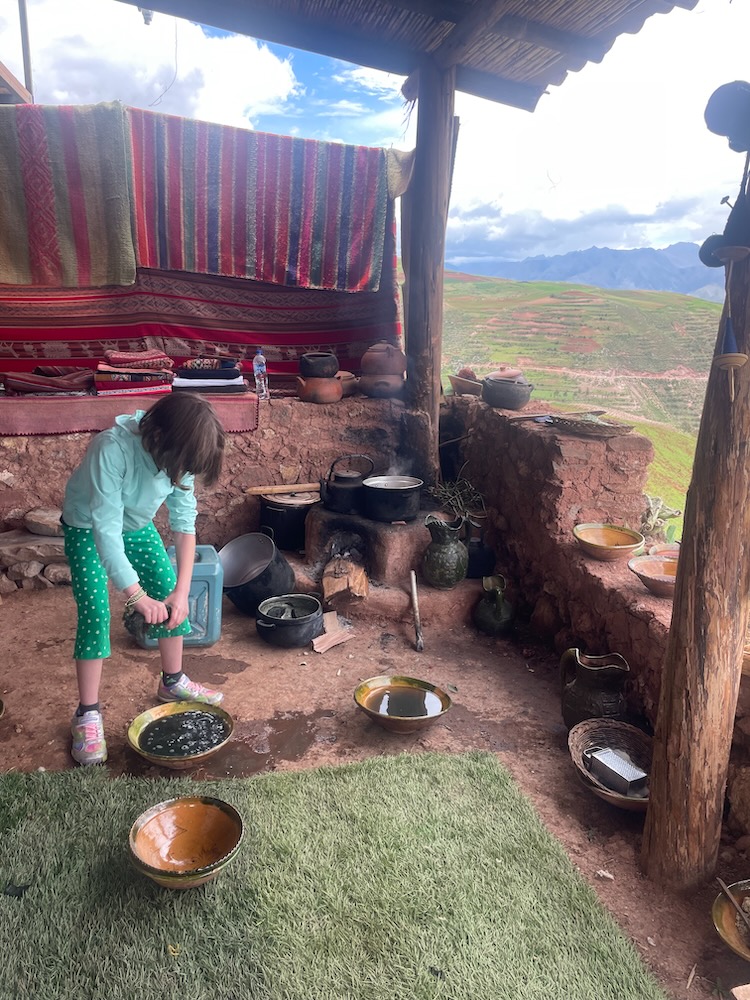
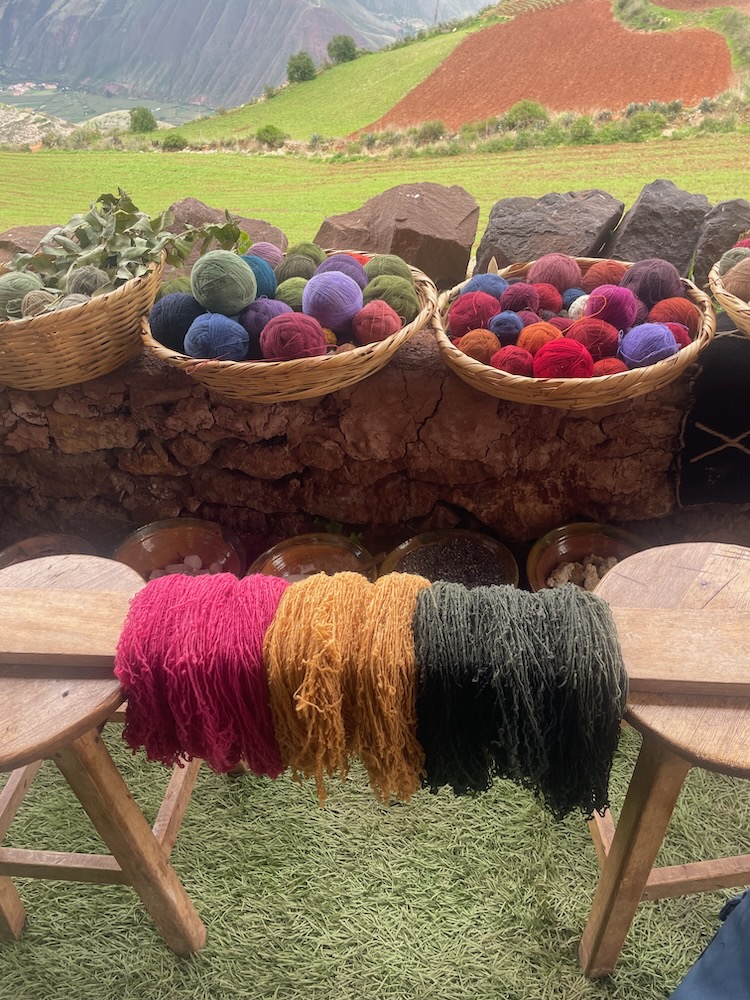
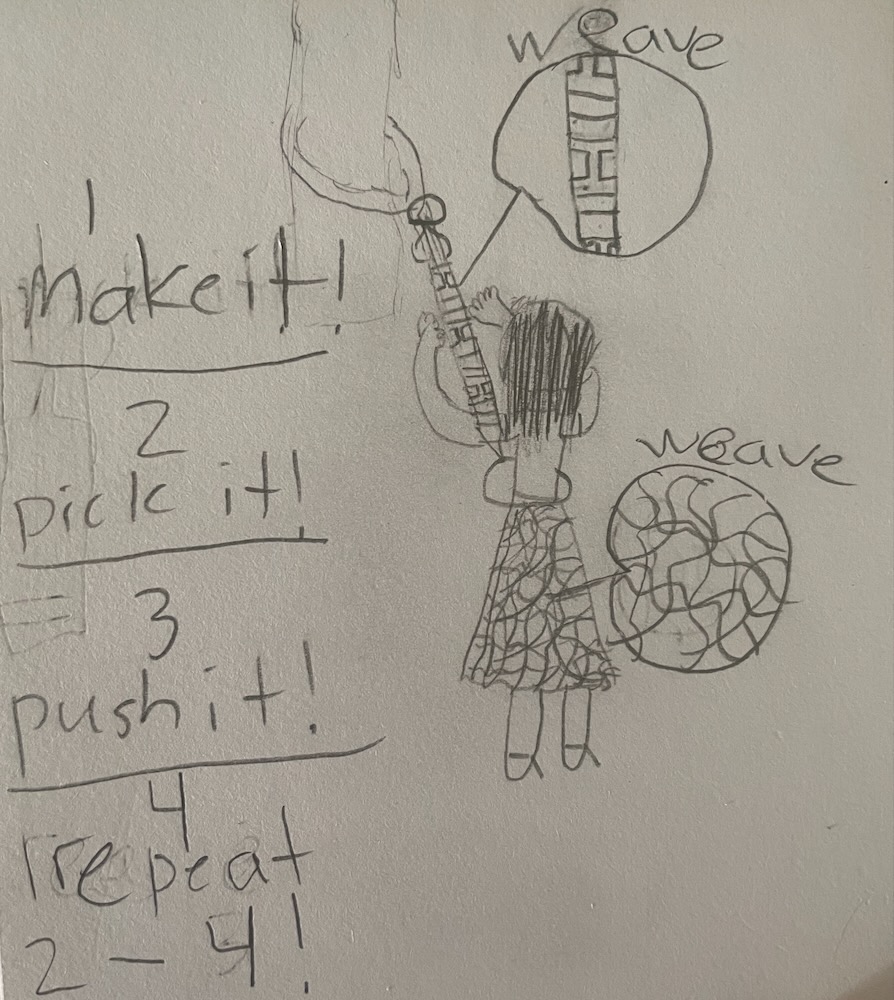
After lunch we bought two little stuffed guinea pigs made from baby alpaca wool, which seemed like a fun combination of iconic Peruvian animals, and also a long string of wool Pom poms in the rainbow colors of Cusco’s flag to hang up at home.
more...
Go back to web essays.
robertandchristina.com
was made with a Mac.
© 2025 C&R Enterprises
Email christina@robertandchristina.com
or robert@robertandchristina.com
Created: 1/05/25. Last Modified: 1/05/25.